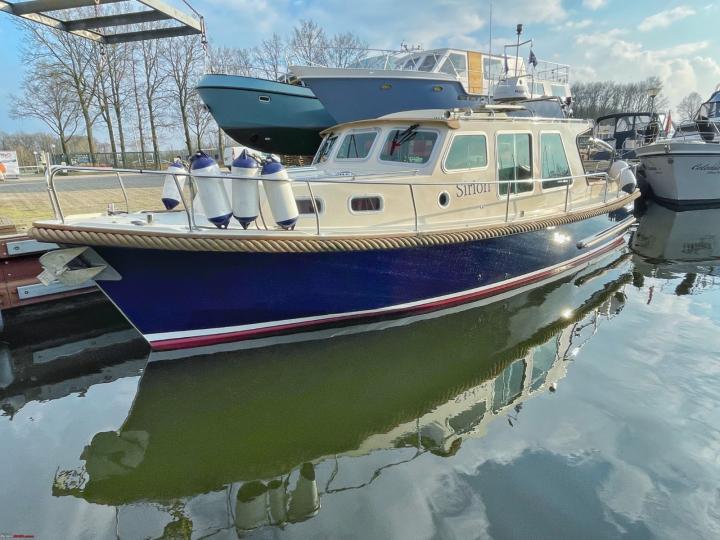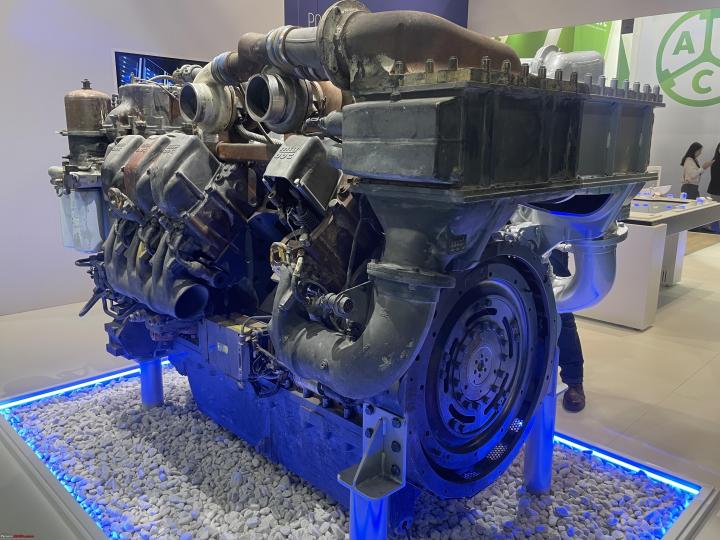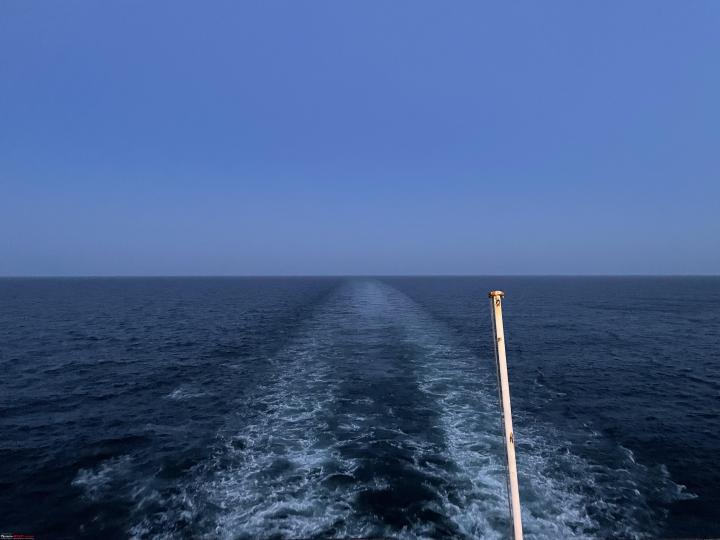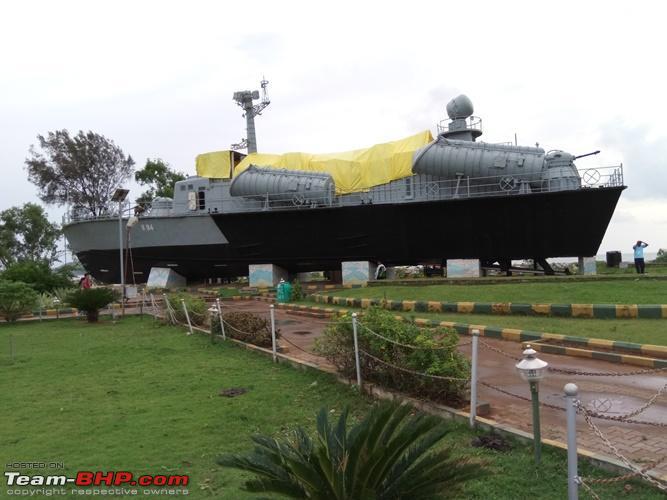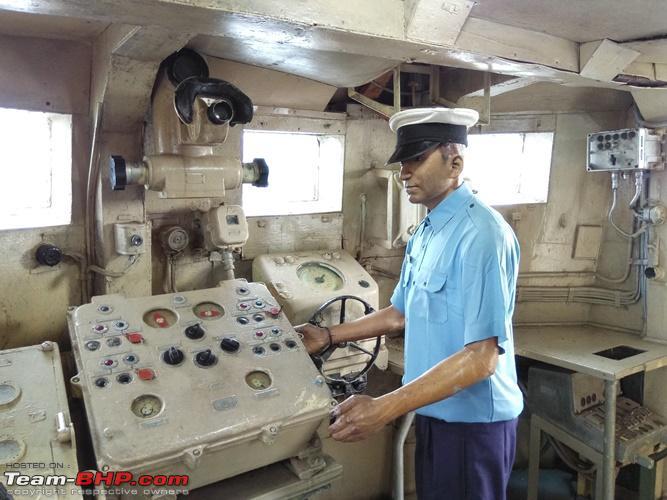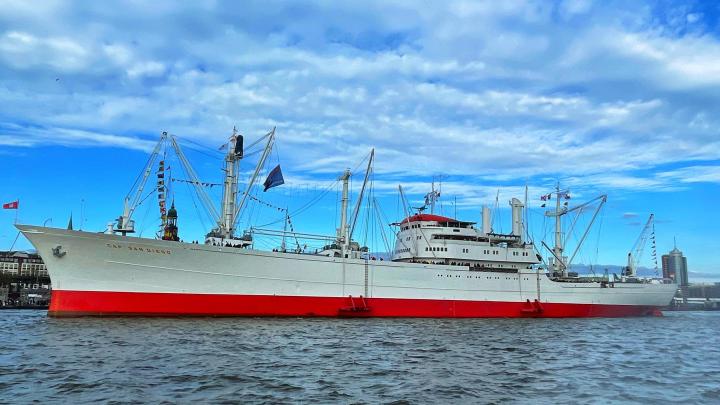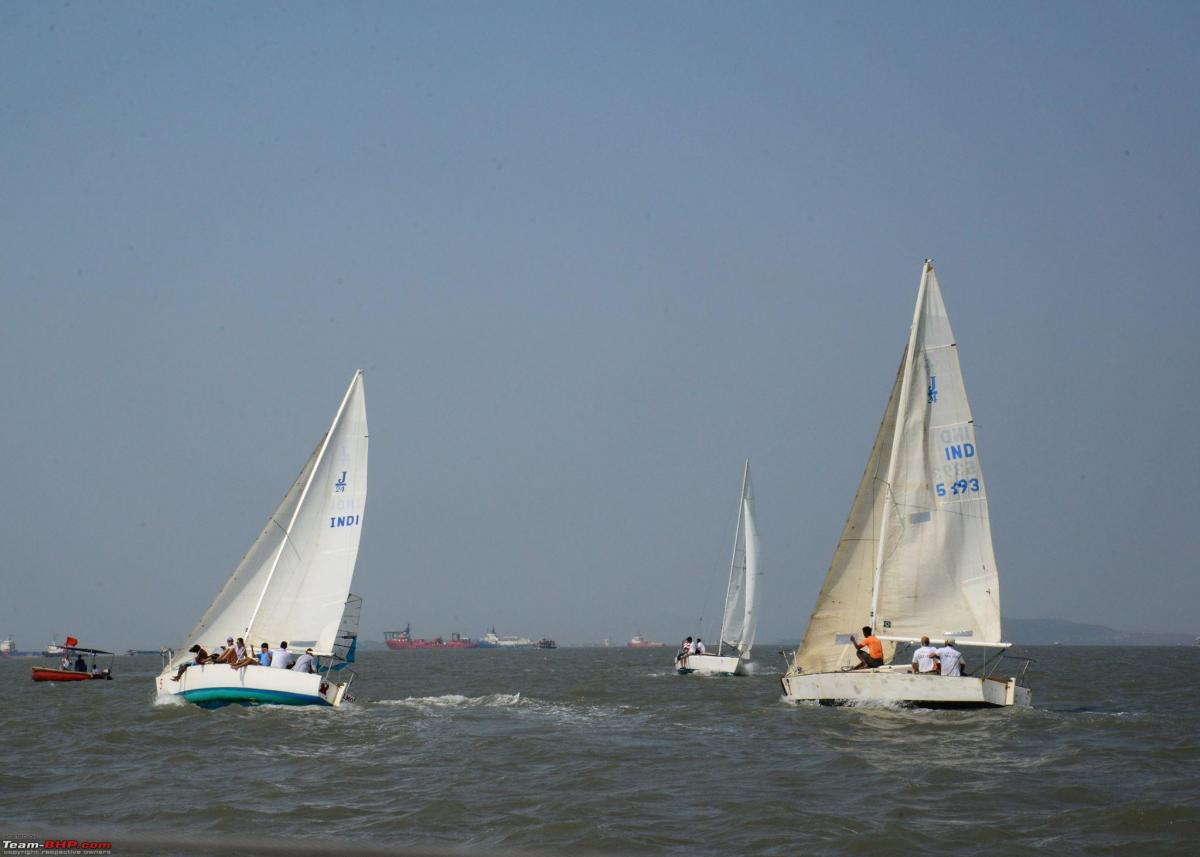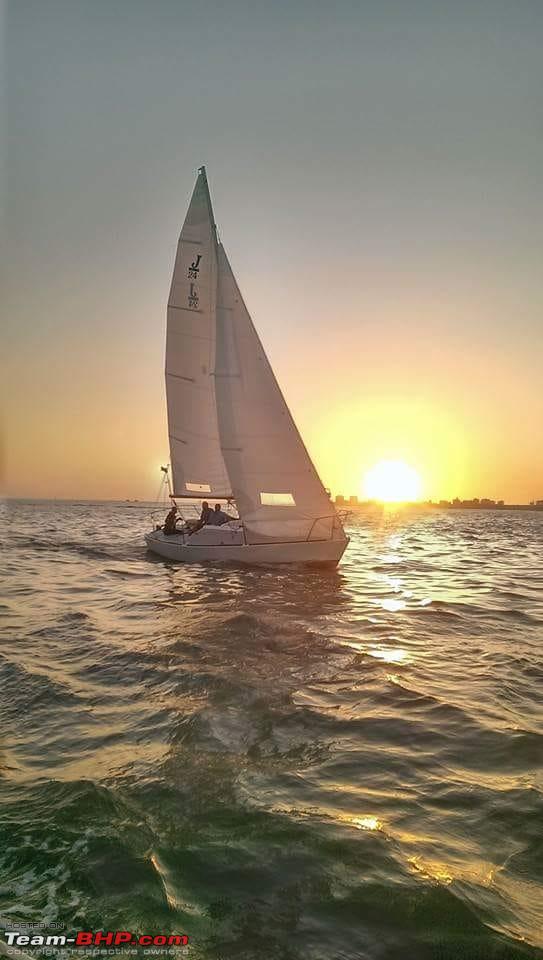News
Life with my very own Drammer 935 Classic Yatch: Some sailing & repairs
I spent almost 4.5 hours sailing. Gorgeous weather. Fource 3-4, very sunny, easterly wind, so quite nippy.
BHPian Jeroen recently shared this with other enthusiasts.
Yesterday I spent a couple of hours on Sirion with Michael. He has installed all the new Raymarine kit. So we went over all the basic functions. Michael knows Sirion inside out, as he has worked on her for many years. So he also helped me figure out a couple of other things that were not clear to me. (e.g. the battery solar charge versus 220 V inverter system).
This is what is all new. There is more, some components don't show.
Slowly but surely I am beginning to become a little confident.
I spend almost 4,5 hours sailing. Gorgeous weather. Fource 3-4, very sunny, easterly wind, so quite nippy. But with the sun and the heating on, it was very cosy inside Sirion's main cabin!!
I came across the huge floating factory. Not sure what it is, it is not a regular dredger. I think it is used to suck up sand from the bottom of the lake.
Sirion has two flagpost. One at the stern, which is reserved for the Dutch flag.
At the bow, she has a smaller flagpost. Professional ships tend to fly their company flag from it. Recreational crafts often fly the pennant from their home marina.
I could not find the flagpole to fit the one at the bow. I did find an old flagpole in one of the lockers. I took it home, to make it fit and revarnish it.
The first thing was to strip all the old varnish and reshape the end as it was too thick to fit in the flagpole holder.
I made this sort of makeshift wood lathe, using my grinding wheel and a clamp. The vacuum hose is fixed to my bicycle repair stand.
Worked well!! However, I had set my calliper to the wrong dimension, so I turned it to a too-small diameter. Luckily I found a piece of plastic pipe, cut it lengthwise and that makes up the difference once again!!
By now I am applying the 5th coat of varnish. Beginning to look pretty good!!
I have finally, with Michael's help found all relevant online documentation for my Raymarine kit. I have downloaded all the manuals. I am going to get them all printed out. I want my manuals on paper!! Not on a screen!! You would think Raymarine could afford to give you a proper paper manual, at the sort of prices they charge for their kit. But no, everything is digital and you would not believe how many different manuals are listed on their website.
This coming Monday, Mrs D and I will visit Sirion. We have invited Ad (previous owner) and Andre (broker and harbourmaster) for a little ceremony. We have enjoyed working with them. So we are going to have a little handover ceremony before we sail Sirion away to her new birth in Arkel.
Jeroen
Read BHPian comments for more insights and information.
- Tags:
- Indian
- sailing
- Boats and Ships
- Yacht
News
The working of a Marine Steam Turbine onboard a Merchant ship
Most would want to know why is steam still being used as a means of propulsion at this day and age. It is only because of the nature of the cargo carried on board LNG carriers i.e Liquefied Natural Gas - Methane.
BHPian BlackBeard recently shared this with other enthusiasts.
Since there was interest shown towards this topic and there already exists threads on Marine Diesel Engines on the forum I am making one regarding the working of a Marine Steam turbine, YES they do still exist!
Marine Steam turbines are the primary means of propulsion on board LNG carriers though they are rapidly going obsolete with the advent of gas burning diesel engines. Most LNG carriers built pre 2015 were with steam propulsion. The generators on board are also steam turbine driven called Turbine Generators with Diesel generators as a back up.
Most would want to know why is steam still being used as a means of propulsion at this day and age. It is only because of the nature of the cargo carried on board LNG carriers i.e Liquefied Natural Gas - Methane.
The cargo keeps continuously evaporating, technically called boiling off and this needs to be controlled. The BoG produced is 0.1% when the ship is in Ballast condition & 0.15% when she is loaded. This percentage is of the total cargo carrying capacity of the ship in CBM.
What better way than burn the gas and produce steam to propel & power the ship?
A brief overview of the process flow is as follows: Both the boilers are MITSUBISHI MB-4-KS
- BoG generated is sucked by a compressor and sent to a heater. (-130C to 40C)
- From the heater it is sent to the boilers for burning after mixing with pre-heated air.
- The heat produced inside the boiler is used to further produce super-heated steam.
- This superheated steam is used for the turbines (propulsion & power).Auxiliary steam is used for heating purposes.
- The exhaust steam is condensed in a condenser and re-used, so its a closed loop system.
Boiler Front view.
Boiler Local Control Panel
Boiler Top looking towards ECR - Engine Control Room
PORT Boiler Burner
The Main steam turbine is a KAWASAKI UA-360 Cross compound, impulse, double reduction geared marine turbine output rated at 23757 kW / 32300 PS
- The HP turbine - 4860 rpm, 10 stages
- The LP turbine - 3222 rpm, 8 stages AHEAD, 2 stages ASTERN
- The Propeller - 84.8 rpm
The reduction gear is a tandem articulated, double reduction, double helical type.
1st reduction pinion - 1st reduction gear - 2nd reduction pinion - Main gear - propeller shaft - Propeller
The thrust bearings are located in the forward side of both LP & HP turbines.
Main turbine overview
Main turbine looking from PORT side
Main turbine looking from STARBOARD side
EMERGENCY manoeuvring panel/station
Read BHPian comments for more insights and information.
News
Took my 2006 Drammer 935 Classic yacht for its first trial run
I was clocking a ground speed of about 16,5 km/h! Which is pretty good for this little boat. Better than its theoretical maximum hull speed!
BHPian Jeroen recently shared this with other enthusiasts.
Got up at my usual 0600AM, but by 0700AM I was in my Jaguar driving north to Leeuwarden to visit Boot Holland. A small, but always very nice boat show. I spend about 3 hours roaming around.Bought the latest charts and almanak.
Then I drove to Strand Horst, the marina where Sirion is moored.
I had a boot full of stuff with me, not just the few things I had bought at Boot Holland. Just piled everything into the forward cabin. Did a few quick checks on the boat and the engine and started her up. Started immediately.
The weather was quite nice, with very little wind and good visibility. I must admit I was a bit nervous. This was the first time I would be taken Sirion out, all by myself, on waters I was not familiar with at all!!
Before I cast off, I had a quick check of the radio. I am familiar with my new VHF radio. The course I took not so long ago had this exact radio. So I powered it up and tuned into channel 10. The default channel for Dutch inland waterways. I also powered up my fancy new plotter/radar/depth gauge/fish finder.
It did power up, but it is way more complex. One of the problems, Raymarine does not supply you with printed manuals anymore. You have to download them. I had a look at their support page on the web. But very complex I could not figure it out. I will talk to Michael and make sure I get the correct manuals.
Even so, the plotter gave me excellent information on everything that I needed for a first trial run.
So I slipped the bow and stern line and back out of the mooring carefully. I had to reverse out and that is always a bit of a challenge on a motorboat with one propellor and rudder. (and bow thruster). The trick is to understand the boat wants to follow the rudder in reverse. There is a so-called wheel effect of the propellor which is always more pronounced in reverse than going forward.It appears this effect on Sirion is pretty manual. Also, you can use the bow thruster to steer the boat when going in reverse. One of the very legitimate uses of a bow thruster.
Made it out of the marina with no problems!!
Me being extremely happy!!! Notice I am wearing my life jacket. I am just by myself, the water is still very cold, this is pretty open water I am entering and there are large barges out there! Safety first.
In due course, I will show some more details on how all of this works. Just a few shots of my plotter. This was about 10 minutes after I had left the mooring. you can see a ship coming towards me and one behind me. I can click on those ships and it will tell me the name of the ship, speed, and so on. It also tracks speed and direction. All part of the AIS! Very cool and extremely useful
If there is any danger of a collision the system will warn you. I still need to fine-tune the various settings for the alarms. There are about a billion settings you need to think through.
The water police was out in force with 6-7 high-speed boats. I saw them climbing on this barge. I think they were practising interceptions and boardings. Pretty cool.
I steered Sirion by hand for about 15 minutes. Very happy with how she handles it. Very light, very nimble. Next, I put her on autopilot. When I switch the autopilot to auto, it will maintain the current heading. I have four buttons, increments of -1o, -10o, 1o and 10o (respectively port / Starboard). So I can alter the course in either one-degree or 10-degree steps.
I was being, slowly, overtaken by this workshop. It followed me through a narrow channel. I was not quite sure what they were doing. So I decided to give them a radio call. My first radio call in a very long time. I contacted them for a so-called radio check first. Interestingly enough, officially you have to perform a radio check every day. Which means calling another station and asking if they receive you loud and clear. Nobody does radio checks every day anymore. Radio has become extremely reliable. There is no need. But my radio was brand new and had never been tested. So I called them and asked "Radiocheck". To which they responded, Sirion we receive loud and clear. Next, I asked them about their intentions and told them where I wanted to go.
After we understood each other I let them overtake me and I started following them;
They were doing some survey work or so.
Not a bad first day out on the boat!!
By now I was really enjoying myself. I must admit, I had been looking forward to this first trip, but I was also a bit stressed. I have had some serious health issues over the last couple of years.Taking on any new adventures doesn't come as easy as it used to. Learning new stuff is a real challenge. Of course, none of this is really new to me. But I had not done it for a while. I am on my own boat, beginning to understand how all the various systems work!
I was fine and starting to enjoy myself more and more every minute!!
I steered into one of the other marinas. I wanted to practice some more manoeuvring. With no other boats entering or leaving the marina, I spend about 15-20 minutes getting a feel for how Sirion handles in close quarters.
I took a little video. Don't mind the engine noise. I don't know why it sounds so intrusive. Must have something to do with how an iPhone picks up sounds. I was pleasantly surprised by the engine sound. Even at full throttle, you can have a normal conversation in the cabin, with no problem.
I had put some of these images in our family app. Soon the comments and congratulations of my kids and their partners started pouring in.
By then I was almost an hour into my first trip and decided to turn back to Strand Horst. Also, time to full speed, damn the torpedoes and all of that!!
I was clocking a ground speed of about 16,5 km/h! Which is pretty good for this little boat. Better than its theoretical maximum hull speed!
I managed to make it back into the marina Strand Horst and moored here back in the same position. Not to boost or anything, but I did really well manoeuvring and docking her, the first time, all by myself!!
I did a bit more tidying up and putting away all the new stuff. And I hoisted two of my new pennants. The Bridgetown Yacht Club and the KNRM (Royal Dutch Lifeboat Association) of which I am a member of course.
The pennant of my home marina will go at the front, but I have to modify a few things before it will fit.
All in all, I could not be happier!! Still, a lot to learn. I will meet with Michael later this week or next week and he will give me a full rundown on all the new electronics!
Jeroen
Check out BHPian comments for more insights and information.
- Tags:
- Indian
- Yacht
- Boats and Ships
News
International Maritime Exhibition: Ship engines, transmissions & more
On many ships these days we see so-called four-stroke medium-speed engines. They typically run around 400-900 RPM.
BHPian Jeroen recently shared this with other enthusiasts.
In 1976, I started at the Dutch Merchant Naval Academy in Amsterdam, the Netherlands, as a student. Four years later, of which the 3rd year was spent aboard a Dutch General Cargo ship (full 365 days) I graduated. I spent the next 10 years as a Marine Engineer working for various shipping companies. Eventually made it to Chief Engineer. I have worked on a large number of different ships. From general cargo to bulk carriers, and container vessels. Most of my time at sea was spent on ocean-going tugs and anchor-handling vessels and a few other offshore support types of vessels.
Although my sailing days are long gone, I have always remained interested in the marine industry. Every year, for as long as I can remember, the Netherlands has held a huge international maritime congress, known as Europort. Europort is essentially the harbour area of Rotterdam. To date, Rotterdam is still among the largest and most modern harbours in the world. The Netherlands has a very long maritime tradition and there is a considerable maritime industry based in the Netherlands. Ranging from building superyachts, tub boats, maintenance ships propellers, electronics and lots more.
We have several threads on the forum about the (merchant) navy and we have several members who worked or are still working in this industry.
I visited Europort 2023 earlier this week and this thread is a collection of what I came across. Although a lot of it is maritime-related (Duh!) it also shows a very wide range of technology and its various applications. So I hope you enjoy it.
This event is not open to the general public. But it is not that difficult to get a free entrance ticket. I mean if they let me in, anybody can get in. So on Tuesday I drove my Mini to the nearby station and took the train and bus to the Ahoy Congress Halls in Rotterdam.
The images I will be showing are not sorted in any particular order or topic. It just shows how I wandered around this massive event, spread out over 8 halls.
TeamBHP being a car forum you will be happy to see, that the very first thing I came across was a car!! For the life of me, I can't remember what it was doing here. One of the companies involved must have some relation with the maritime industry.
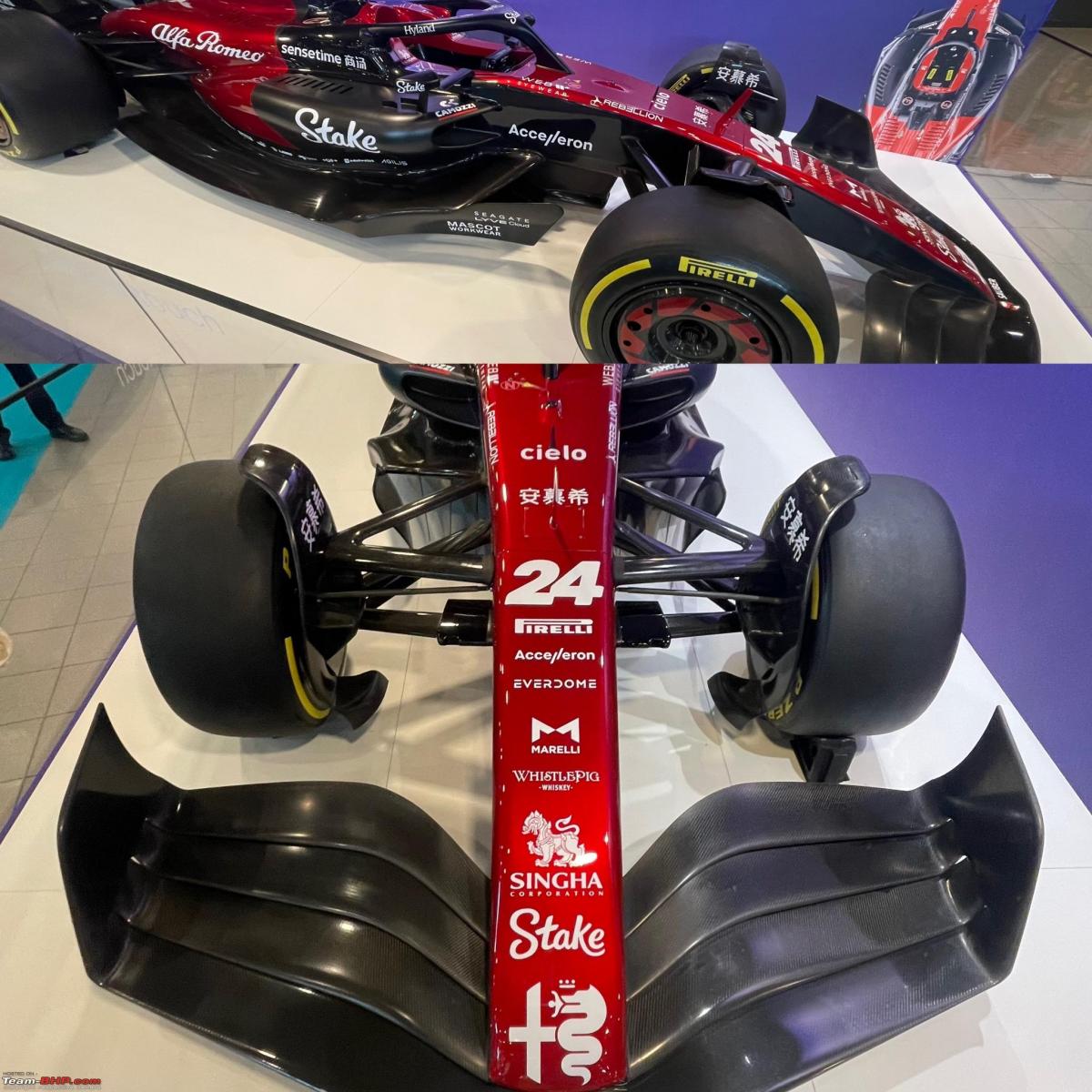
One of the first things I bumped into was the Volvo Diesel. You will see a lot more (Diesel) engines. I had a good look at this one as it was very similar to the little Volvo F16 Truck Engine I built not too long ago.

As you would imagine, there was a lot of emphasis on various environmental themes. There were several engines, running on alternate fuel, such as Hydrogen! These sorts of engines have already been in use for some years. Not just in the merchant navy, but also in stationary shore applications.
This particular engine is rated at 1000kW (1341HP) at 1000RPM.
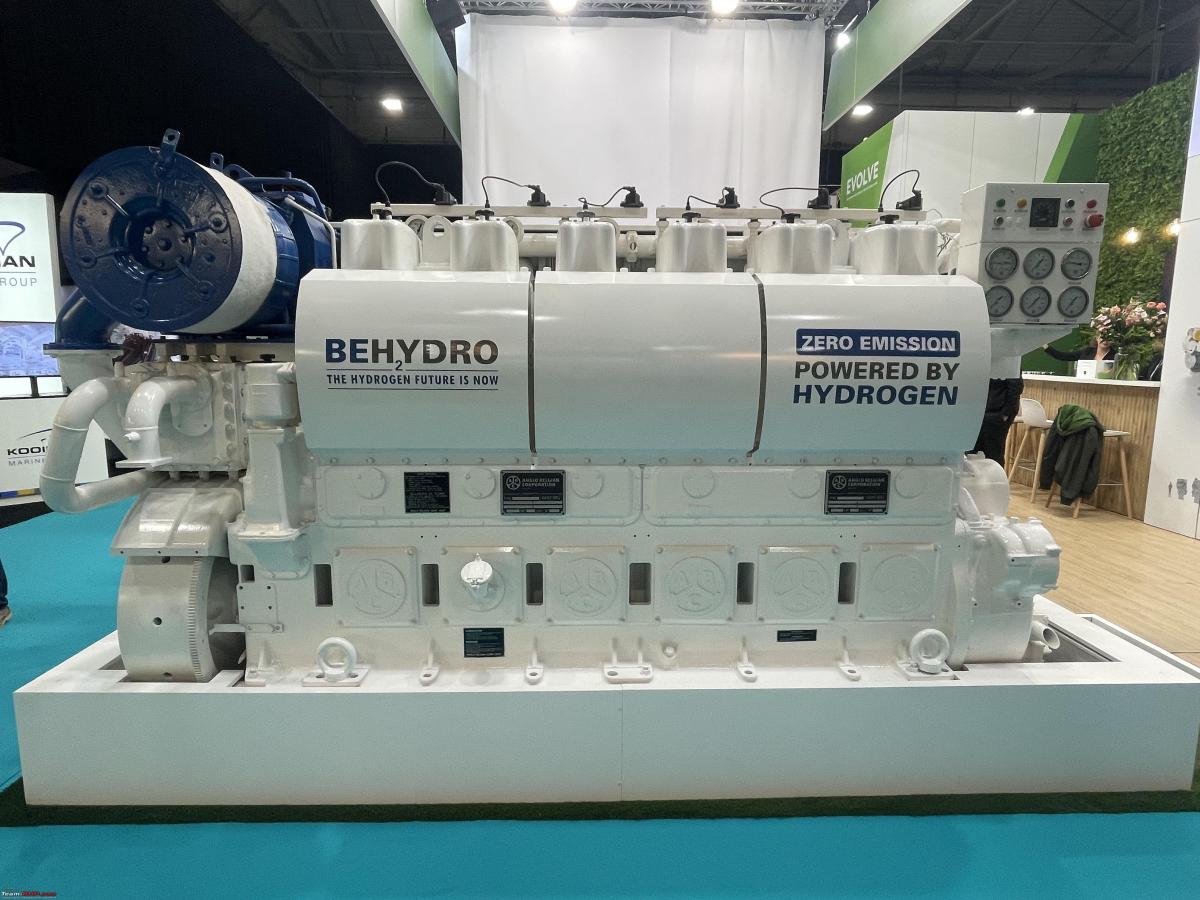
Lots and lots of very interesting and very detailed ship models! I have taken several images of various kinds of ships. This is a small cargo ship with two modern sail arrangements. It enables fuel efficiency.
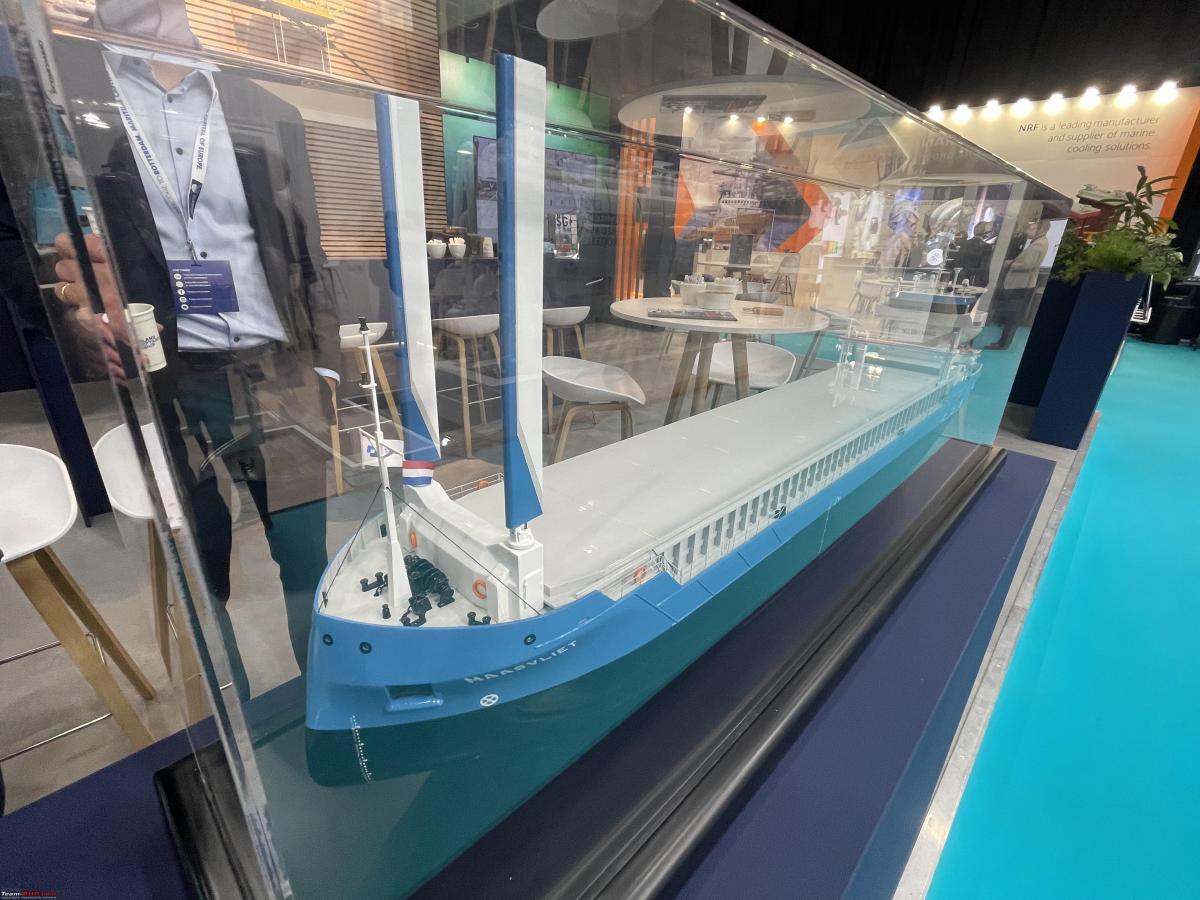
For all of you who wondered what a modern heat exchanger looks like, look no further. These so-called plate coolers have been in use for a very long time. I have worked on them. We used them to cool the engine cooling water (freshwater) with sea water (salt water). Especially if you operate in shallow waters or river estuaries you might end up with a lot of mud inside these things. They have to be taken apart and each plate has to be cleaned individually.
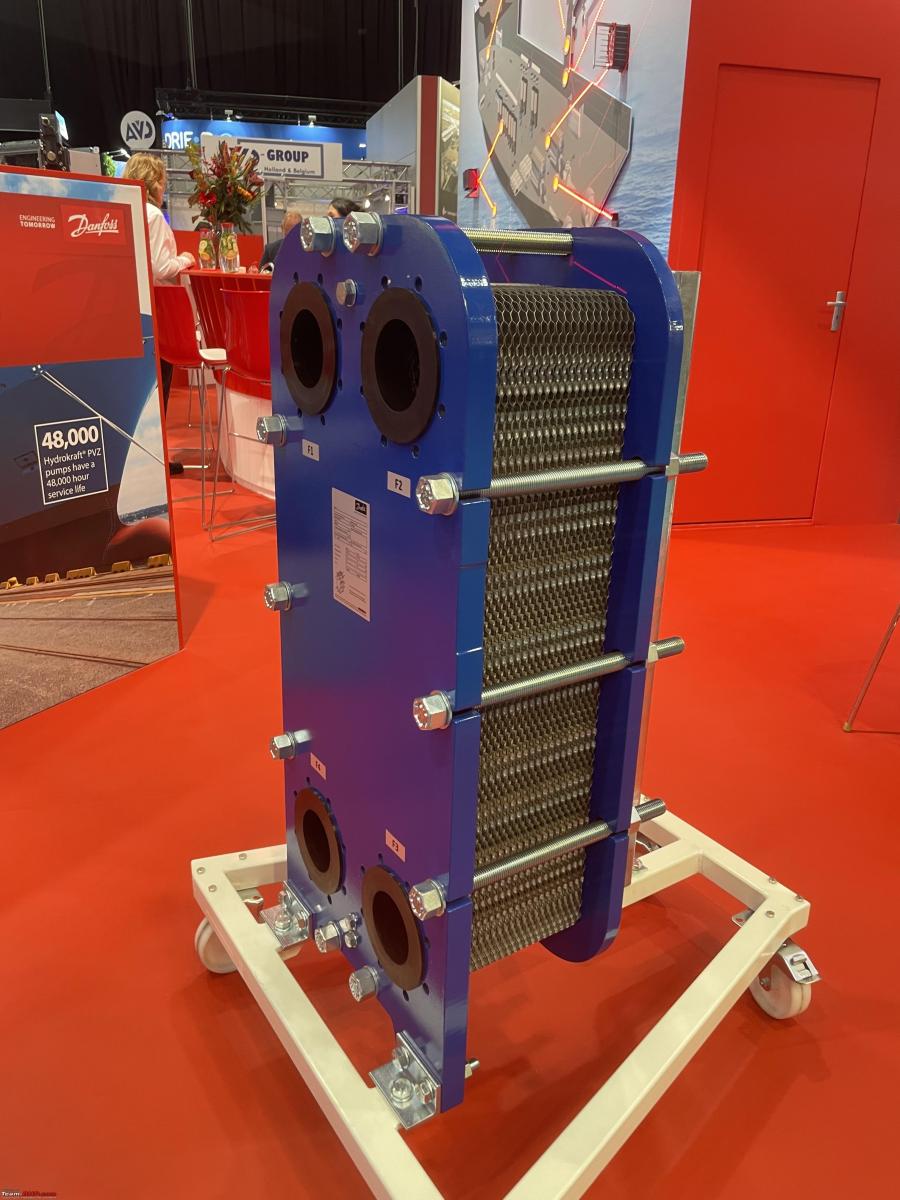
One of my favourite models I came across; was a very smart model of a powerful harbour tug. Look at the detailing on it!
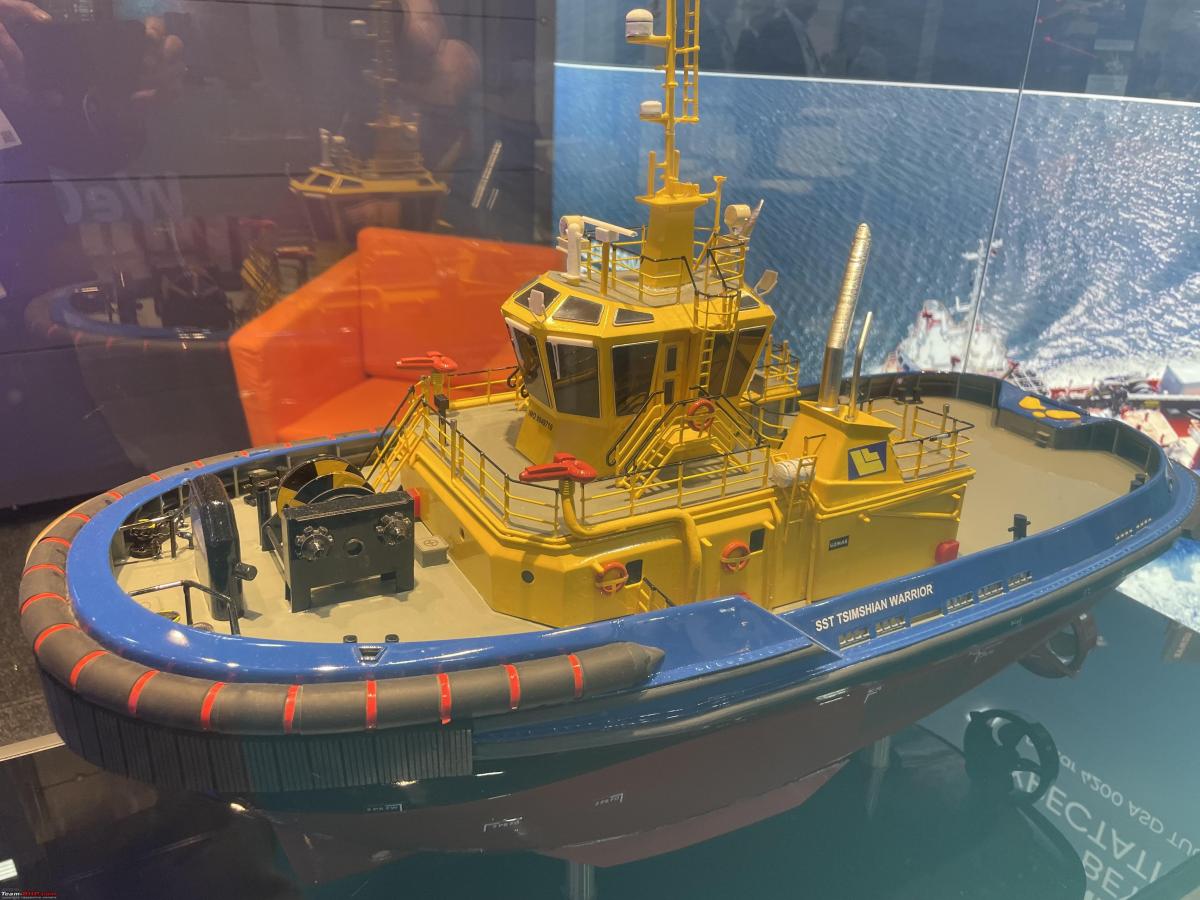
Petrolheads will recognize the name of this company, ZF. They are also big in the maritime industry providing all kinds of very fancy and huge reduction gear. On merchant ships for best efficiency, the ship propellers can't be turning too fast. On very very large two-stroke engines, the propellor is coupled directly, via a propellor shaft to the engine. It will run between say 40-180 RPM. On many ships these days we see so-called four-stroke medium-speed engines. They typically run around 400-900 RPM. This also means you need a reduction gear in between the engine and the propellor (shaft) to reduce the propellor RPM.
Here you see such a reduction gear (on the right), on the left, you see an e-motor that provides power as well. So this is a hybrid type of setup.

This looks pretty simple, but it is a phenomenal innovative design. This is a section of a propellor shaft, made entirely out of composite! I had never seen anything like it. I had no idea composites were suitable for these very high torques. They did tell me that these are designed for one particular direction of rotation. So it won't work on reversible engines.
The main advantages compared to traditional steel prop shafts:
- Maintenance-free due to corrosion resistance
- Low mass moment of inertia
- Low damping factor
- Low weight
Especially the low weight is very important because less weight means better fuel efficiency!

Every ship will have hundreds if not thousands of valves. So there were a lot of valves on display as you can imagine. This is a so-called butterfly valve. Valves come in a huge variety of different designs and materials.
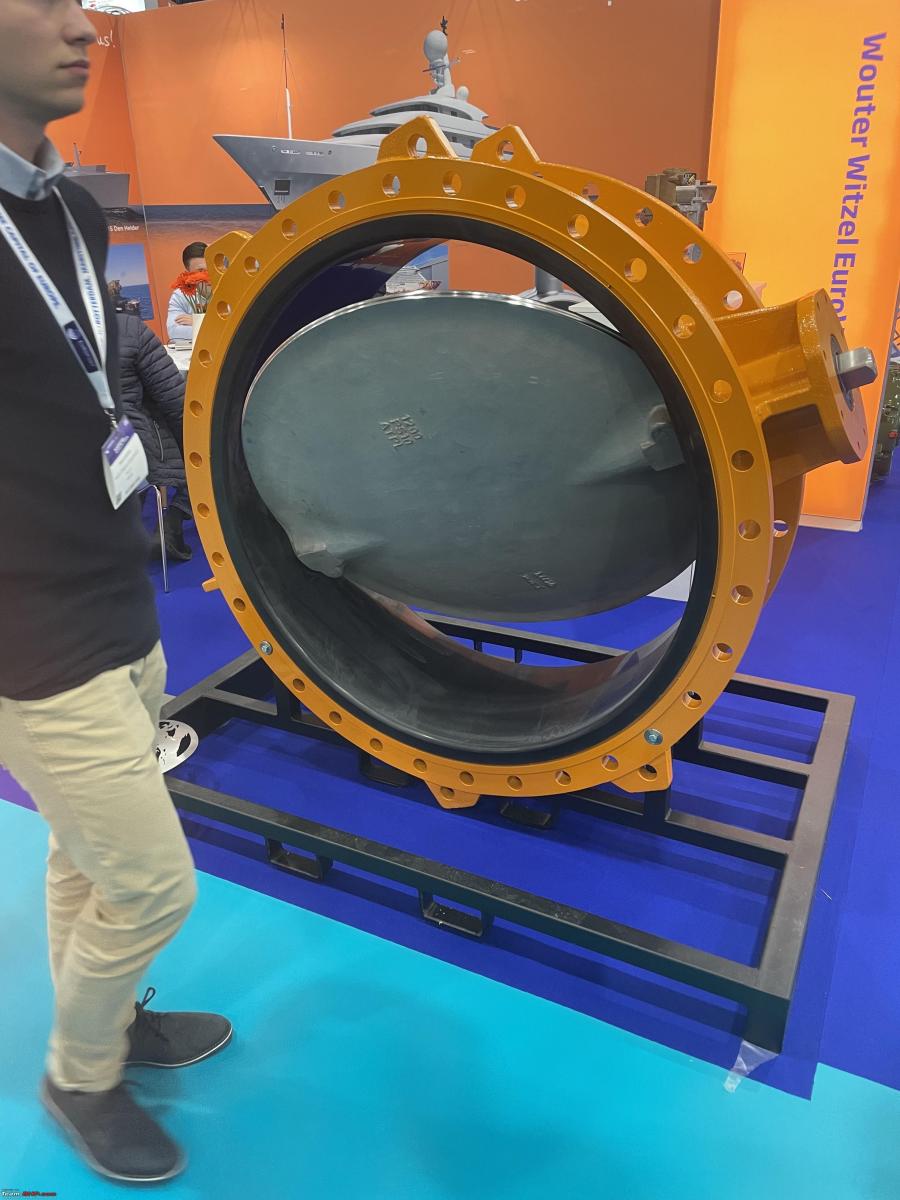
Another diesel engine, A Hyundai
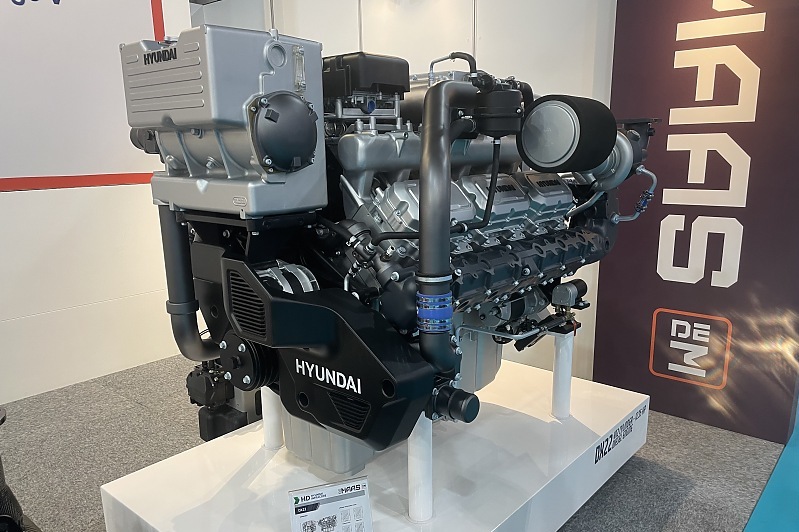
This stand had some interesting things. This is all about tugs, their winch and various other machinery to keep cables and towing wires fixed in place. These days all operated from the bridge, hydraulically. In my days, we had to secure the towing ropes manually. Very dangerous, especially on a rolling and pitching deck with waves crashing over the stern.
This is a towing winch with a heavy-duty air-cooled brake.
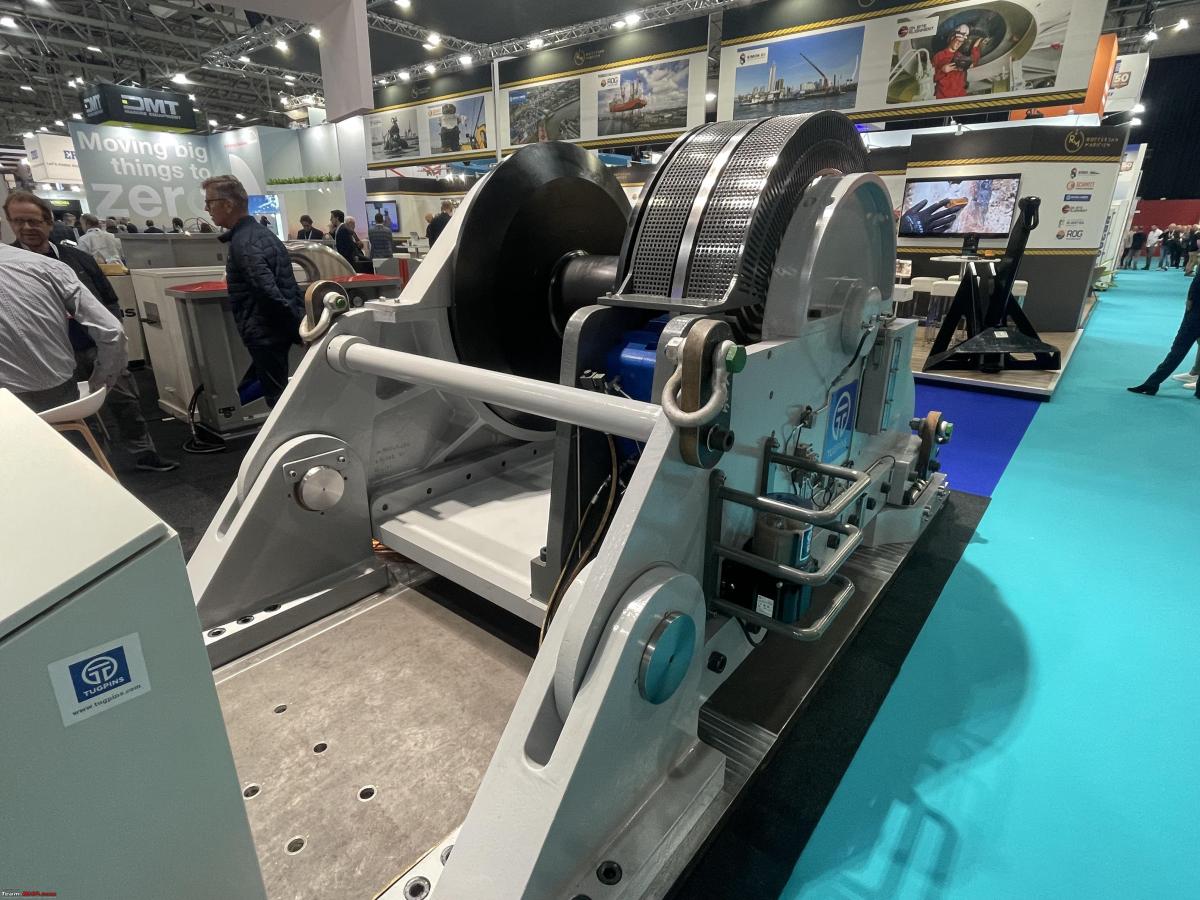
I can't remember the official term for this one. It is built into the deck very near to the stern of the rug or AHT. The two halves can be retracted fully into the deck or rotated upwards in the shown position where they can clamp a towing or an anchor wire safely. Nobody needs to go near it, all done safely from the comfort of the bridge!
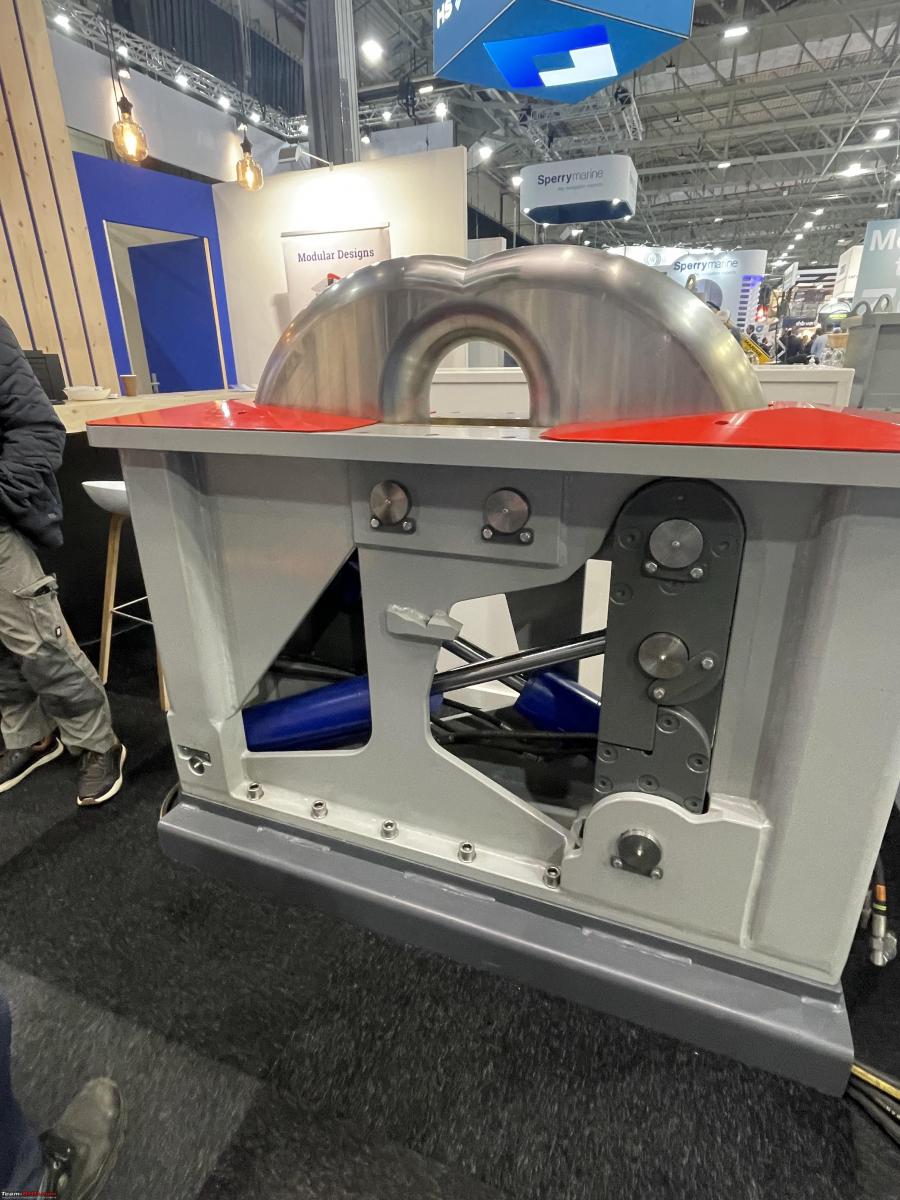
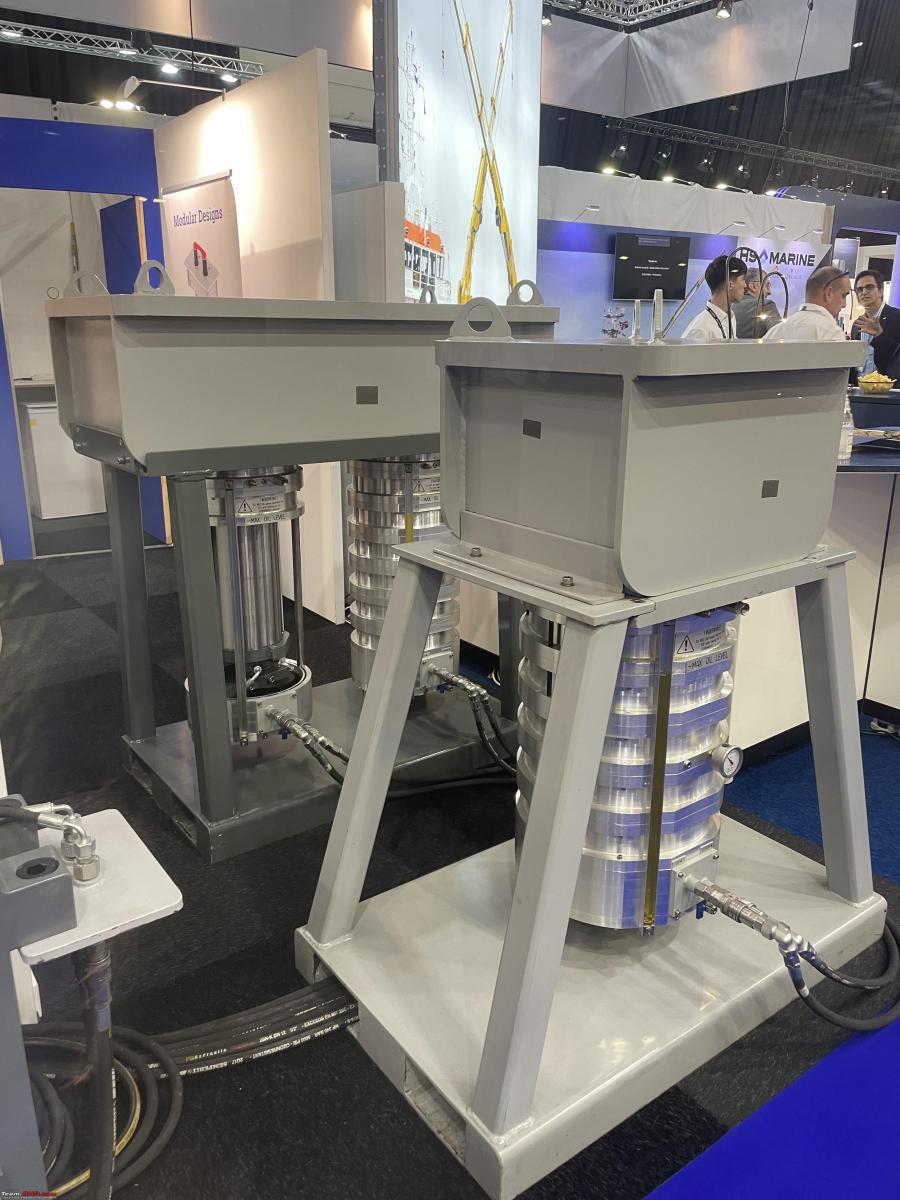
There are endless varieties and designs on how to run the prop shaft through the stern of the ship. You need bearings, lubrication and some sealing mechanism.
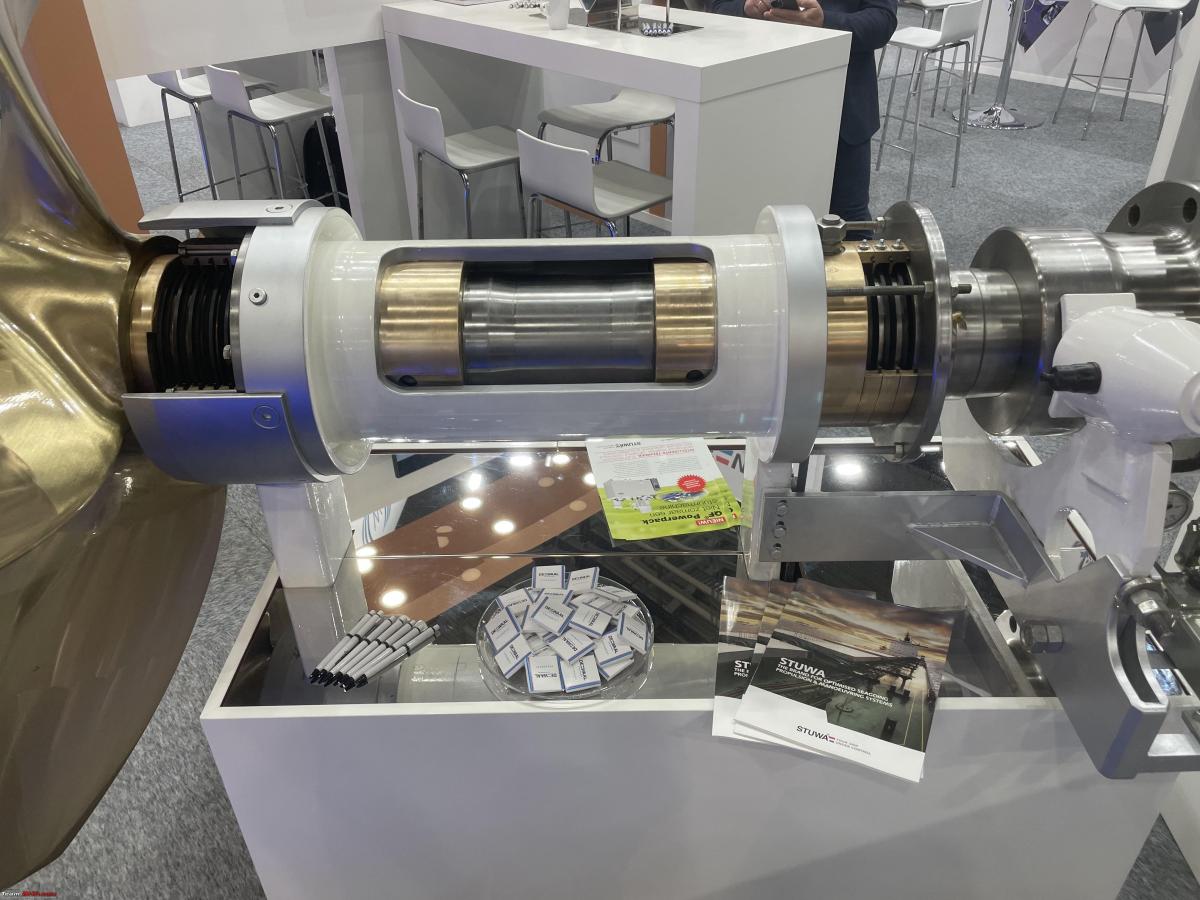
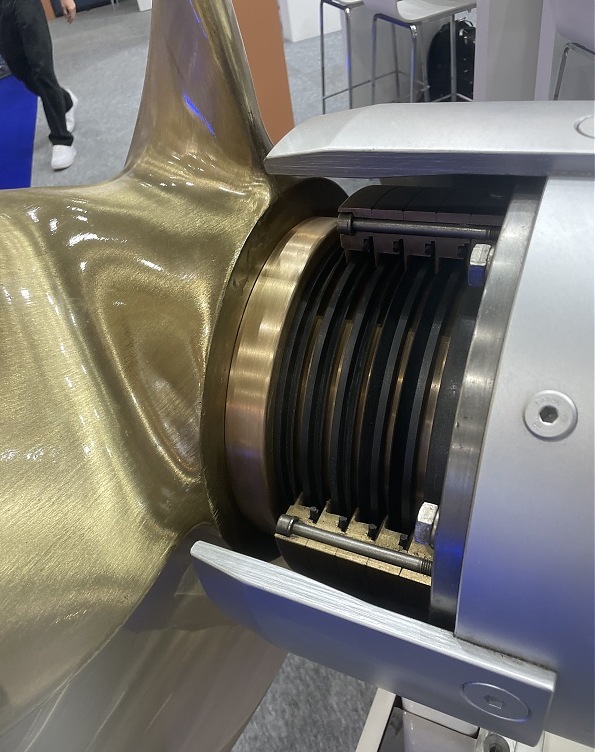
Whereas the shipbuilding industry in the Netherlands has moved abroad for a large part, we still have a lot of ship maintenance yards and specialised workshops. Anything from fixing a deck crane, a winch, or a hull repair to engine repair and maintenance.
Here you see a couple of cylinder heads from a marine diesel, that have been overhauled.
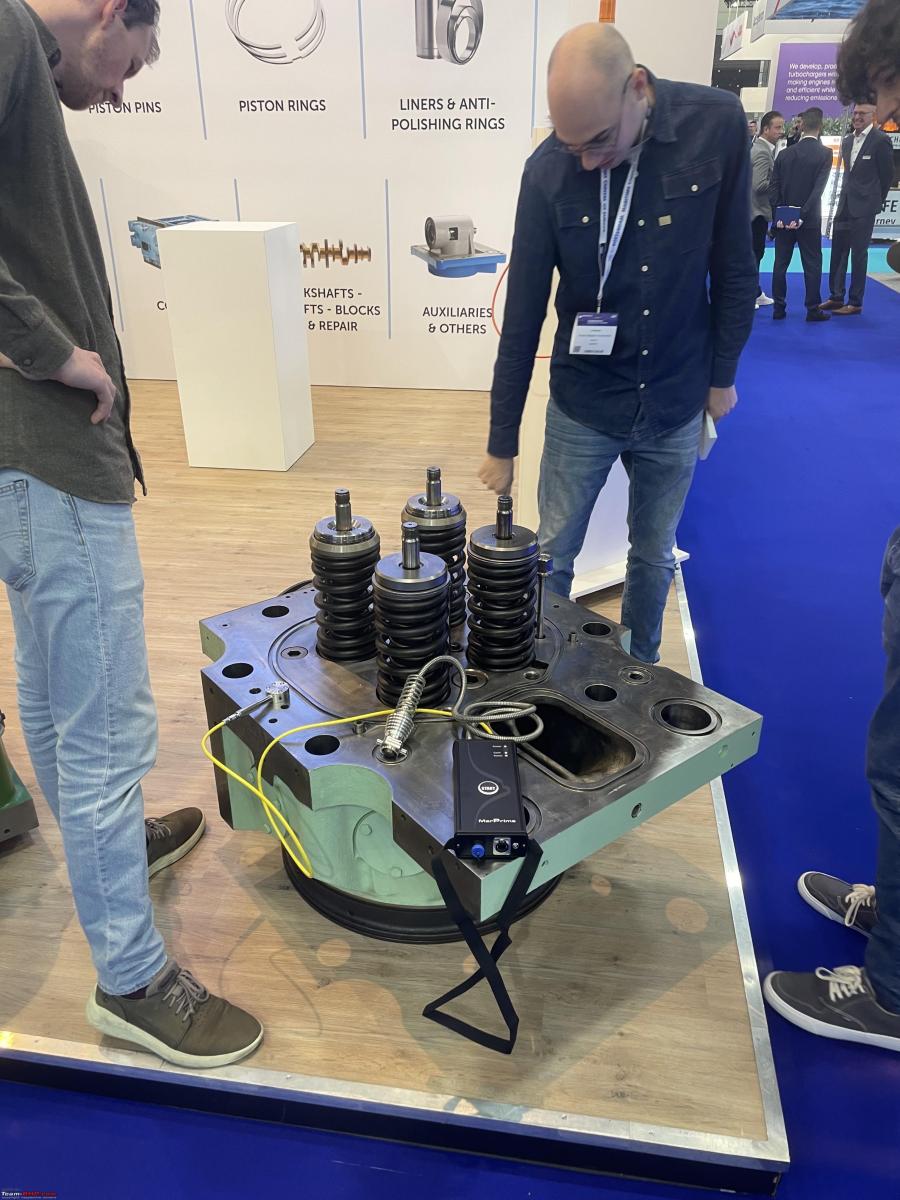

A couple of baring shells, I have held up my hand to get some idea of size. Compare this to your humble car engine. Even the bearings on my mighty Jaguar 4.0L V8 are tiny compared to these.
And then there are still a far cry removed from the really large bearings on slow 2 stroke engines!
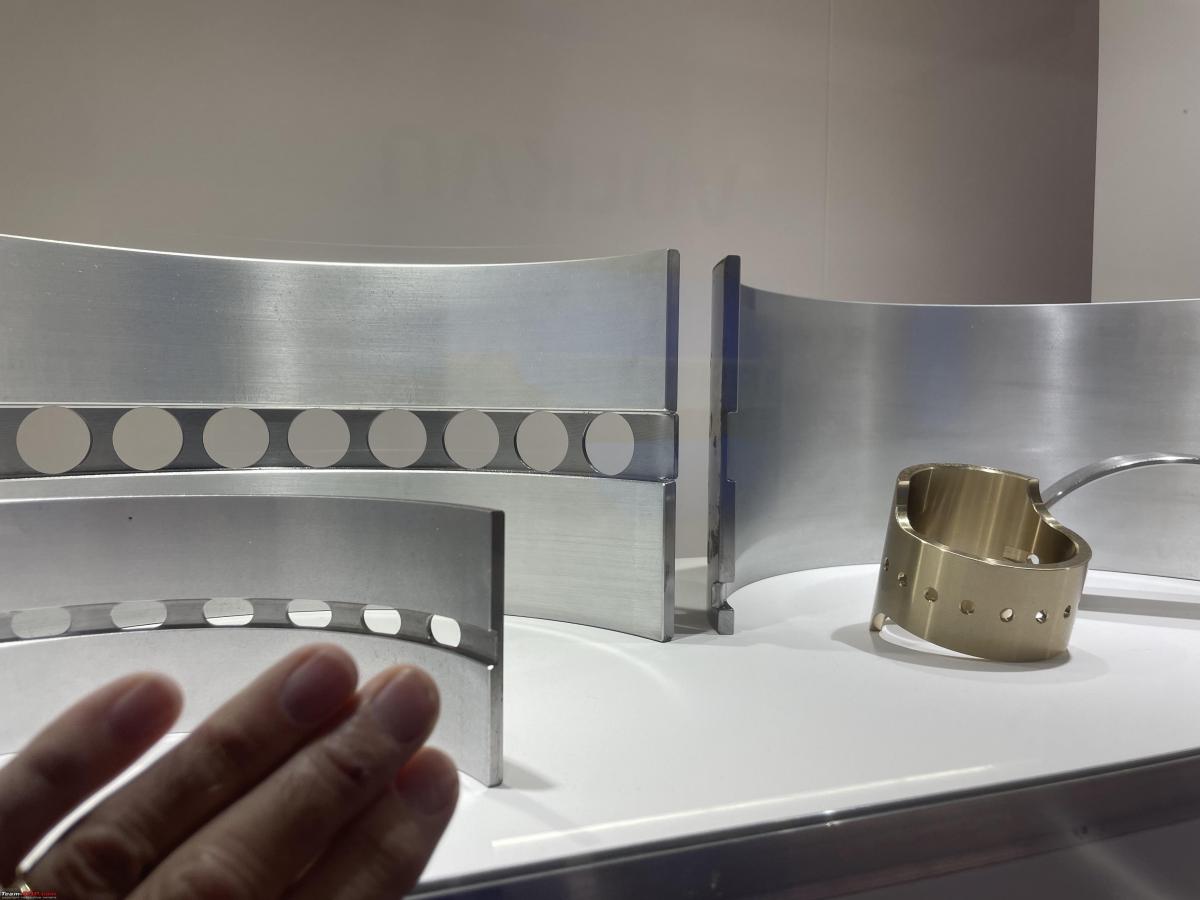
Continue reading Jeroen's experience at the exhibition for BHPian comments, insights and more information.
News
Travelling from Netherlands to Scotland via a ferry in two Alfa Romeos
We had booked a return ticket for two and two cars, two cabins, a 3-course dinner and breakfast for which we paid almost Euro 600 (INR 53000) per person.
BHPian Jeroen recently shared this with other enthusiasts.
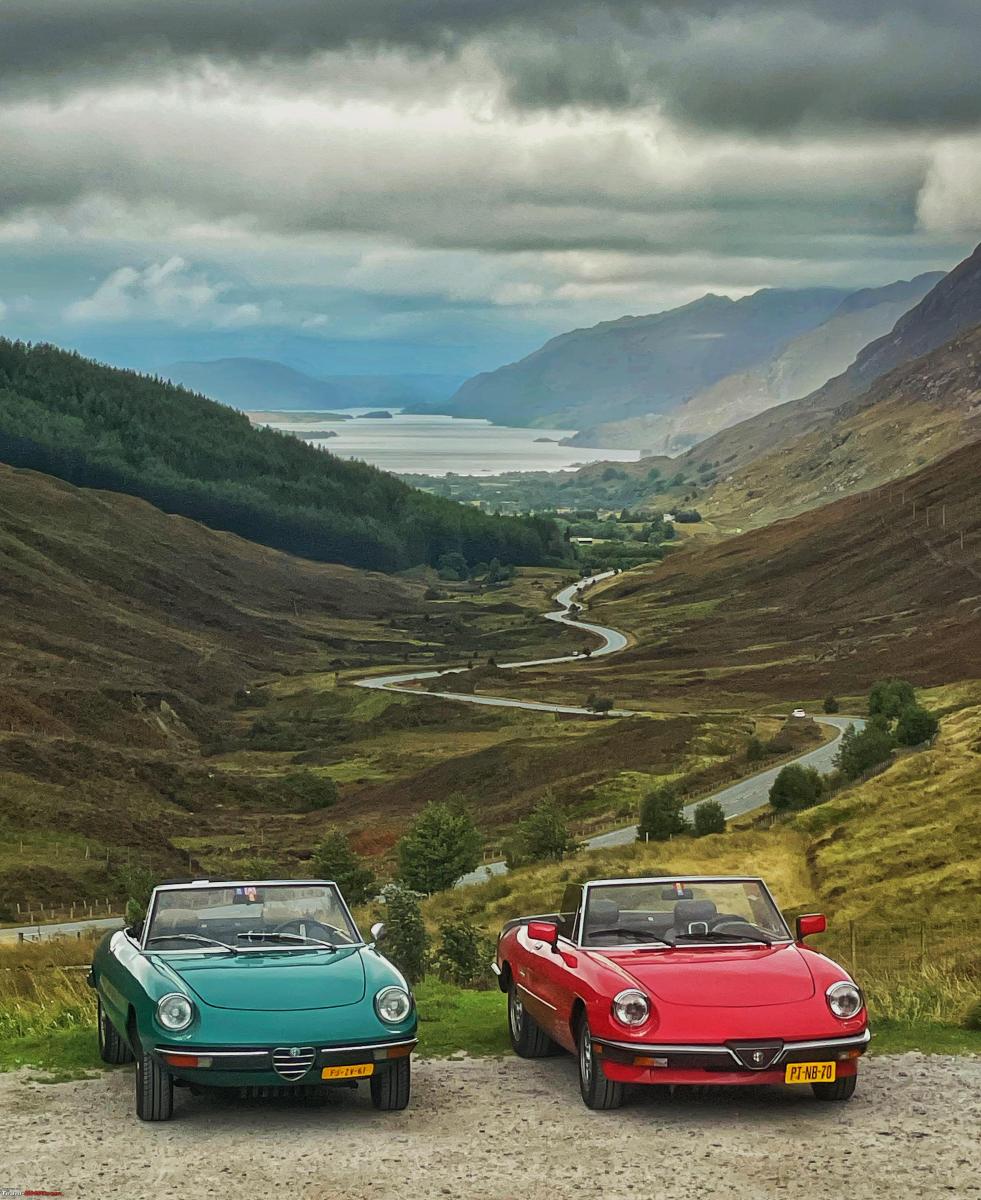
Every year my best mate Peter and I take our Alfa Spiders out for a 4-5 day trip abroad. I have written about a number of our annual trips before. This year we decided to take a trip to Scotland.
We live in the Netherlands. There are various ways of getting to the UK from the Netherlands by car. I have mentioned the Stenaline crossing Hoek of Holland Harwich before. However, when you want to travel to Scotland, you want to take a ferry that takes you as North as possible. That means we booked our trip to IJmuiden Newcastle some 6 months ago. We left IJmuiden on Thursday the 7th of September, at 17.30 and were back in IJmuiden Wednesday 13th of September at 10.00 hours and some 1750 km of driving behind us!
These annual trips are about driving our Spiders and enjoying each other's company. So we tend not to have a specific goal or destination in mind. We usually play it by ear. At breakfast, we usually plan where we want to be around lunchtime. At lunch time we plan for the rest of the afternoon and by about 16-17 hours we start looking for a place to sleep and eat.
IJmuiden is a Dutch coastal town, with massive locks that are the entry to Amsterdam harbour. There is also a small fishing harbour outside the locks. It is also used for various offshore activities/vessels and the DFDS ferry docks here as well.
As Peter lives in the North and I live in the South we had agreed to meet at the Ferry terminal by about 15.00 o'clock.
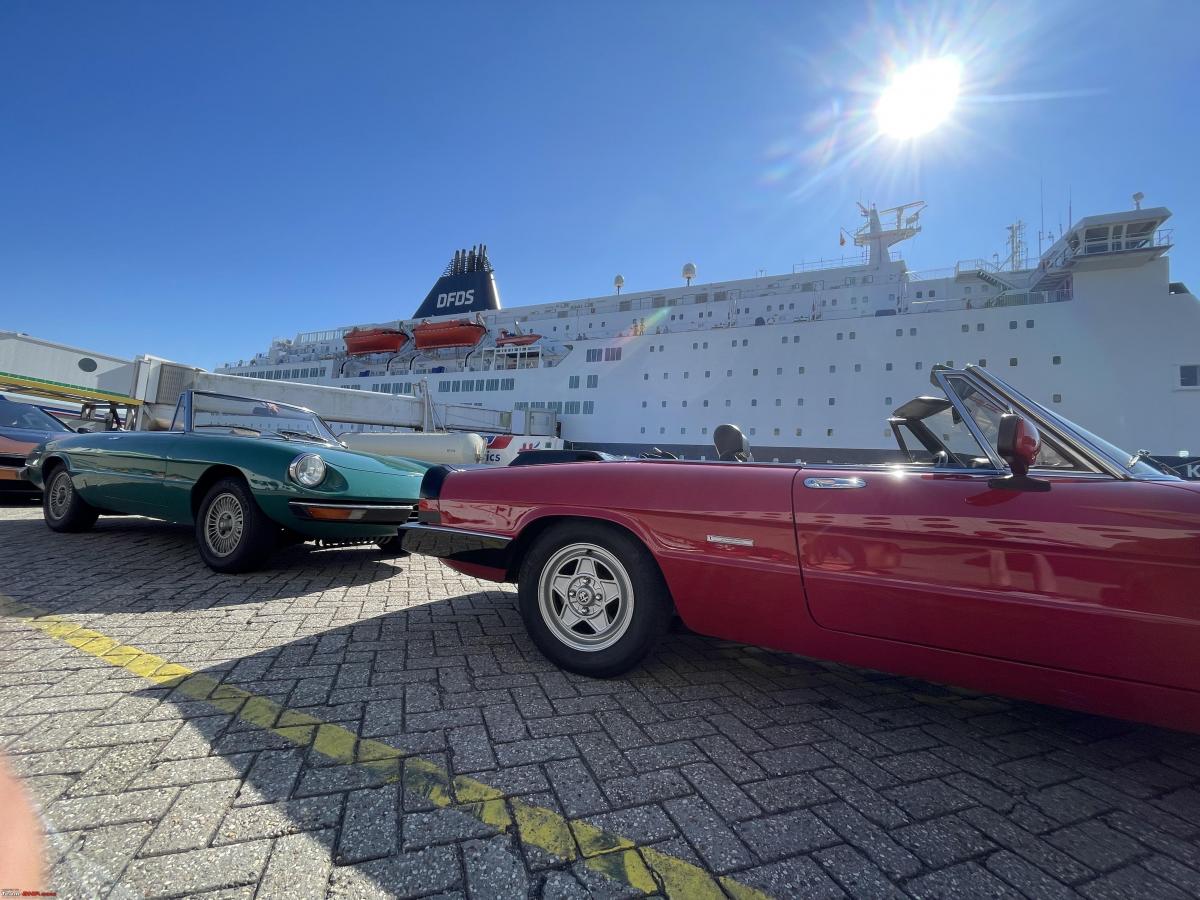
As per our usual routines, we stuff our Spiders with various parts and lots of tools, just in case. These Spiders are well over 40 years old. We never made a trip abroad without having to do some kind of spannering, so better be prepared.
We had booked a return ticket for two and two cars, two cabins, three-course dinner and breakfast. As we had booked early we got a 20% discount. Still, per person, we paid almost Euro 600 (INR 53000). Not cheap, but you only live once as they say!
We have been on numerous ferries over the years. And we have visited the UK many times, however, the last time we toured Scotland was some fifteen years ago. And we were going to cross on the same ferry as fifteen years ago.
She was built in 1987, this ship went through a major renovation in 2006 and has a wide range of restaurants, shops, bars, cafés, two cinemas, casinos and children’s entertainment.
Technical Details:
- Length/Width: 163m x 28m
- Cars: 600
- Cruising Speed: 21 Knots
- Engine Output: 19,880 kW
- Passengers: 1325
- Year built: 1987
- Cabins: 522
- Renovated: 2006
So it is quite an older ferry. But very well kept. We found the restaurant and dinner excellent. Really good choice of very well-prepared food and drinks.
The cabins are quite small but still perfectly adequate. You tend not to spend any time in your cabin on these crossings, other than for sleeping.
Bunk bed, for single occupancy the top one is raised flat against the wall of the cabin.
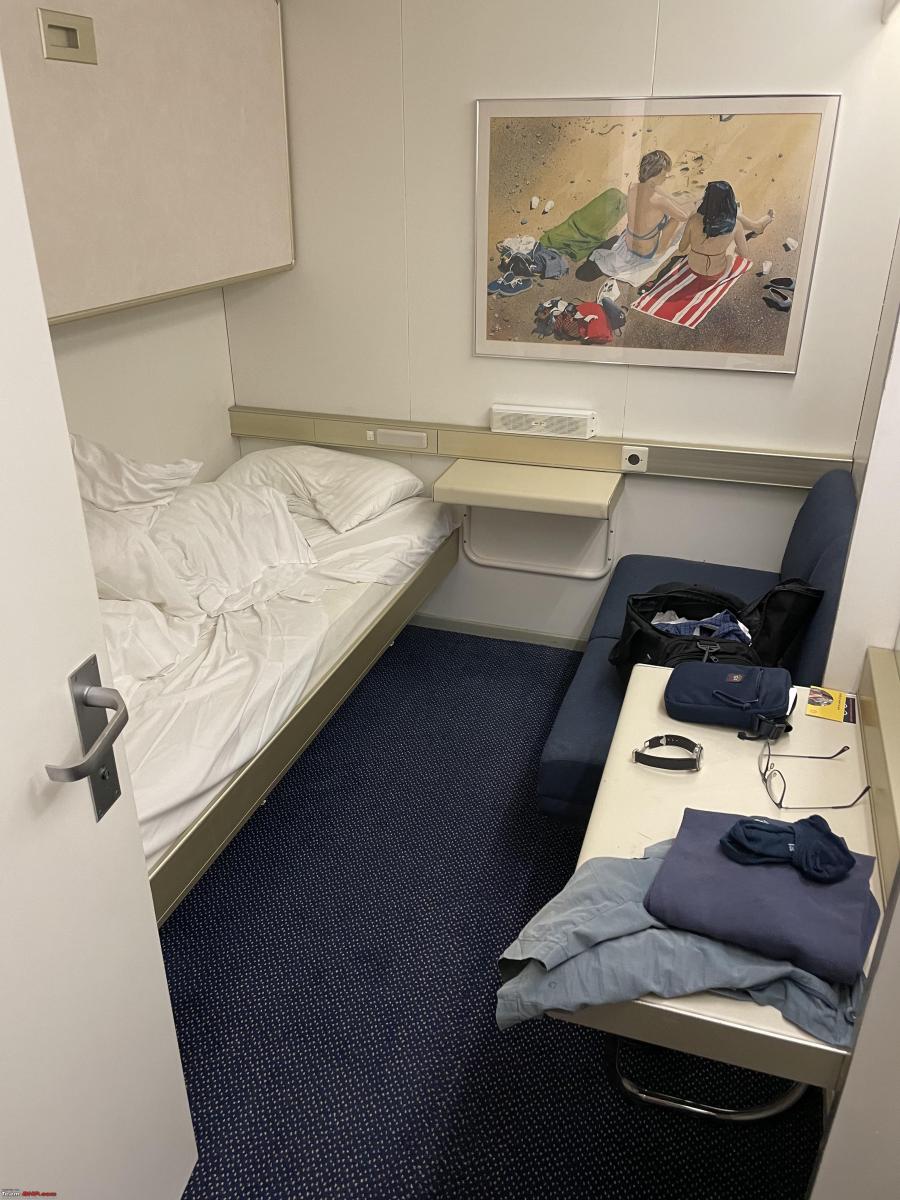
Tiny bathroom
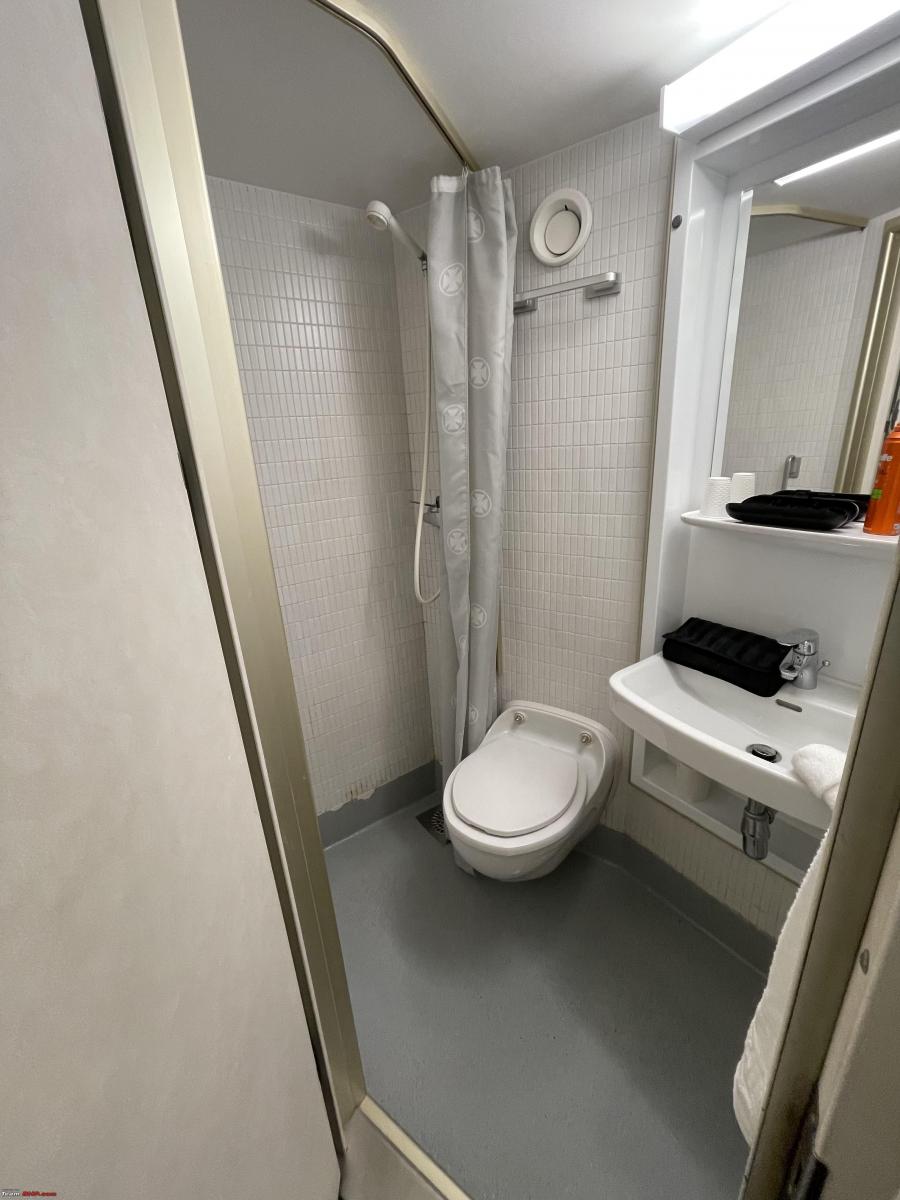
Boarding the ferry went pretty smoothly. You pass a DFDS check-in point and Dutch immigration. From the minute we arrived till we had parked out Spiders onboard was about one hour. DFDS starts boarding cars and foot passengers well in advance of the actual departure time. So if you arrive a couple of hours early they will let you board as well. Much better than hanging around on the quayside.
We were directed to deck number 5, which was a bit of a squeeze. The Spiders are quite narrow, but there were modern SUVs on this deck as well. Could hardly get past them. Every car is "marshalled" into the exact position. This means the mirror of my Spider was about 2 cm from the wall!

The weather was gorgeous. So we dumped our bags in our cabins and went straight up to the top deck to enjoy the sun, have a drink, and watch the cars and lorries and the endless seagulls trying to steal food from unsuspected passengers.
We left a couple of minutes early. Here we are just passing the northern breakwater pier of IJmuiden.
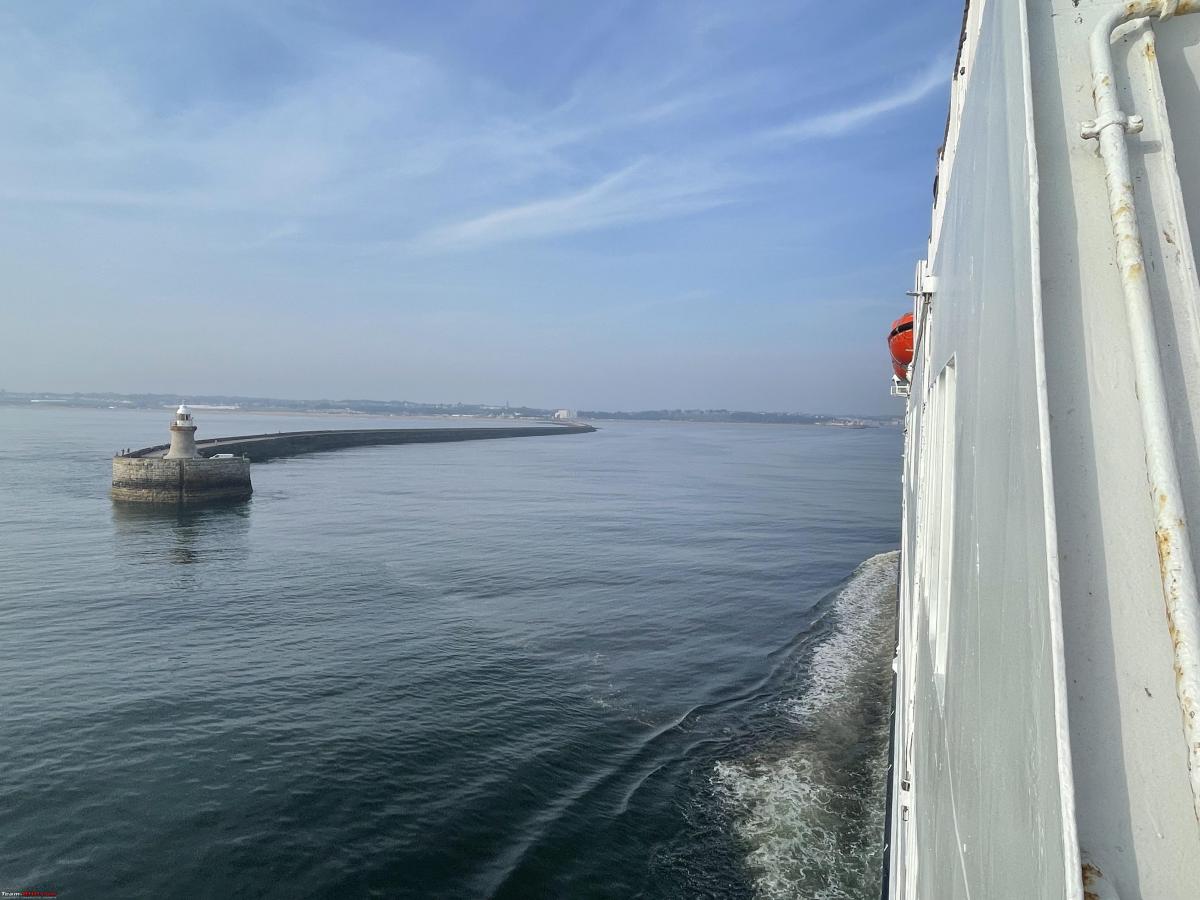
Some of you might know I started my career in the Merchant Navy. I left the merchant navy in 1986 having sailed as Chief Engineer on all sorts of vessels. Although my sailing days are long gone, I still enjoy being out on ships, going to maritime conventions and so on. On every ship, I find myself I will always introduce myself to the crew as a former Chief Engineer and colleague. Could we please have a look in the engine room?? Of course, you can!!
If you're not into engine rooms, scroll past the next couple of images. Peter had never visited an engine room, so it was a new experience for him. We got picked up at the reception desk by one of the apprentice engineers who took us down to the control room.
Some of you will notice this is an all-analogue control room. This is a traditional analogue diesel engine control room. Lots of gauges, levers, buttons and some annunciation panels. All officers are Danish. They also have Dutch crews.
We met up with the second engineer on watch. We talked extensively about various (technical) topics and he took us on an extended tour all over the engine room.
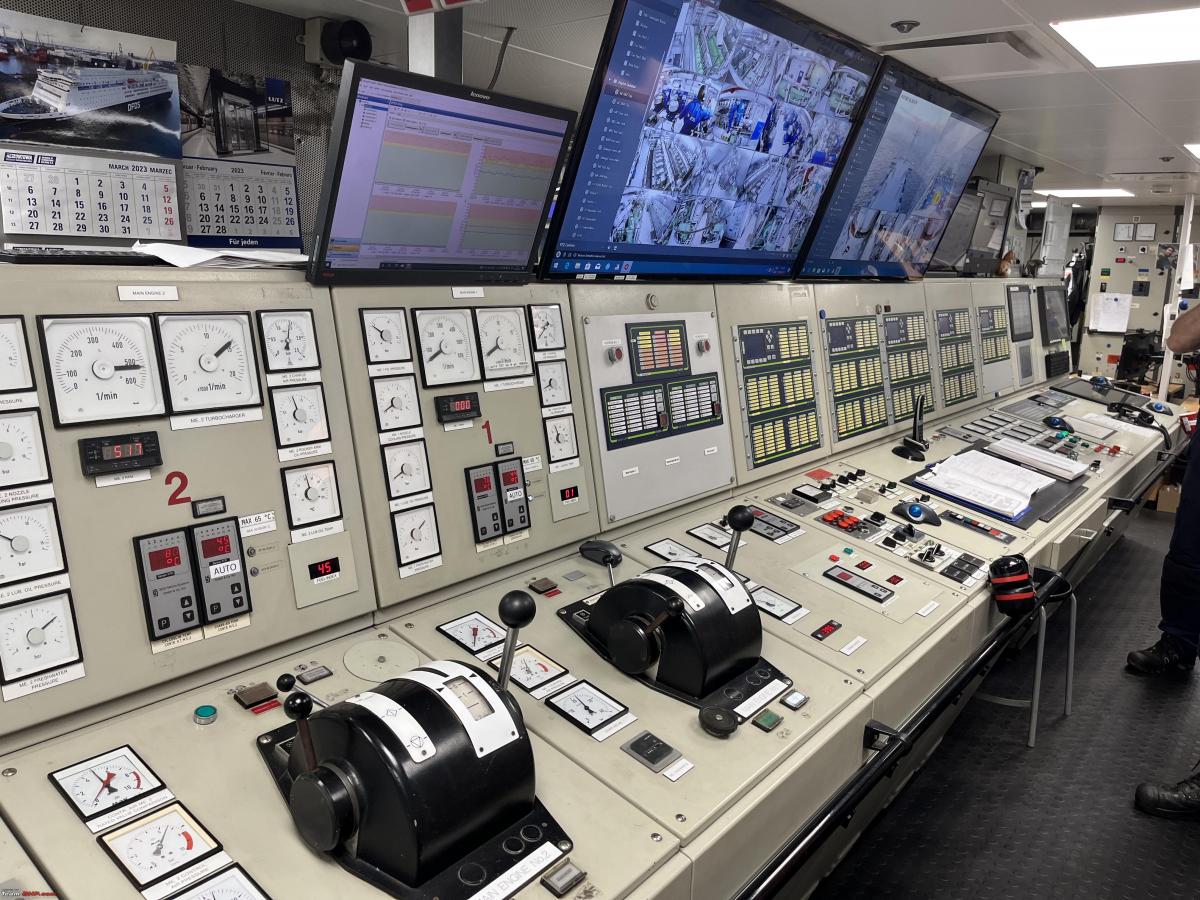
This ship has four, identical, main engines. All MAN. They are coupled in pairs, via a gearbox to two propellers with controllable pitch. All the engines run on very low sulphur diesel. This means this vessel is exempt from having exhaust scrubbers. Which is a good thing too. Can be very complex retrofitting on old vessels.
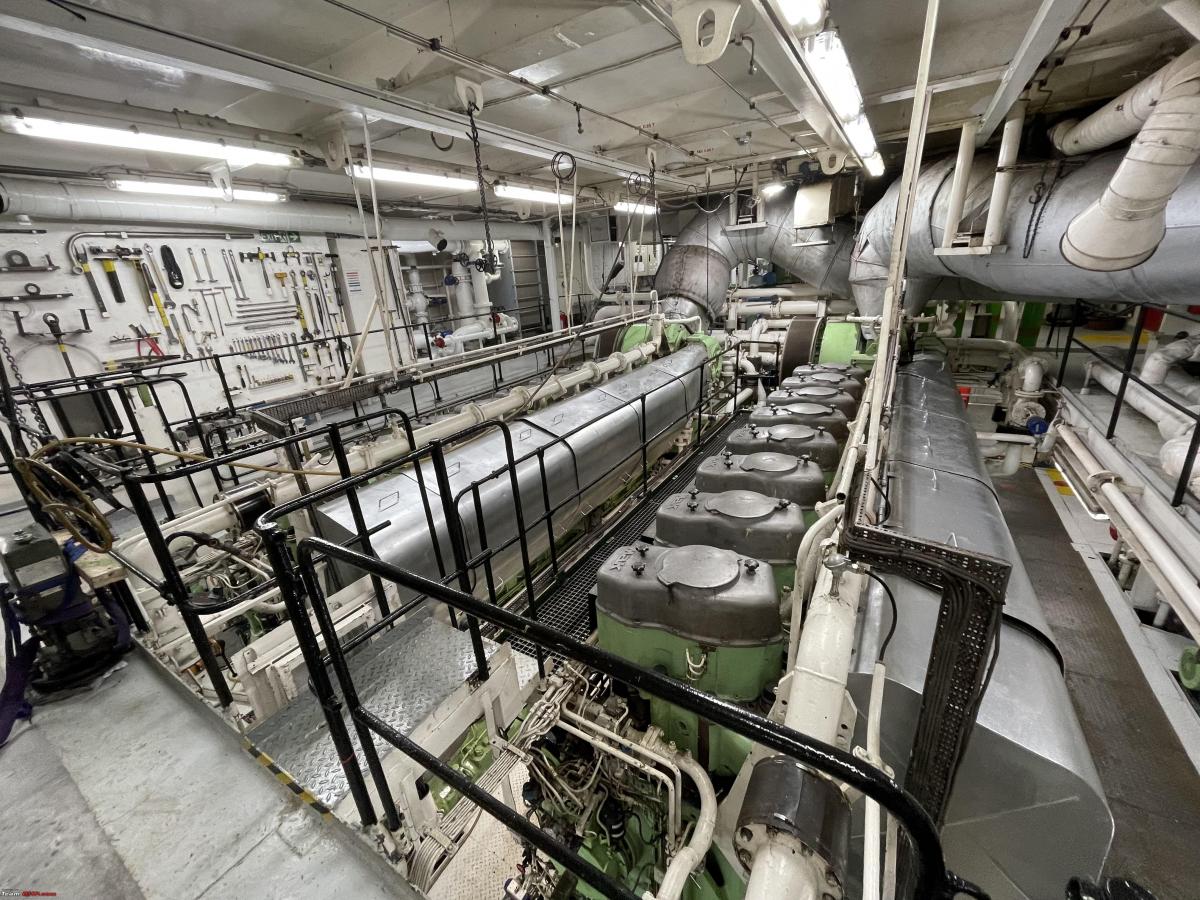
The gearbox at the rear of one of the main engines.
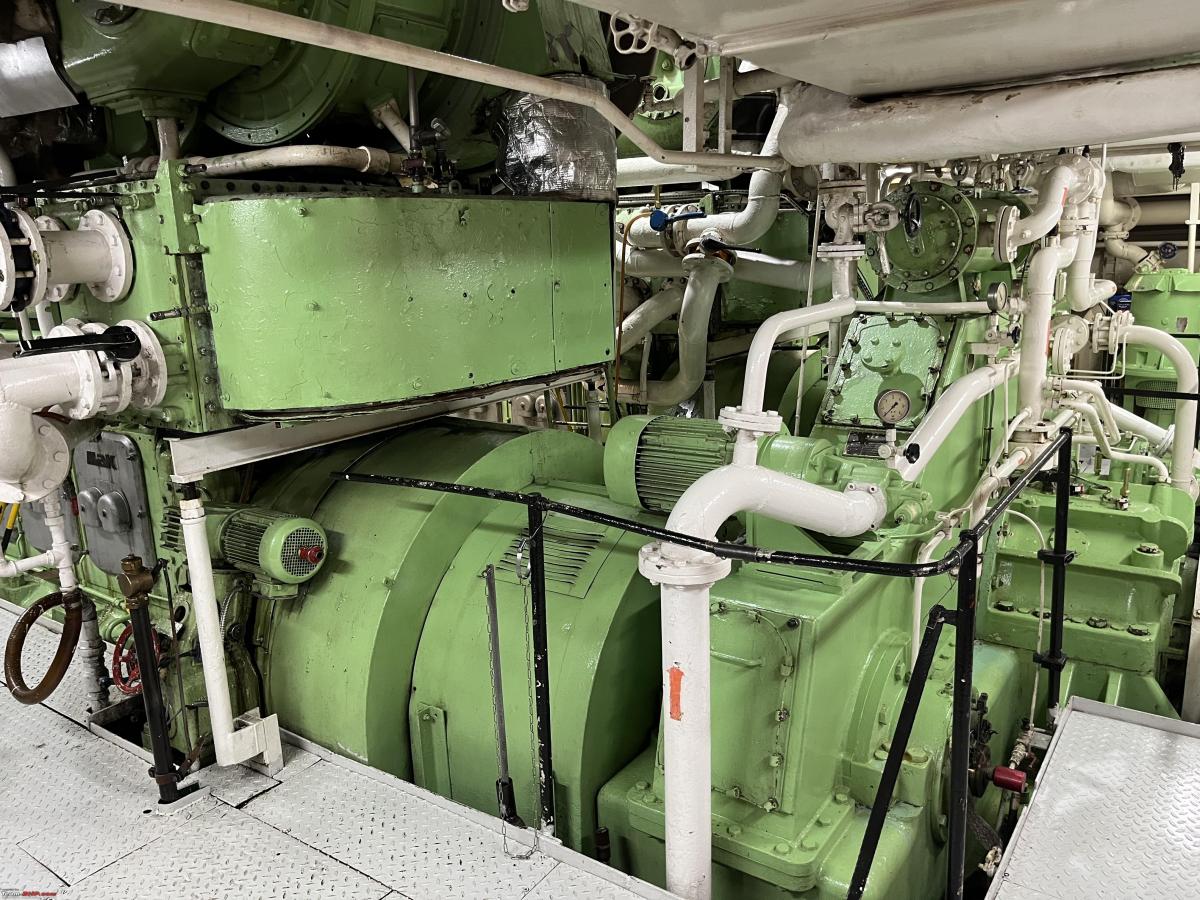
One of the propellor shafts going aft.
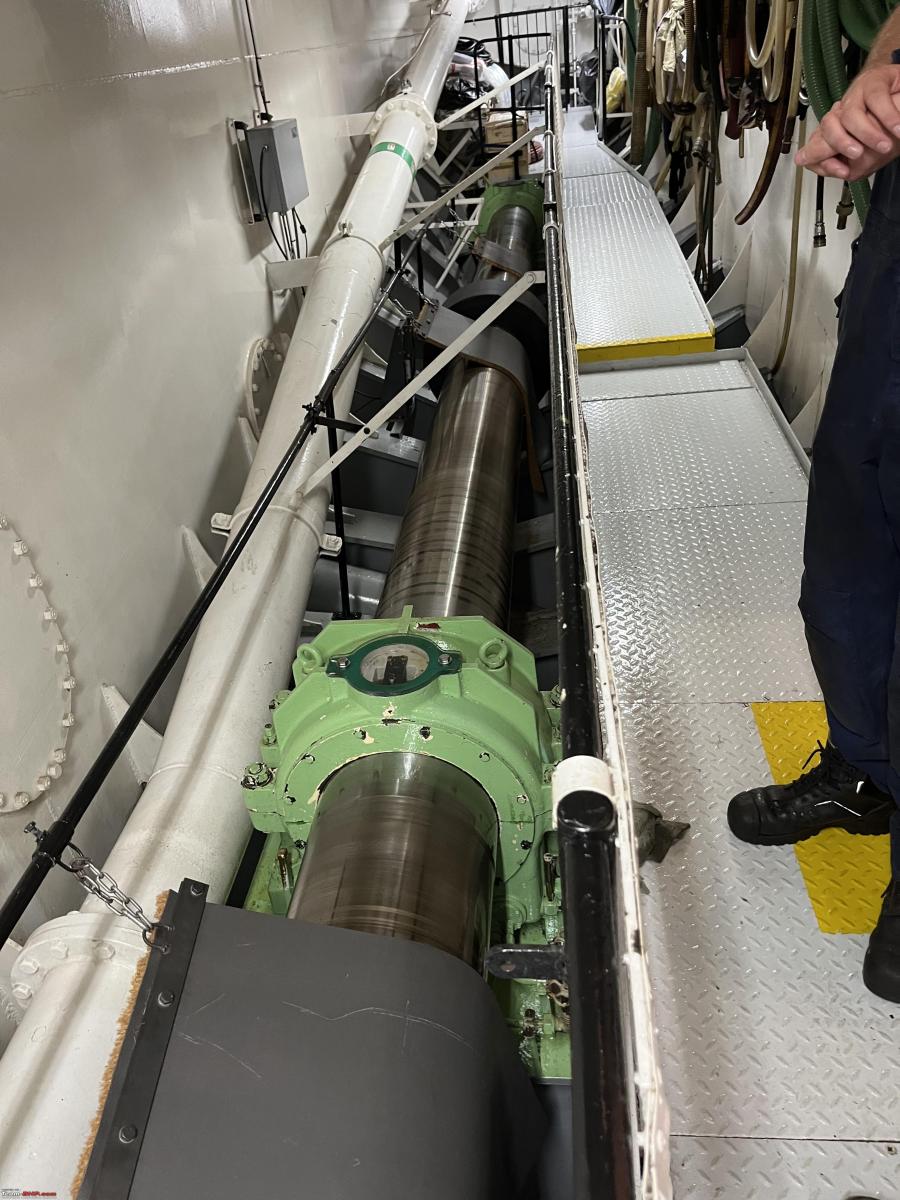
Also, four, again identical, MAN auxiliary diesel engines driving a generator each.
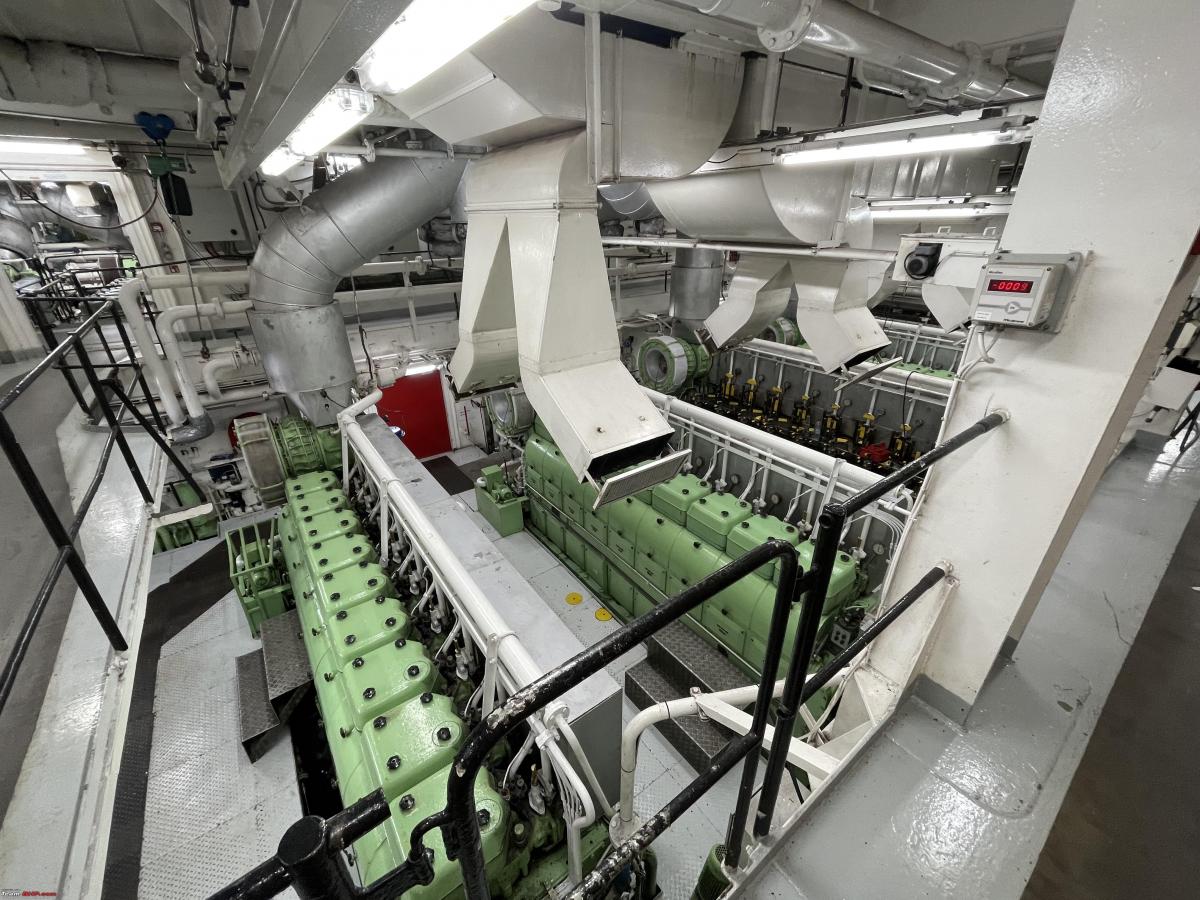
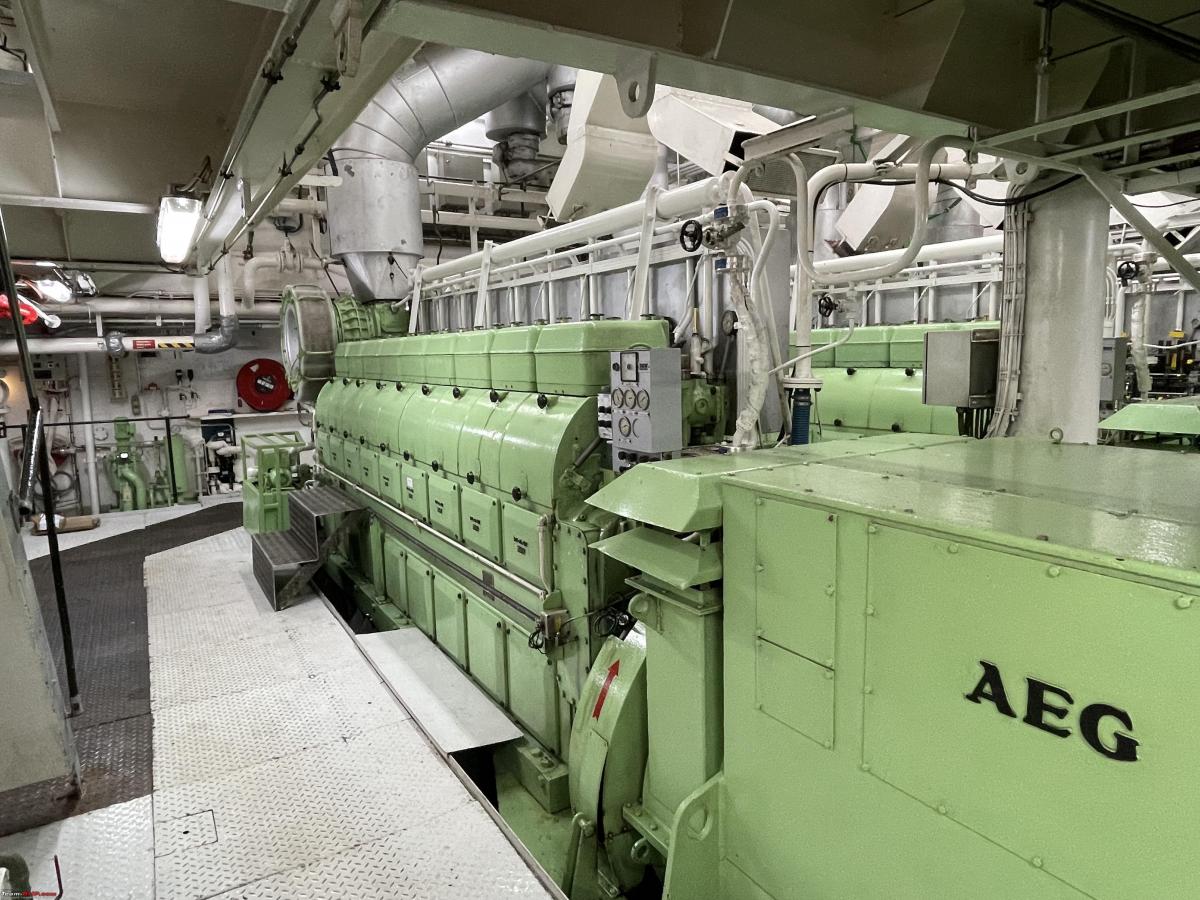
One of the four auxiliary engines was having a major overhaul done. Which means pulling all cylinder heads, cylinder liners, pistons, fuel pumps etc. For these big jobs, a factory team of engineers joins the ship's engineers. They will also bring additional spares. It is not that the engine room team can't do these sorts of jobs. It will just take too long.
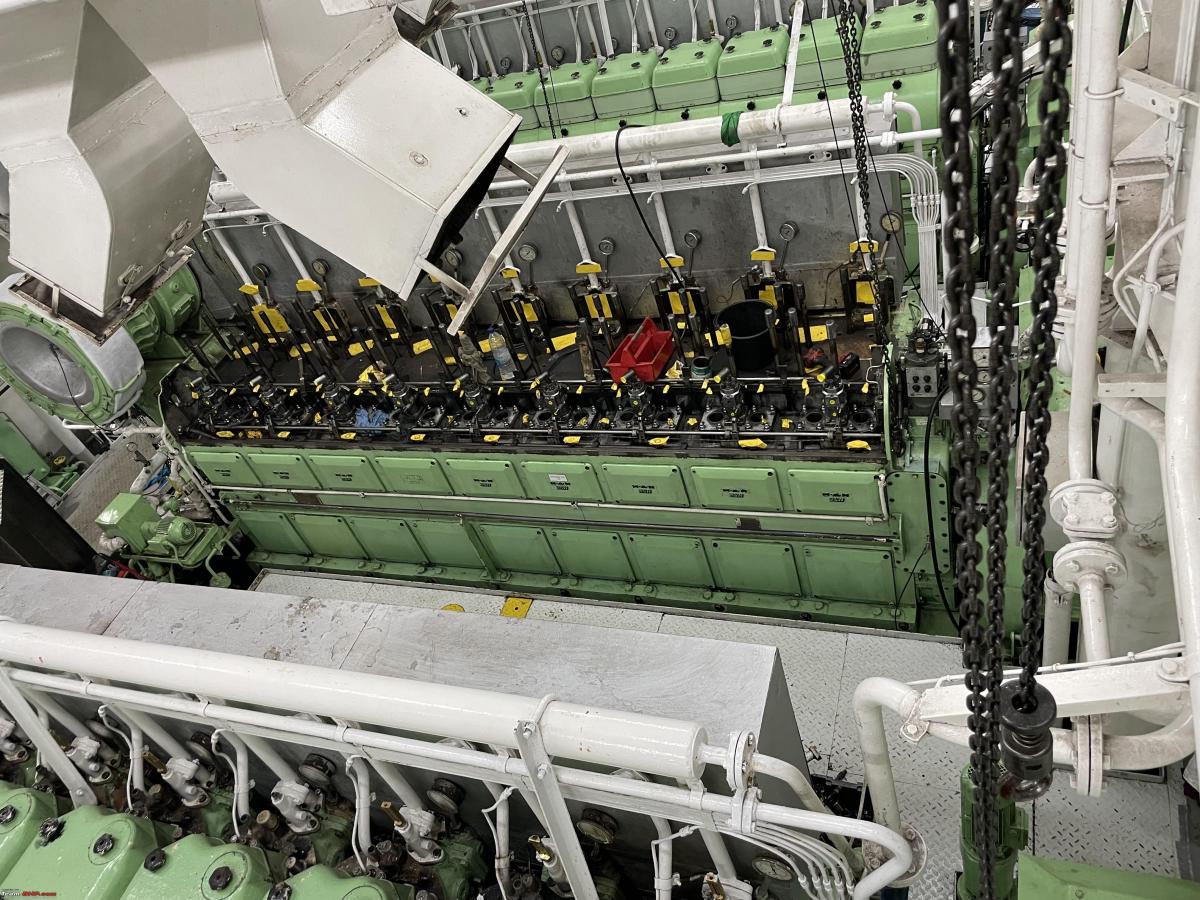
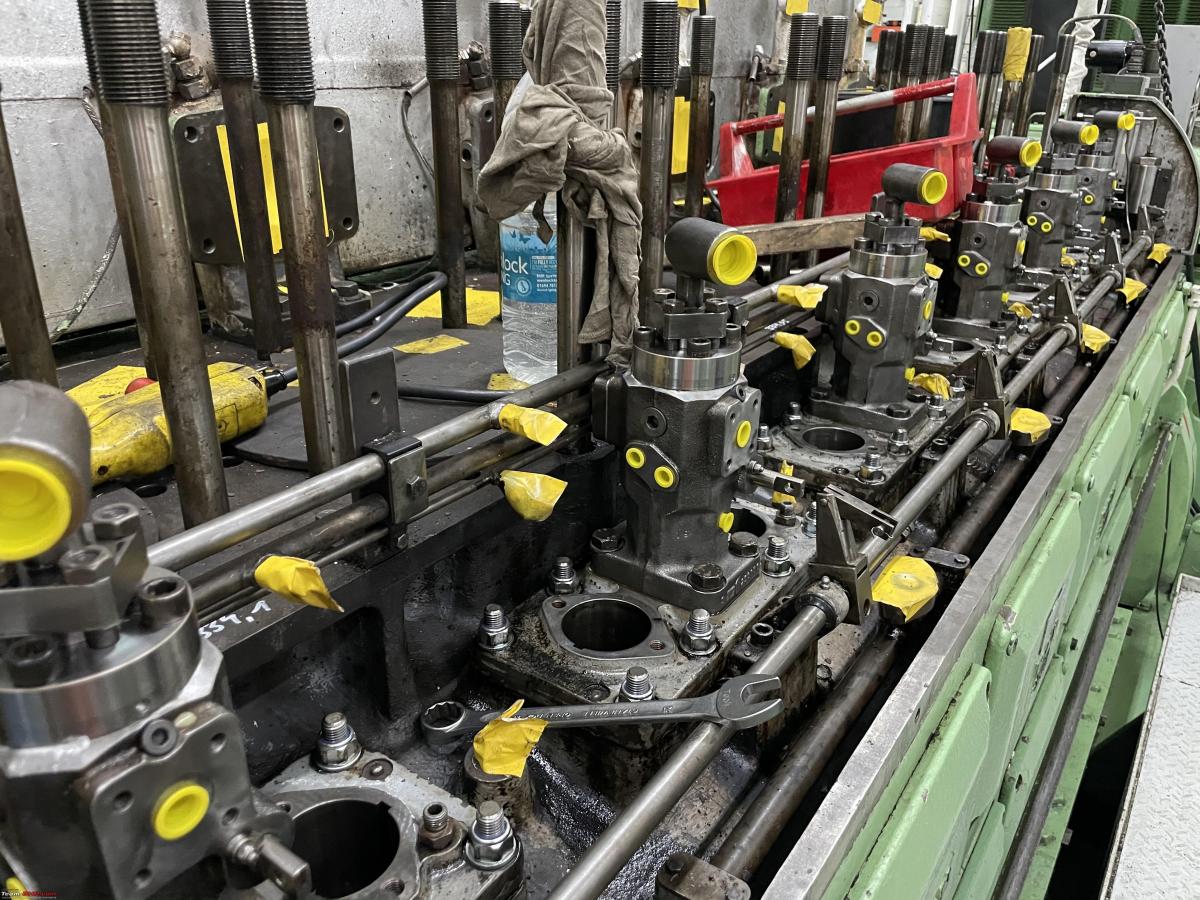
Ships always carry a large amount of spares. There are both insurance and legal requirements on the amount and what kind of spares to have onboard. Here are some cylinder liners and pistons.
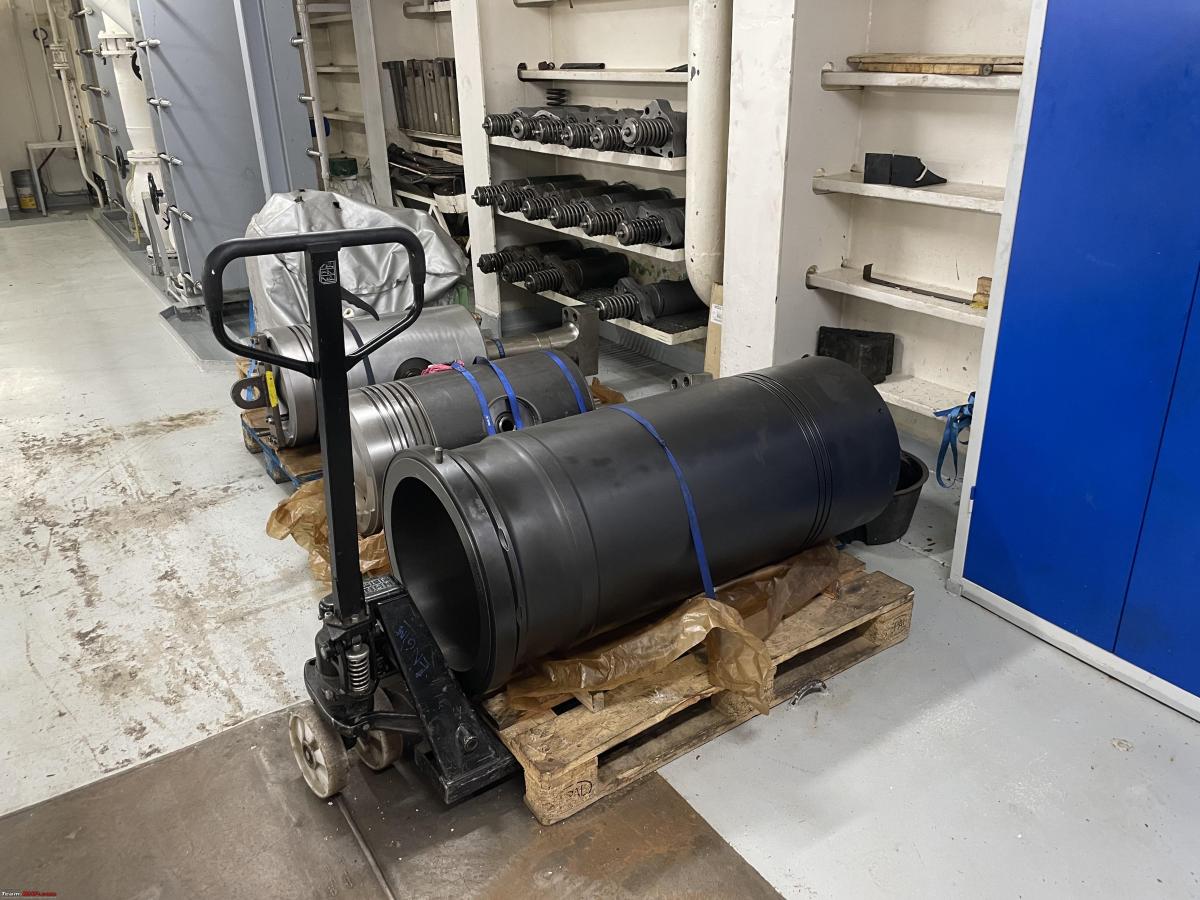
Here we have Peter and yours truly posing next to one of the main engines.
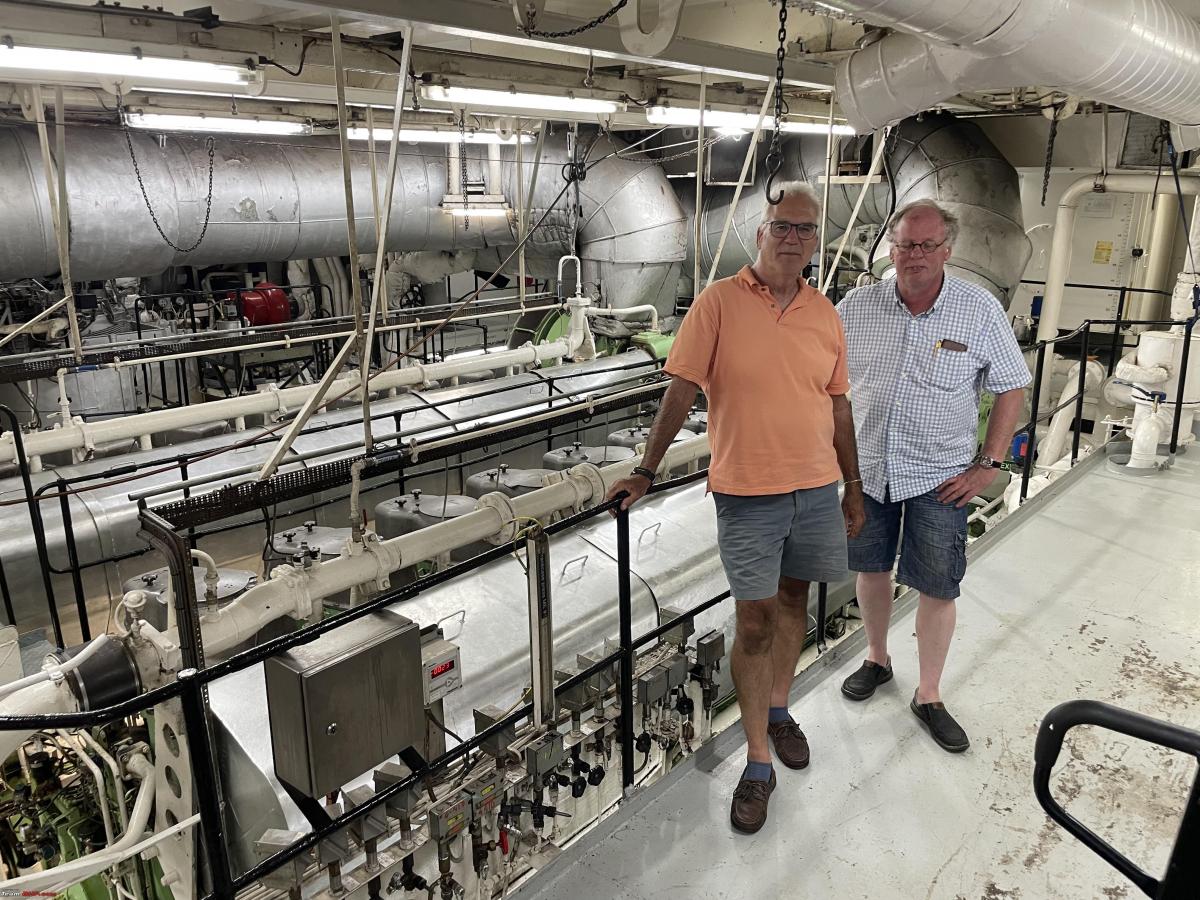
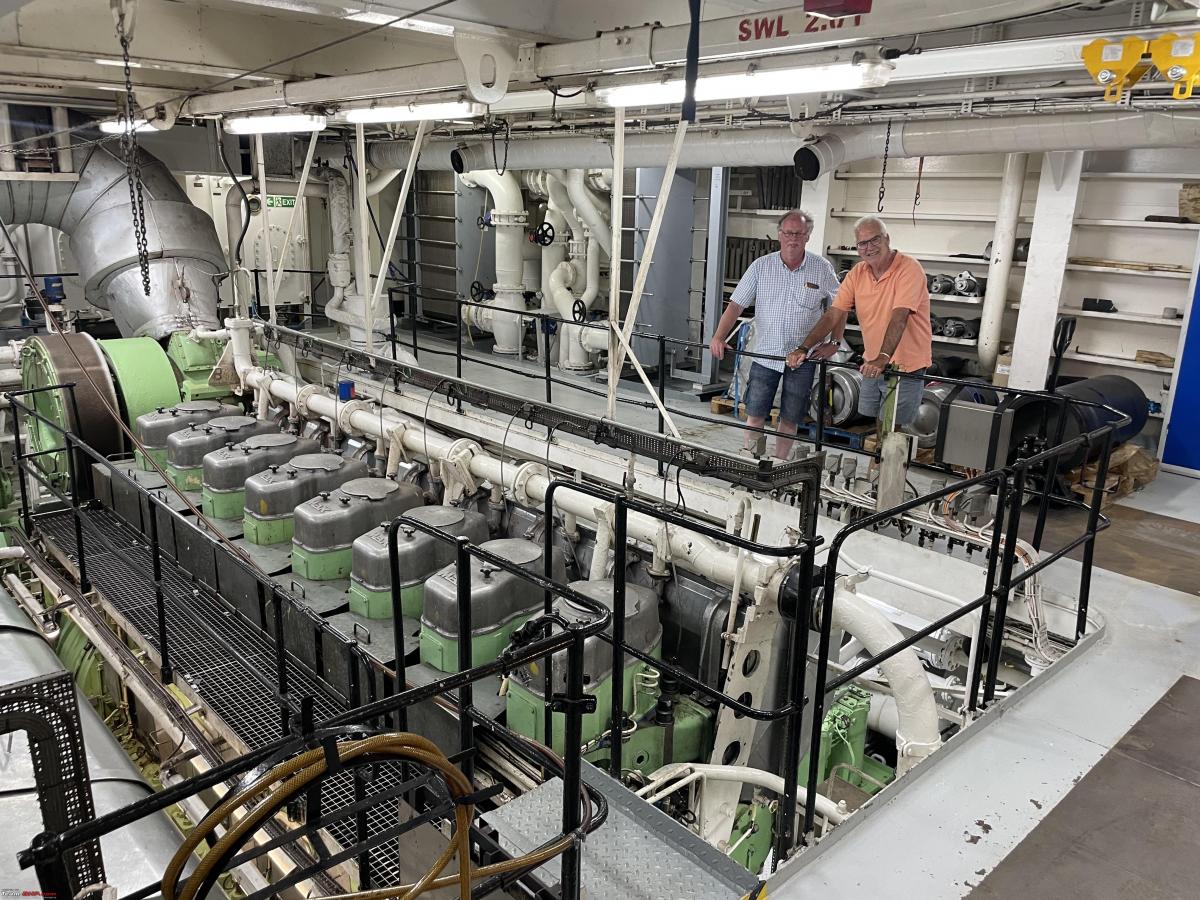
These are the separators. They are for continuous cleaning of lubrication oil and fuel and also remove any water content.

One of the Airconditioning plants
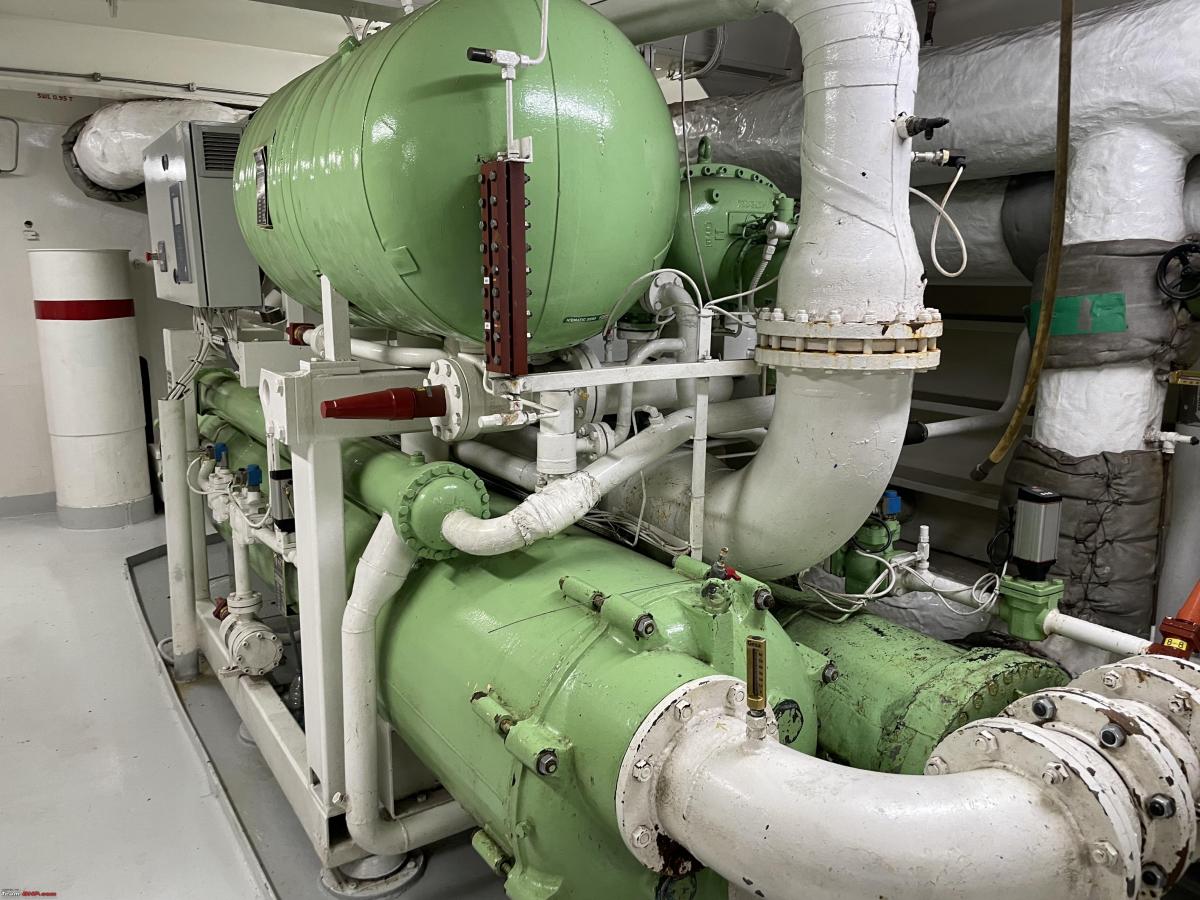
The desalination plant for making all the freshwater onboard.
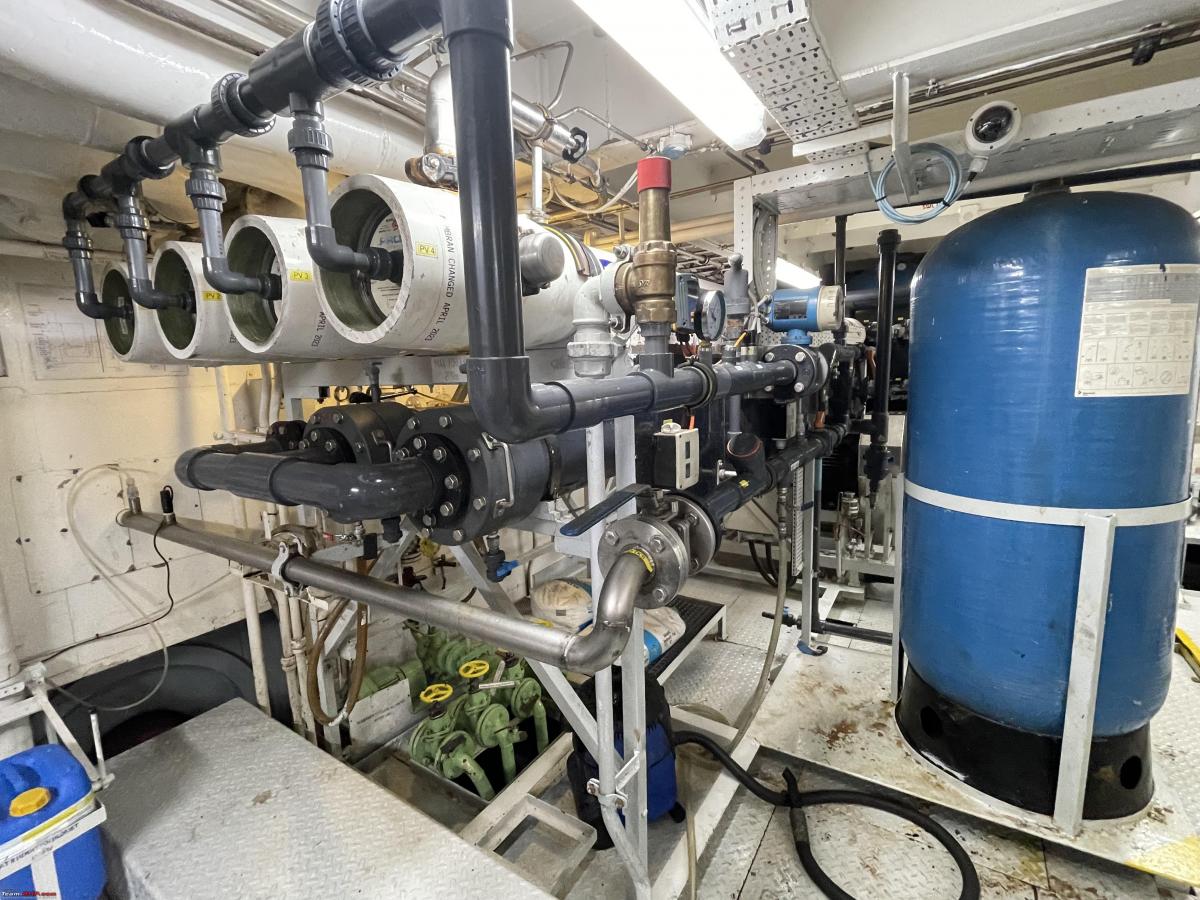
This is one of the fire pumps (the red one). The second engineer told us, that in case of a fire on the car deck, this one will pump water to the sprinkler system. (Good thing we had parked our Spiders with the hood up!)
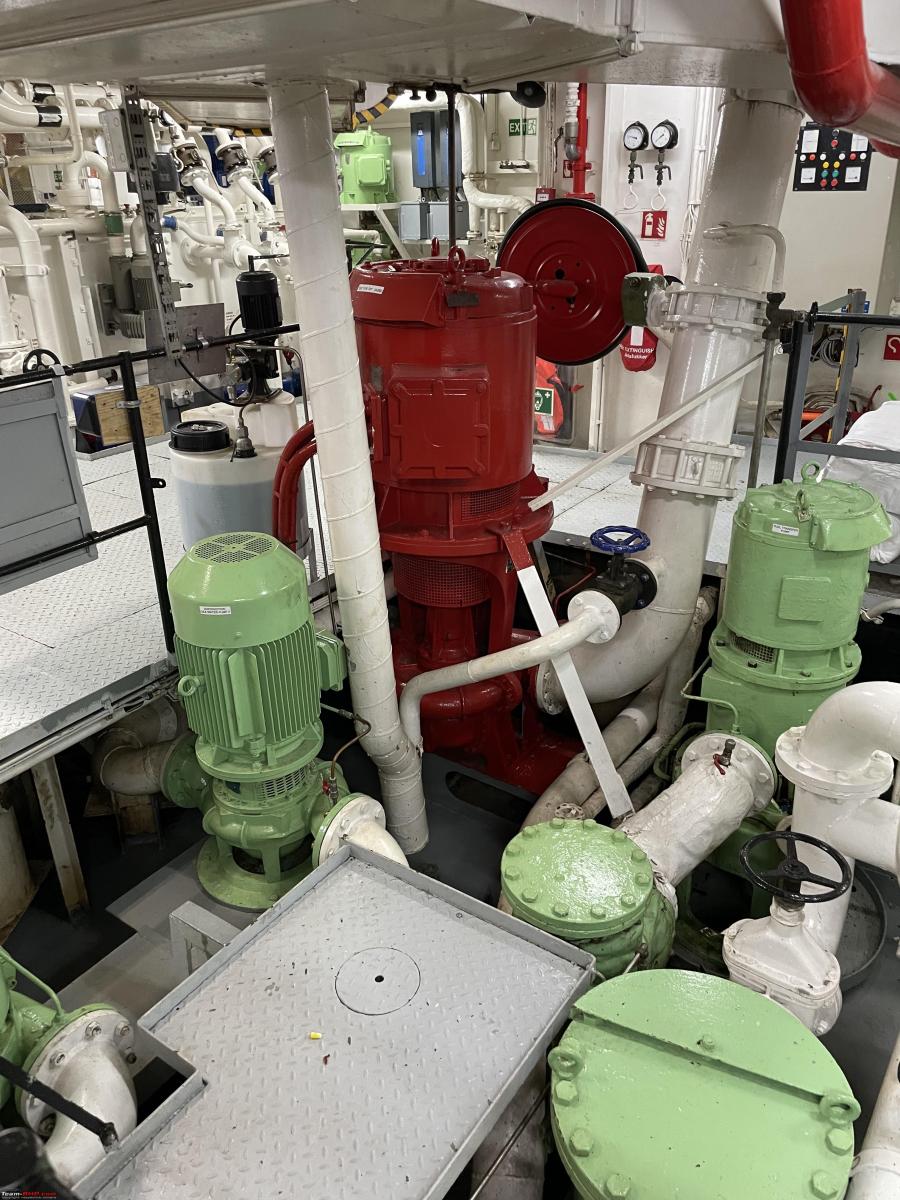
Finally, a very nice, roomy and well-equipped workshop!
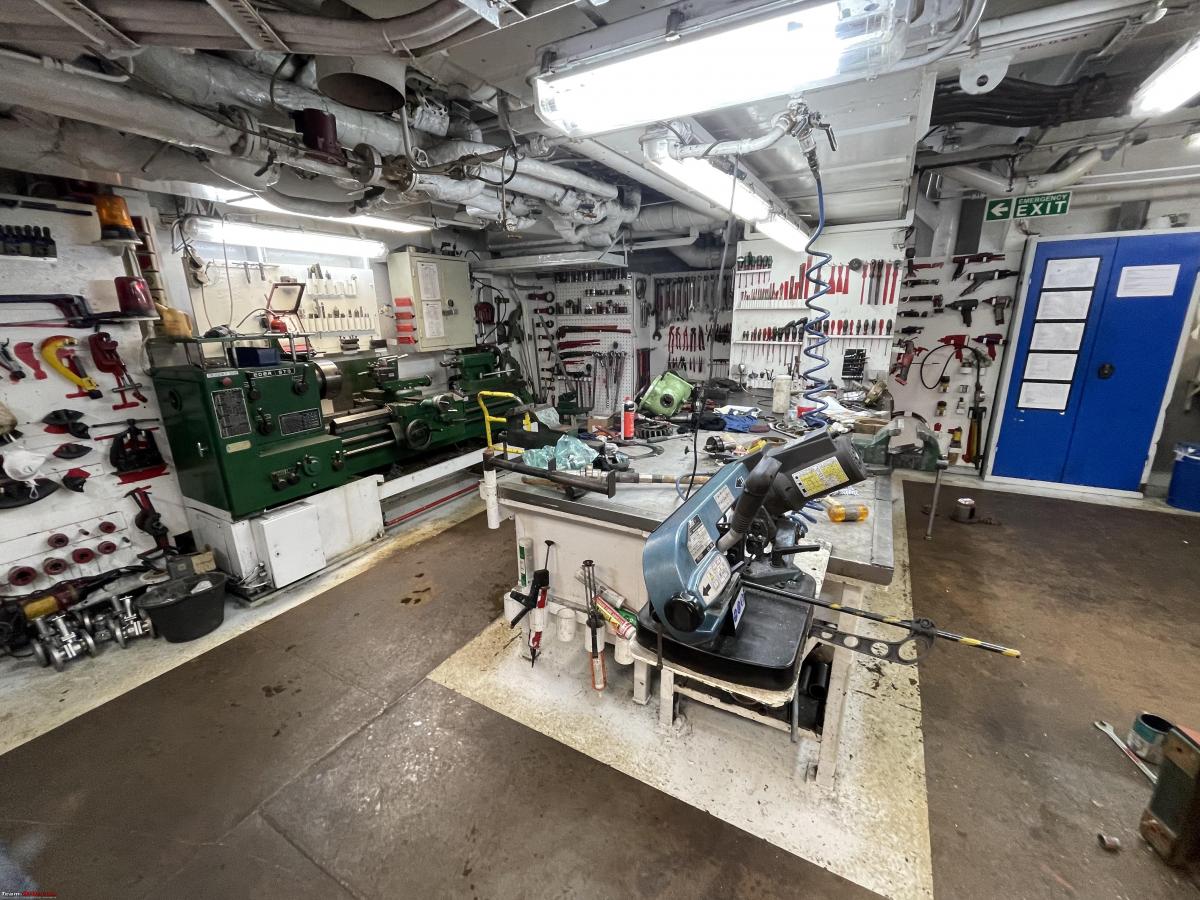
After about an hour we had returned to the control room and talked some more. Many thanks to the DFDS engine room team for showing us around and compliments for a very nicely kept and maintained engine room.
We went back on deck, a very calm sea.

Some years ago the UK did away with the rules for quarantining animals. Up till then, it was simply not possible to take animals with you to the UK. But since this rule has been lifted all ferries have animal kennels on board. Look at this fire hydrant in the dog kennel!
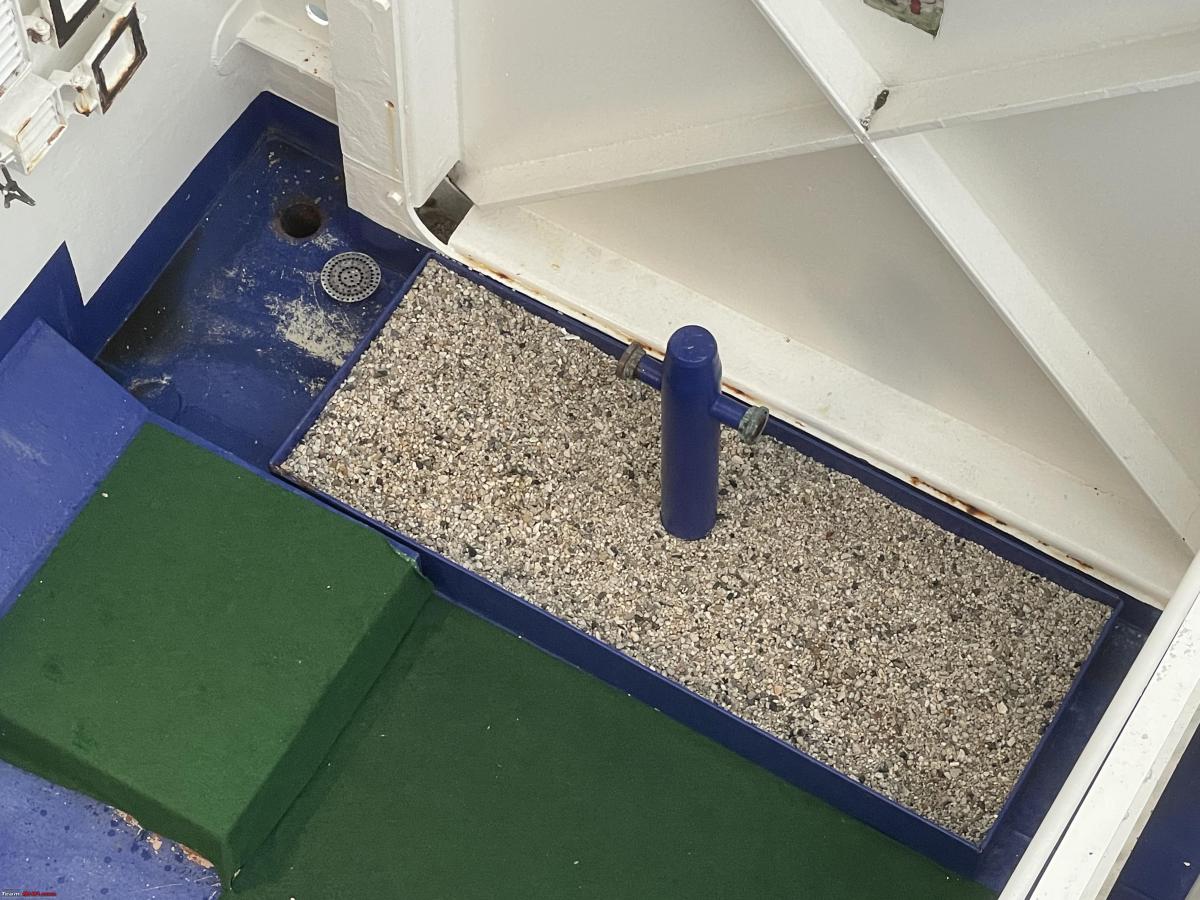
The next morning we had a BIG excellent breakfast. After breakfast, we planned our route for the morning. We usually have a paper map, with sufficient detail (better than 1:30.000) and program our route into our TomToms.
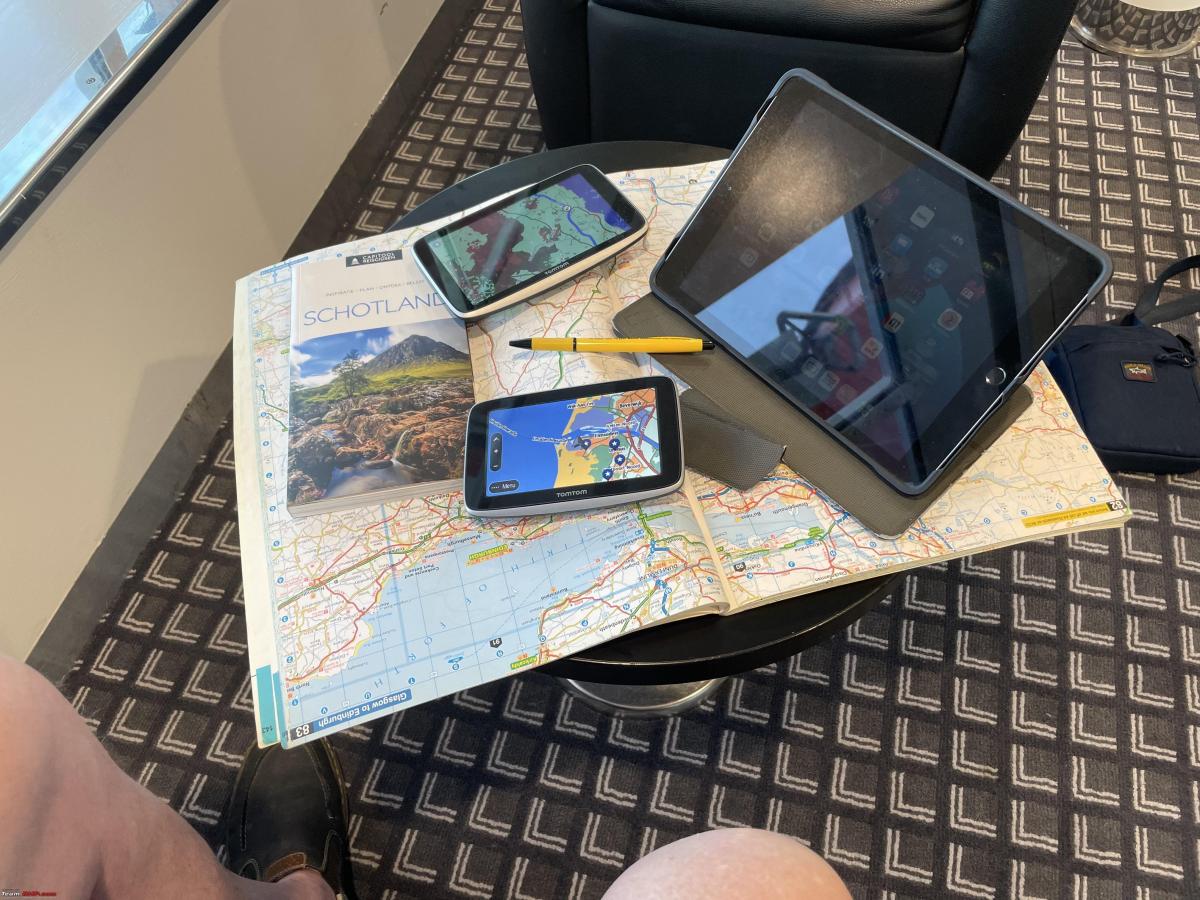
Getting off the ferry was a bit of a problem. The ship has numerous car decks. Deck 3 is the main deck, deck 4 is above deck 3 and there are hydraulically operated ramps for the cars to get from deck 3 up to deck 4. Deck 5 is sort of on the starboard and port side of the ship. Getting onto and off deck 5 needs the ramp of deck 4 up. Just our luck; A German camper got stuck on the ramp of deck 4. Initially, it would not start. So they managed to find a big enough jump-start unit. It started but stalled again. Eventually, they simply raised the ramp with the German camper still on it, so we could drive off the ferry.
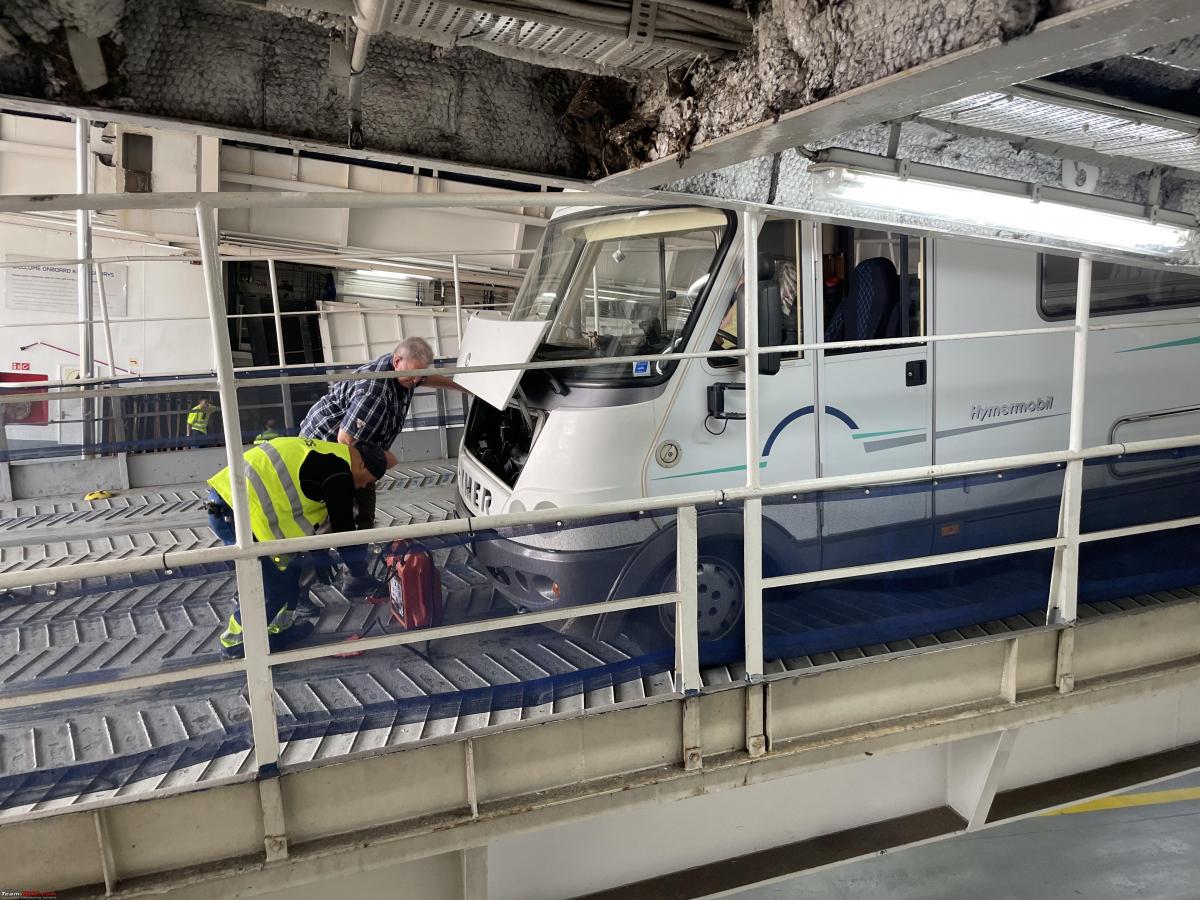
These things can't be helped, but it gave us a delay of almost an hour and a half.
Continue reading about Jeroen's travel experience for BHPian comments, insights and more information.
News
What happens to the retired ships: Ship breaking industry in India
The Alang Ship Breaking Yard in Gujarat is one of the largest ship-breaking yards in the world. If a ship is not broken, it might be used for other purposes.
BHPian Aditya recently shared this with other enthusiasts.
Like all machines, ships too become old and have to be retired from service. So what happens to a vessel after it has finished serving its employers?
Cars that are too old to run are taken to scrapyards, while aircraft are sent to sites called boneyards or graveyards. Similarly, ships go through a process called ship-breaking. In this process, ships are disposed of by breaking down for either a source of parts, which can be sold for re-use, or the extraction of raw materials, chiefly scrap. The steel from the ship can be recycled for use in the manufacture of new products which lowers the demand for mined iron ore and reduces energy use in the steelmaking process. Many other fittings can also be reused.
Ship breaking:

Image: Wikimedia
The Ship Breaking Industry in India initially took off in Kolkata and Mumbai. While many other ports subsequently began ship-breaking, they eventually declined. At present, the Alang Ship Breaking Yard in Gujarat is one of the largest ship-breaking yards in the world. It is claimed to scrap more than half the ships of the world.
Alang ship breaking yard:

Image: CruseMapper
Set up in 1982-83, the Alang Ship Breaking Yard is located in the Gulf of Khambhat in the state of Gujarat. It has the largest share of all in the global ship-breaking industry. It is claimed to consist of 183 ship-breaking yards spread along 14 km of coast and employs close to 40,000 people. All kinds of ships including oil-gas tankers, box ships (container carriers), bulk-cargo carriers, Ro-Ro (car ferries), passenger ships (ferries and cruise liners) and naval ships are brought here for breaking.
A ship being beached:

Decommissioned ships are towed and beached at the shore which resembles a yard. They are then dismantled by the labourers almost manually. The bow or the front portion of the vessel is dismantled first. This provides ventilation within the vessel for the dismantling of the remaining hazardous parts. The materials are then sold as scrap.

Image: DownToEarth
Ship breaking is a tedious process involving a lot of complex issues like ecology, labour health, and safety. It involves immense risk since the vessels generally carry explosive materials like oil and gas.
Ship breaking is done manually and is hazardous:





Images: GCaptain
If a ship is not broken, it might be used for other purposes. Naval ships may be converted into museums or used for research. They may also be sunk as artificial reefs or as targets during naval exercises.
INS Chapal (K94) Warship Museum, Karwar:





Images: Daijiworld
Sources: Wikipedia 1, 2, MHS India
Check out BHPian comments for more insights and information.
- Tags:
- Indian
- Boats and Ships
- Cargo Ships
News
Experienced a Concorde, nuclear submarine & more at the Intrepid Museum
The museum has a deck and hanger full of interesting aircraft and a space shuttle in an enclosure.
BHPian Foxbat recently shared this with other enthusiasts.
Living in NYC does have some drawbacks (insane rents, taxes, crime) but one of the biggest plus points for me is having this across the street:
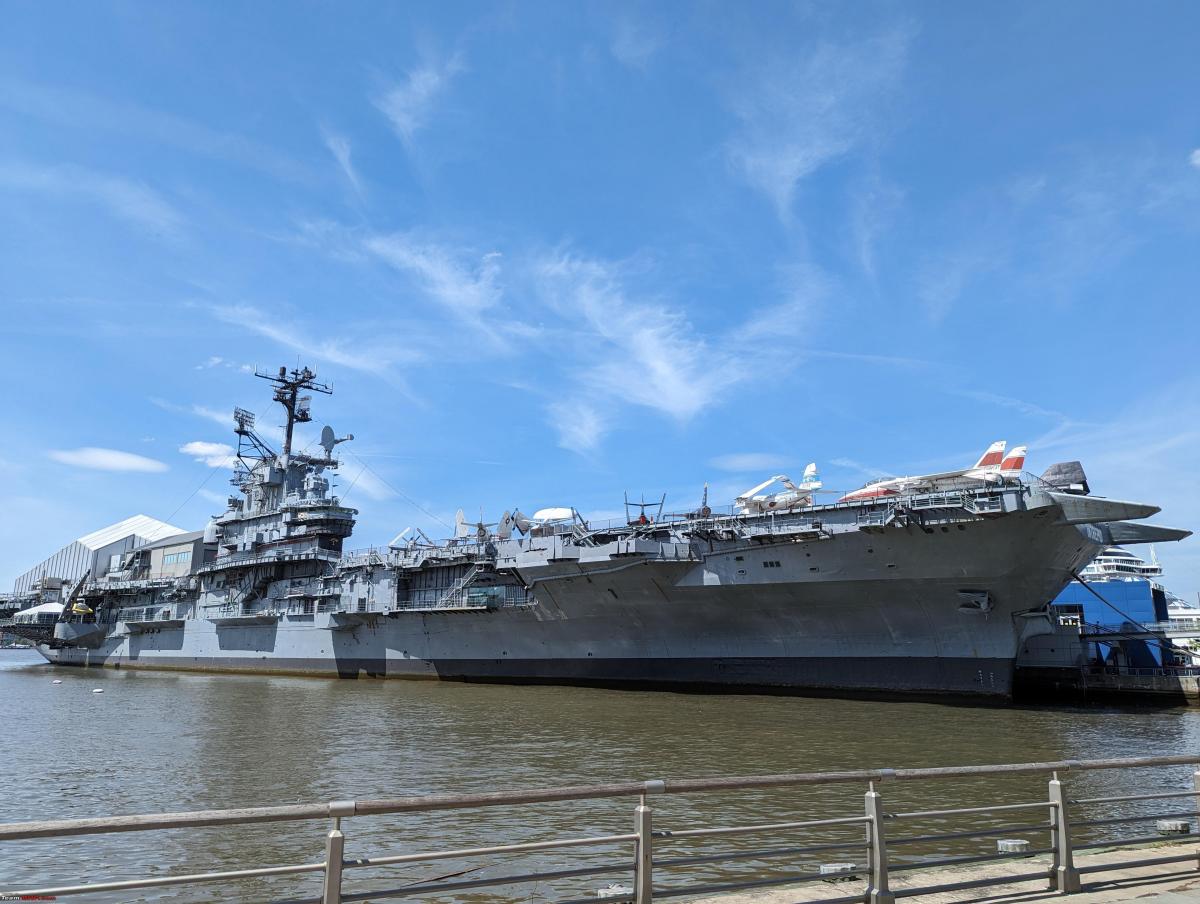
Launched in 1943, the former aircraft carrier USS Intrepid fought in World War II, surviving five kamikaze attacks and one torpedo strike. The ship later served in the Cold War and the Vietnam War. Intrepid also served as a NASA recovery vessel in the 1960s. It was decommissioned in 1974, and today is berthed on the Hudson River as the centerpiece of the Intrepid Sea, Air & Space Museum.
About 30+ years ago my family lived about 1.5 hours drive from here and I had asked my dad to bring me here many times however the trip never materialised. Never imagined one day I could walk across the street to visit it.
The museum has a deck and hanger full of interesting aircraft and a space Shuttle in an enclosure as well as a retired submarine and Concorde parked next to it.
Some aircraft on the deck:
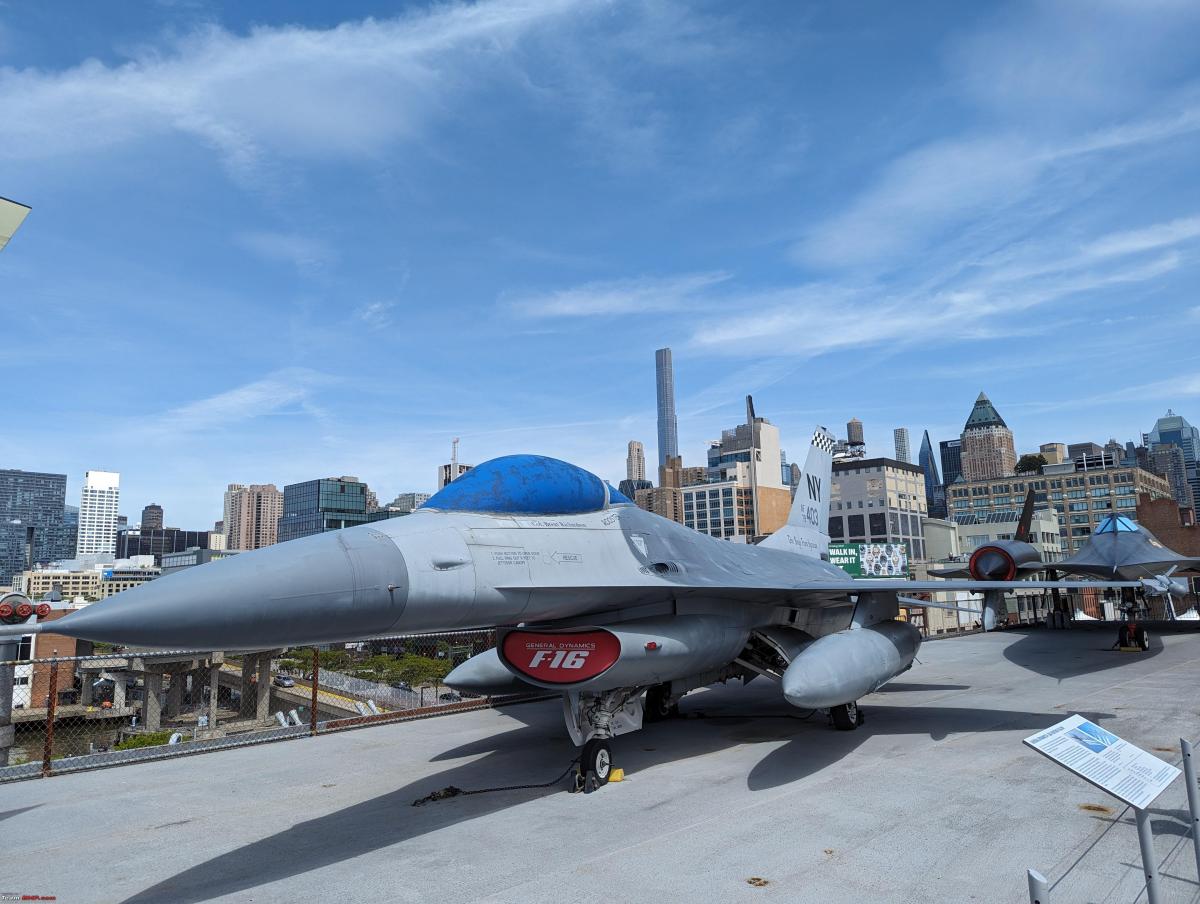
F-16 Falcon
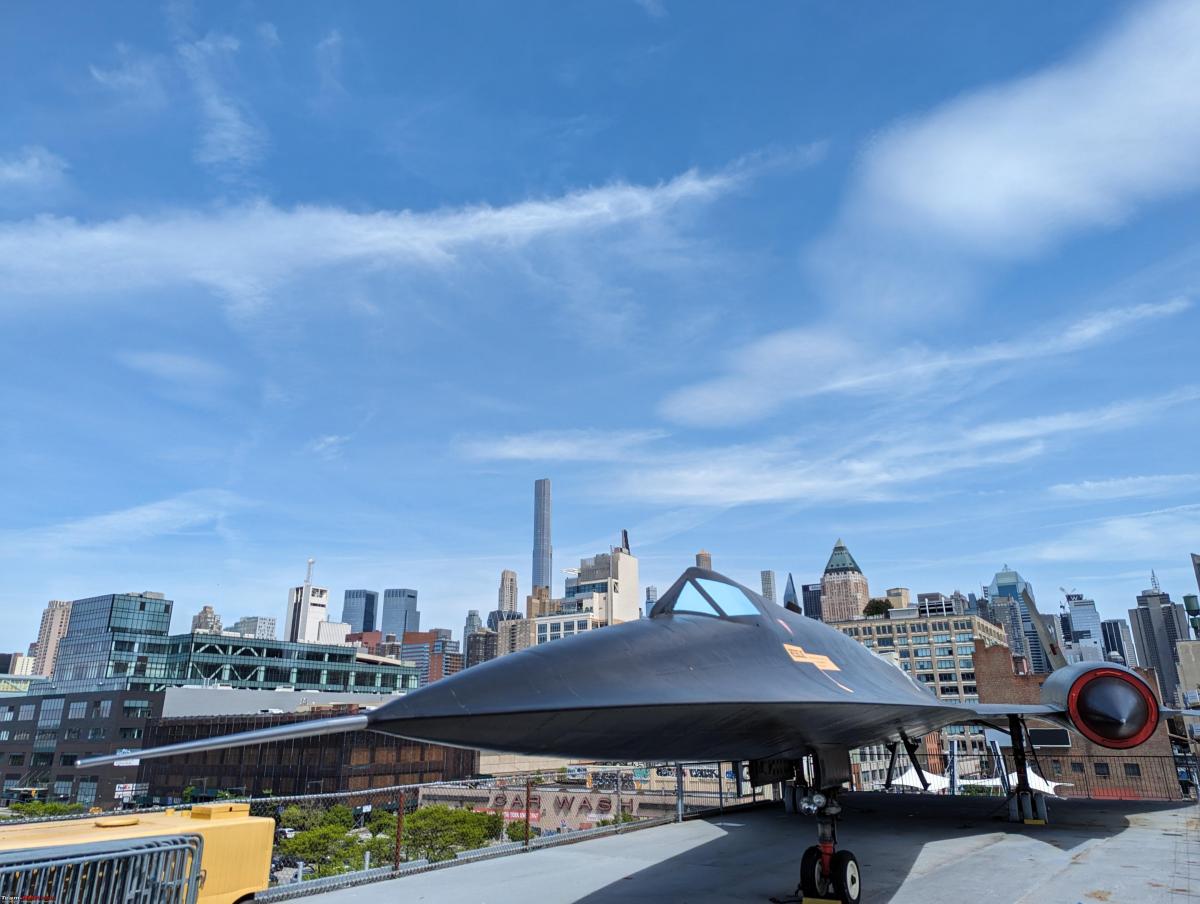
A-12 (predecessor to the SR-71 Blackbird)
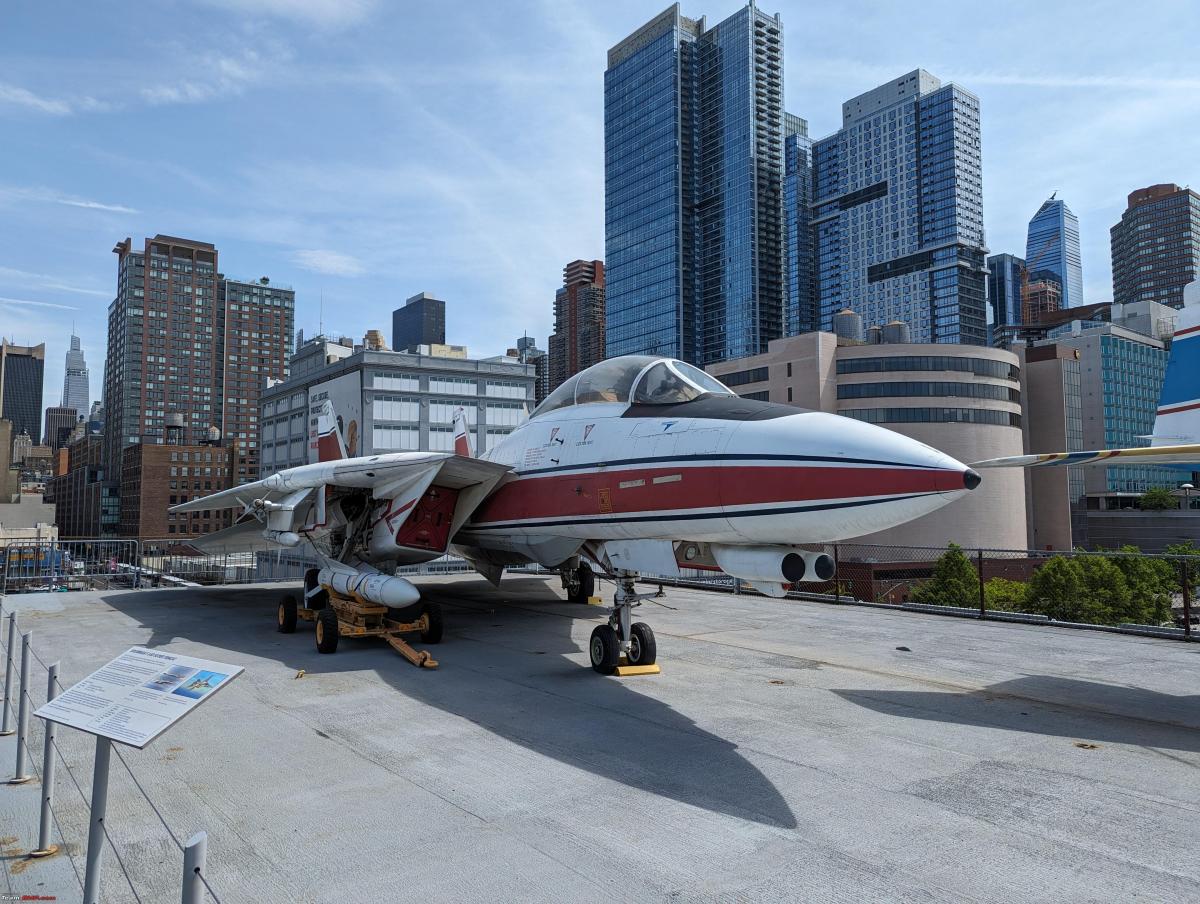
Experimental F-14 Super Tomcat

A-6 Intruder

MCDONNELL F3H-2N (F-3B) DEMON
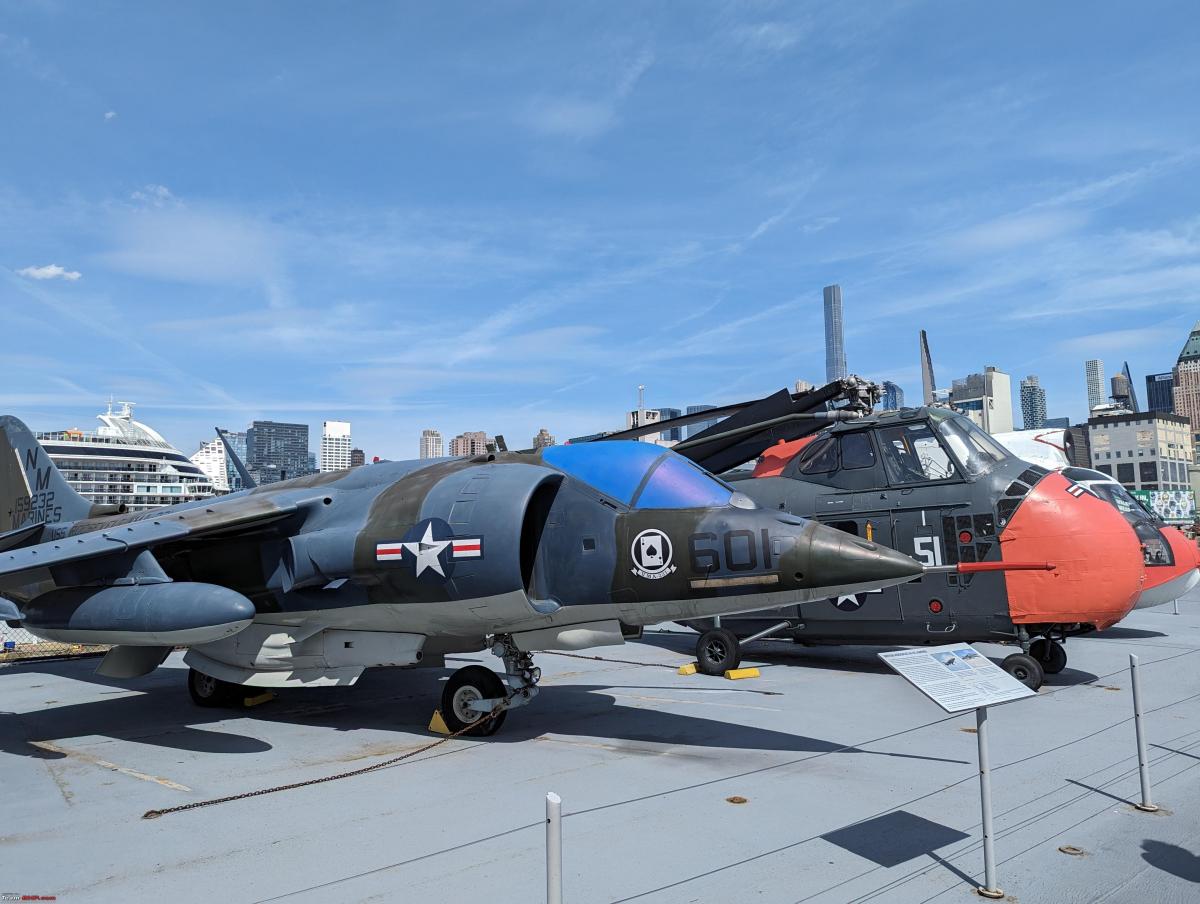
AV-8 Harrier
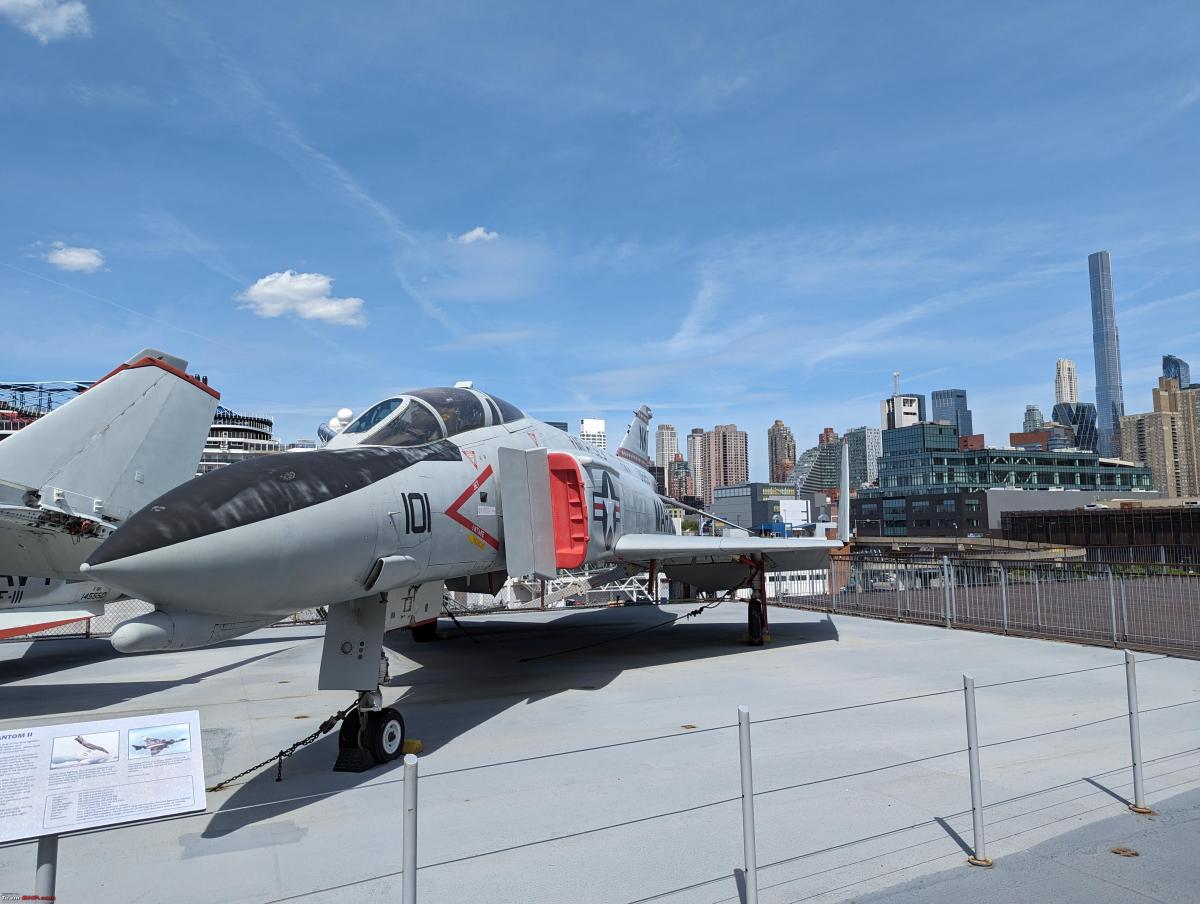
F-4 Phantom
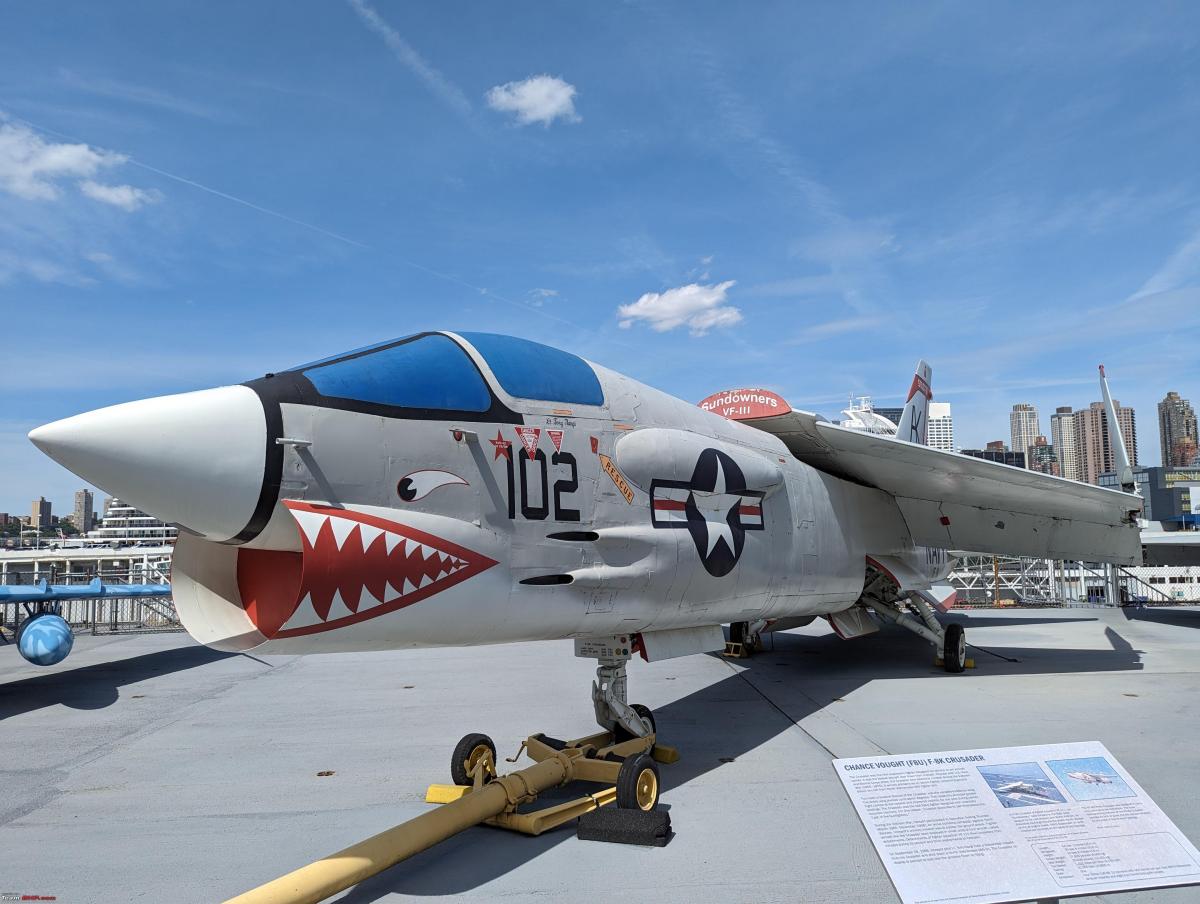
VOUGHT (F8U) F-8K CRUSADER
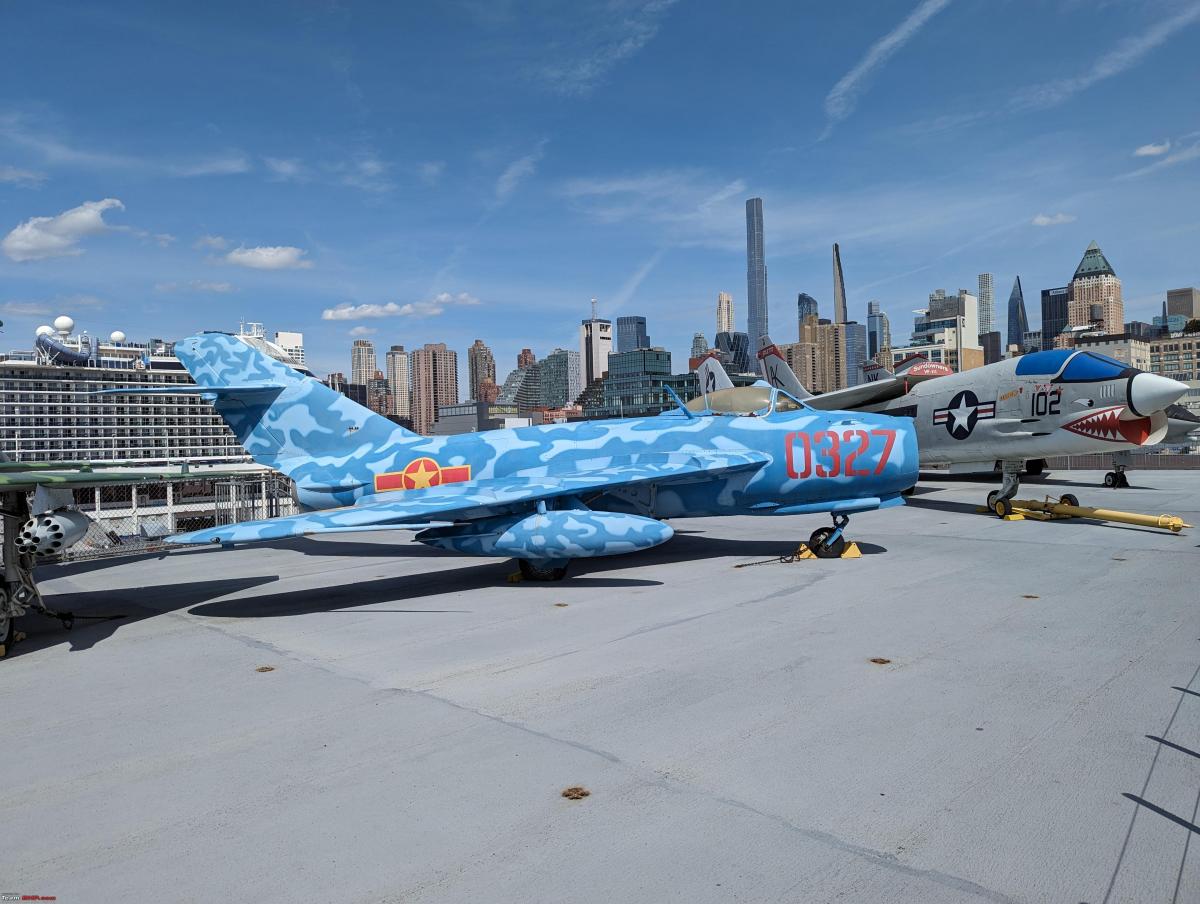
MIKOYAN-GUREVICH / PZL-MIELEC MiG-17 / Actually a LIM-5 painted in VPAF colours of a Mig-17.
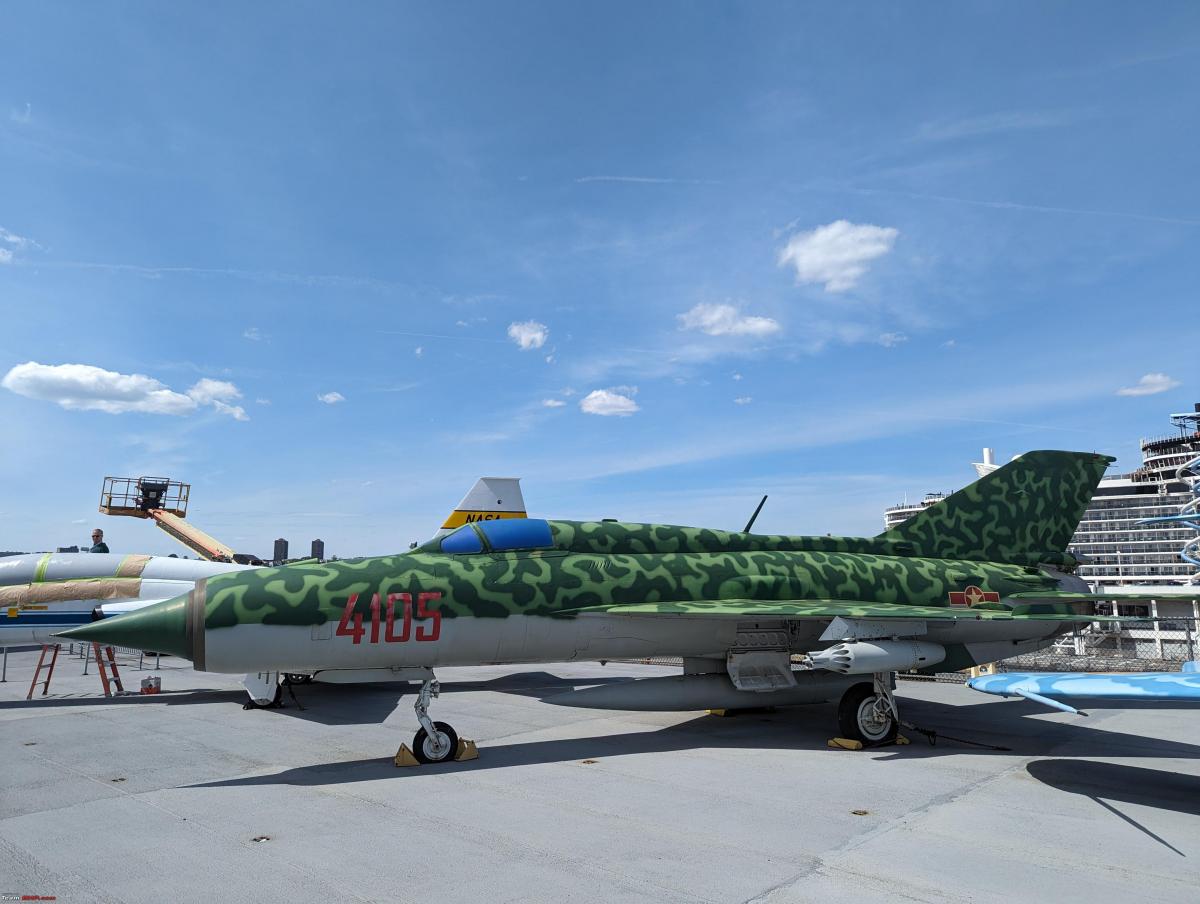
Polish Mig-21 also painted in VPAF colours

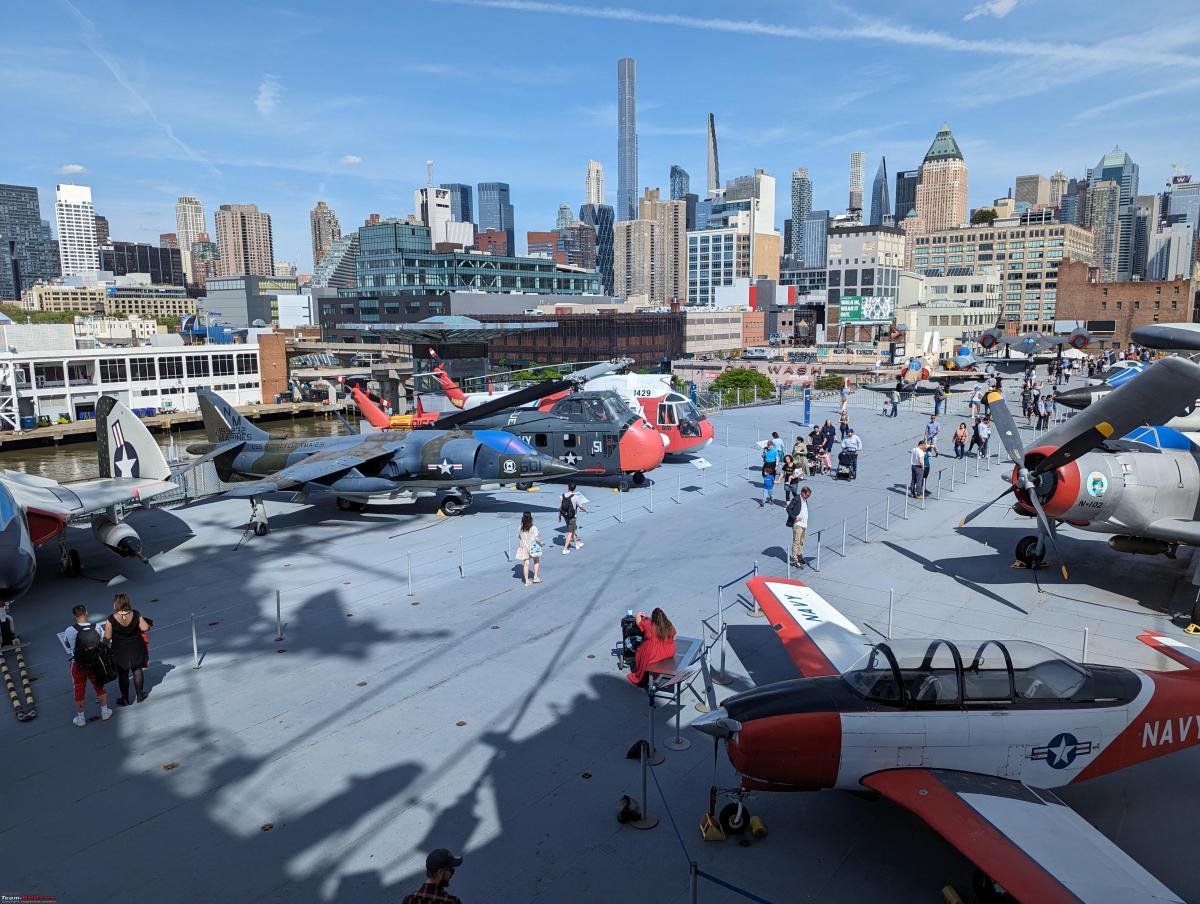
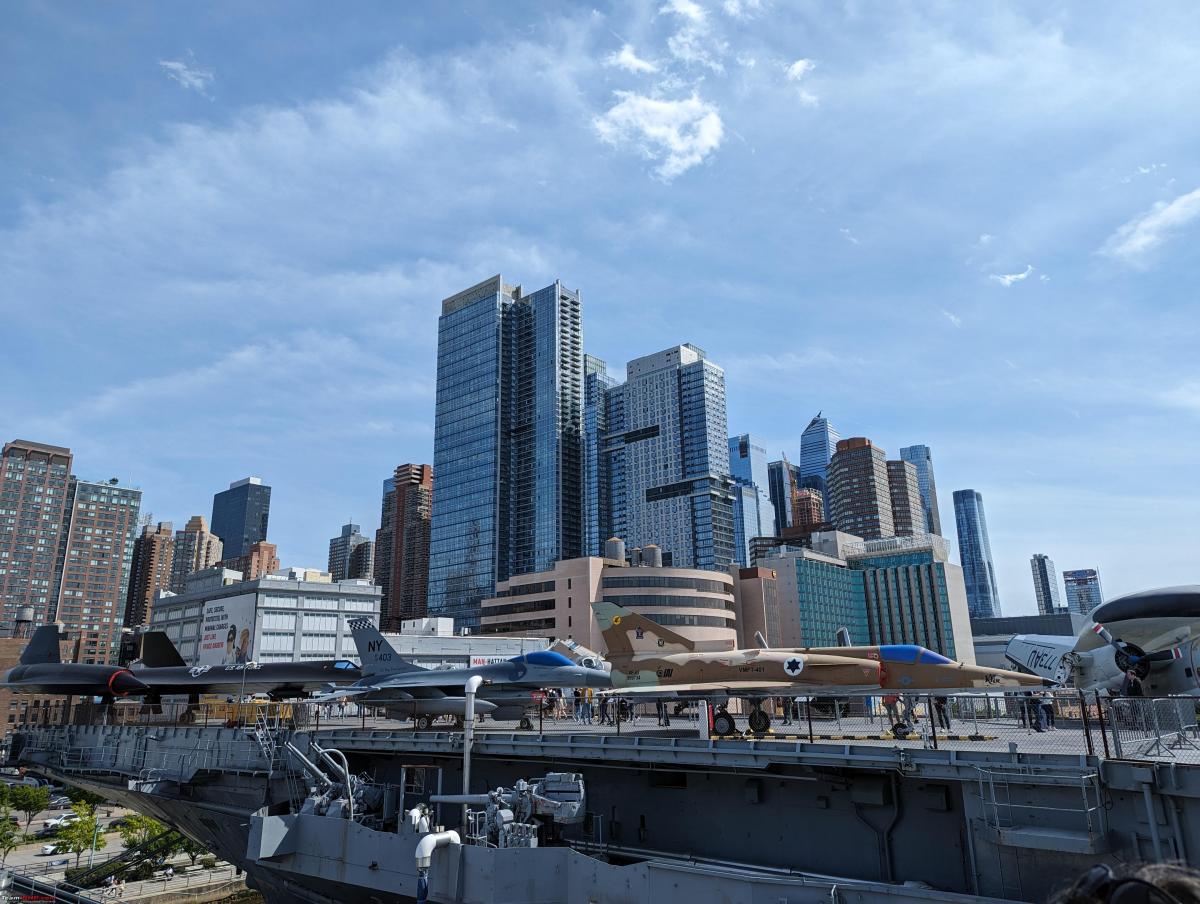
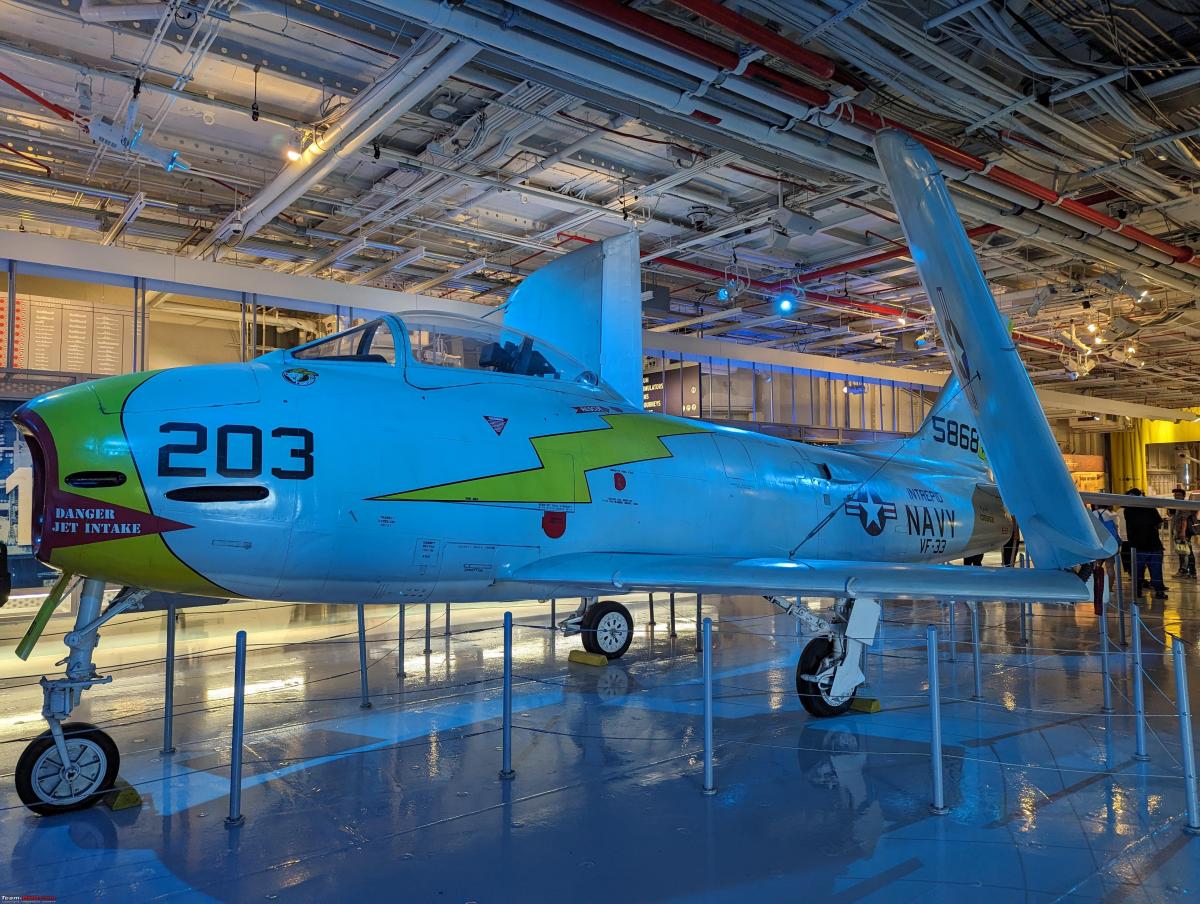
NORTH AMERICAN FJ-3 FURY
The Space Shuttle Pavilion showcases the space shuttle Enterprise, the prototype NASA orbiter that paved the way for the space shuttle program. The Enterprise never actually went into space and was used for tests.
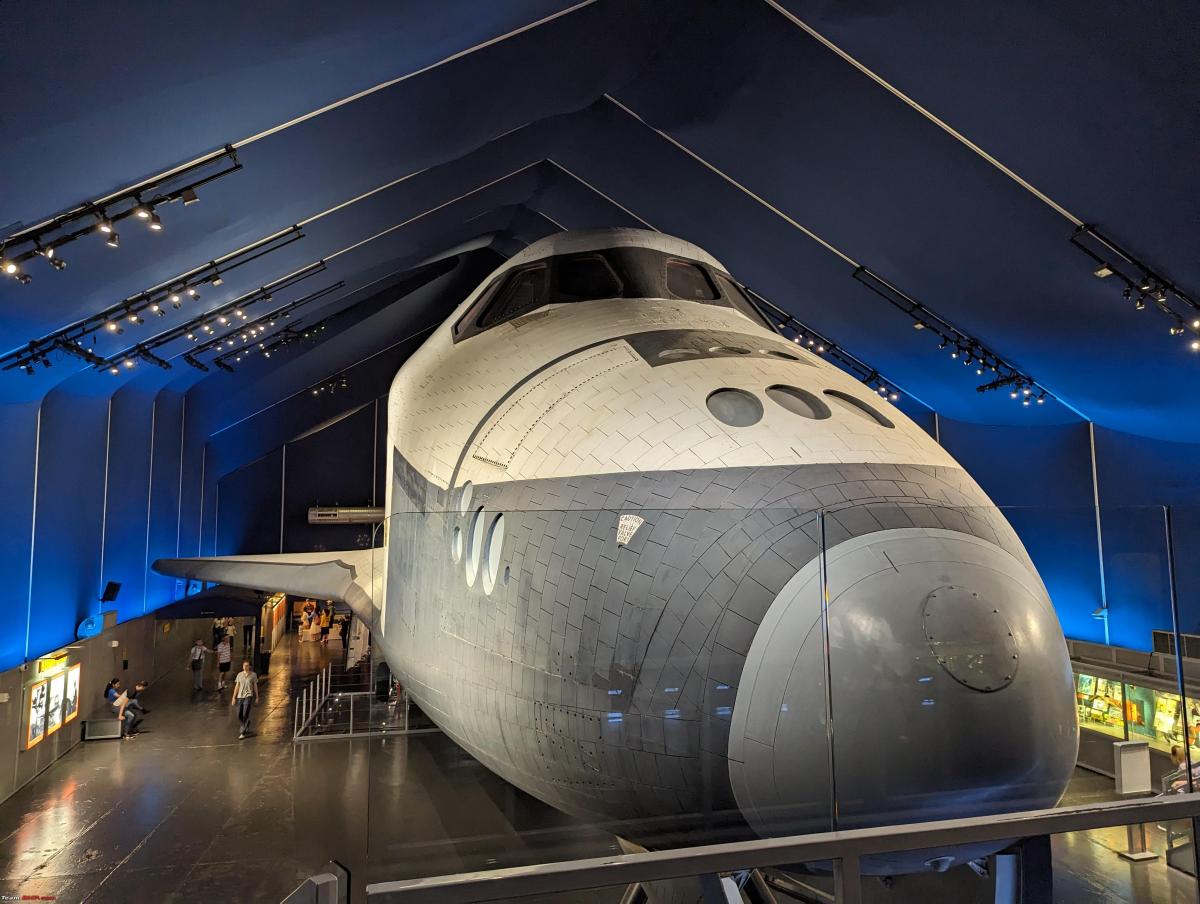
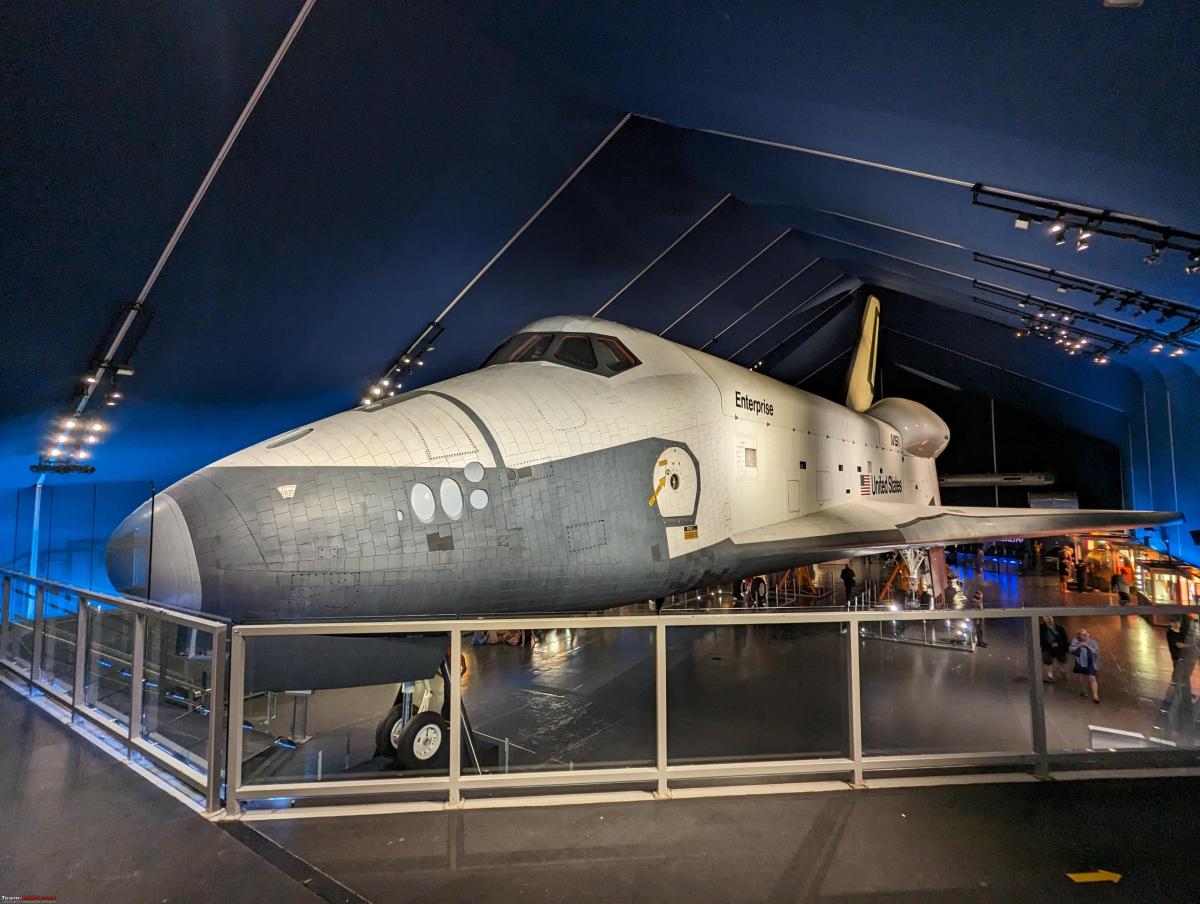
Continue reading Foxbat's experience for BHPian comments, insights and more information.
- Tags:
- Indian
- Aircraft
- Boats and Ships
- Museum
News
People recall their first experience with various modes of transport
Here the modes of transport are not restricted to cars, motorcycles, planes, boats or trains.
BHPian GForceEnjoyer recently shared this with other enthusiasts.
What was the first car you can remember riding in? The first plane you can remember flying on? The first boat ride you can remember? The first train you can remember traveling by? The first two-wheeler, the first bus and so on. And when did these experiences take place? I'll go first, here's my list.
Since I was born in 2006, my first memories will be much more recent compared to most members.
- Car: A 2006 Ford Fiesta 1.6 SXI. My first clear memories of it are from a drive to Nainital, Uttarakhand, on a freezing winter day in 2008.
- Plane: A Kingfisher Red ATR-72. This flight was from Delhi to Jabalpur in the year 2009. I distinctly remember the flight taking off just before sunrise and how the sky was dark on one side of the plane, while being a subtle orange on the other.
- Two-wheeler: An Activa. This was a rental in Goa in either 2009 or 2010.
- Boat: A Washington State Ferry. This was in the year 2011 from the Port of Seattle to Port Angeles. This was also my first time hearing of a ferry that could carry cars on it too!
- Train: Delhi to Jabalpur. It was an overnight journey from Delhi's Hazrat Nizamuddin station sometime in the year 2008.
- Bus: An SML Isuzu school bus/a red DTC bus. I'm not fully sure which came first.
I now invite all fellow members to post their memories and associated details below. Modes of transport do not have to be restricted to those mentioned above! And the greater the amount of detail you can recall, the better.
Here's what BHPian BoneCollector had to say about the matter:
With what my memory serves me right, I'll pen down my firsts -
- 2-wheeler - It was a white Bajaj Chetak of Dad in the early 80s. But my bicycle ride came in the late 80s when I rode it.
- Car - It was an Ambassador belonging to my maternal grandfather in the early 80s followed by Dad's Premier Padmini in 1996.
- Train - A short 30kms ride in a meter gauge train to my aunt somewhere in 1987 followed by an 1100 km ride in October 1987 when we had gone for admission of my brother in RIMC Dehradun.
- Bus - It was in 1984 as we had to travel to Patna frequently for some medical issues. I vividly remember crossing the newly inaugurated Mahatma Gandhi Setu.
- Flight - I took my first flight in October 2002 in Air Sahara from Bangalore to Delhi to Patna. It was a B737 and was offered a cold wet towel and a glass of Aam panna while the flight was on the taxiway. First ATR flight was in 2007 from Patna to Kolkata in Air Deccan.
- Boat - I don't like boat rides and can literally count on my fingers the times I've been on a boat. My first boat ride was in 1991 in Nainital.
Although I might have travelled in these transportation modes earlier than the time I've mentioned, these are what I remember.
Here's what BHPian Shreyans_Jain had to say about the matter:
Car: I recall rides in our PAL 118NE and the original Tata Sumo back in the early 90s. When the Esteem came home in 95, it felt like heaven.
Bikes: Dad had a Bajaj M80 and a Priya for factory use, we would often go for joyrides.
Flight: I flew alone from Delhi to Baroda when I was 5 or 6 years old. Those were different times when we could drop people off right at the boarding gates. I distinctly remember my grandfather handing me over to the air hostess at Delhi airport, making me memorise my father’s contact details all the way till there. Indian Airlines used to serve candies before takeoffs.
Boat: The ferry from Gateway of India to Elephanta Caves.
Truck We had a blue colour DCM Toyota truck for factory use, dad would occasionally send us for joyrides.
Train A narrow gauge line from the princely state of Baroda, it ran from the village of Jambusar to the city. My father would make us take this train and explain its historical significance. Little me used to hate it, the train used to take twice as long as our car. Not sure if it is still in operation today. Otherwise, we were regulars on August Kranti Rajdhani and Paschim Express trains, Delhi to Baroda.
Bus experience came much later in life, with Delhi’s DTC and Blueline buses when I started college.
Here's what BHPian narayans80 had to say about the matter:
2-wheeler
- As a passenger, must be going since I was a 4-month-old. As a rider, it was 2000 on a TVS XT.
Car
- As a passenger in someone else's car was 31st October 1984, the day then PM Indira Gandhi was assassinated and we had to be picked up emergency in a neighbor's car.
- In our own car as a passenger was to Bangalore in 1987.
- As a driver in my own car was September 2010 to Hosur.
- First night drive was Madras-Poovar in May 2012.
- First 1000 km drive was 4 June 2019
Train
- Meter Gauge Vaigai Express in 1985.
- Broad gauge Madras Central-Nagercoil in 1998 when Chord Line was down for BG conversion.
- Only First Class (FC class, not 1A) was June 2008 on Tirupati-Bangalore Fast Passenger.
- First First AC travel was TN express in 2008.
- First Rajdhani travel was 19 December 2021
- First Second AC and Third AC were on Bangalore Mail in 2007.
- No rides in Gatimaan or Vande Bharat yet
Bus
- Madras-Tiruchendur in route 189 in good old TTC in 1986.
- First private bus was KB Travel, also in 1986. Yes, the same bus service that is featured in Agni Natchathiram movie in the 'en pondatti oorukku poita' scene.
Flight
- Madras-Frankfurt on Lufthansa LH 759 on 11th August 2001. Airbus 330-200 or 330-300.
- Bangalore-Bombay in Air Deccan in December 2007 (21st December I think).
Bicycle
- Learning it from a hired one in 1986.
- Longest ride was from T. Nagar to Tiruvanmiyur in 1987 (also hired).
- First in my own cycle was the summer holidays of 1990.
Ferry
- KTDC Thekkady ferry in the summer holidays of 1988
- With car on Jaigad-Taswal ferry on 28 December 2017
Check out BHPian comments for more insights and information.
News
11,650 HP producing German cargo ship: Detailed tour by former engineer
Its two-stroke crosshead engine has 9 cylinders and 3 turbochargers.
BHPian Jeroen recently shared this with other enthusiasts.
First weekend in May the harbour days in Hamburg are held. It is probably one of the largest harbour festivals in the world, certainly the largest in Europe. Hundreds of ships gather for three days in Hamburg. From German Frigates to Dutch Tugboats, vintage windjammers and so on. All the ships are open, free of charge, to the public.
Along the waterfront is a 6-kilometer-long fair, with rides and endless food and drink stalls. I had always wanted to visit these harbour days and I also wanted to go on a tour with one of the museum ships, based in Hamburg, The Cap San Diego.
So on Saturday morning, very early, around 04.30AM I pointed my W123 Mercedes star east and put the hammer down! Well, this is a 40-year-old car, so I keep it at a steady 110 km/h on the cruise control.

Almost 500 kilometers to get to my hotel in Hamburg. I reached my hotel, next to the central station around 10.30. Checked in, parked the W123 in their protected car park and headed out for the harbour.
Look at this ship. Isn’t she a beauty?
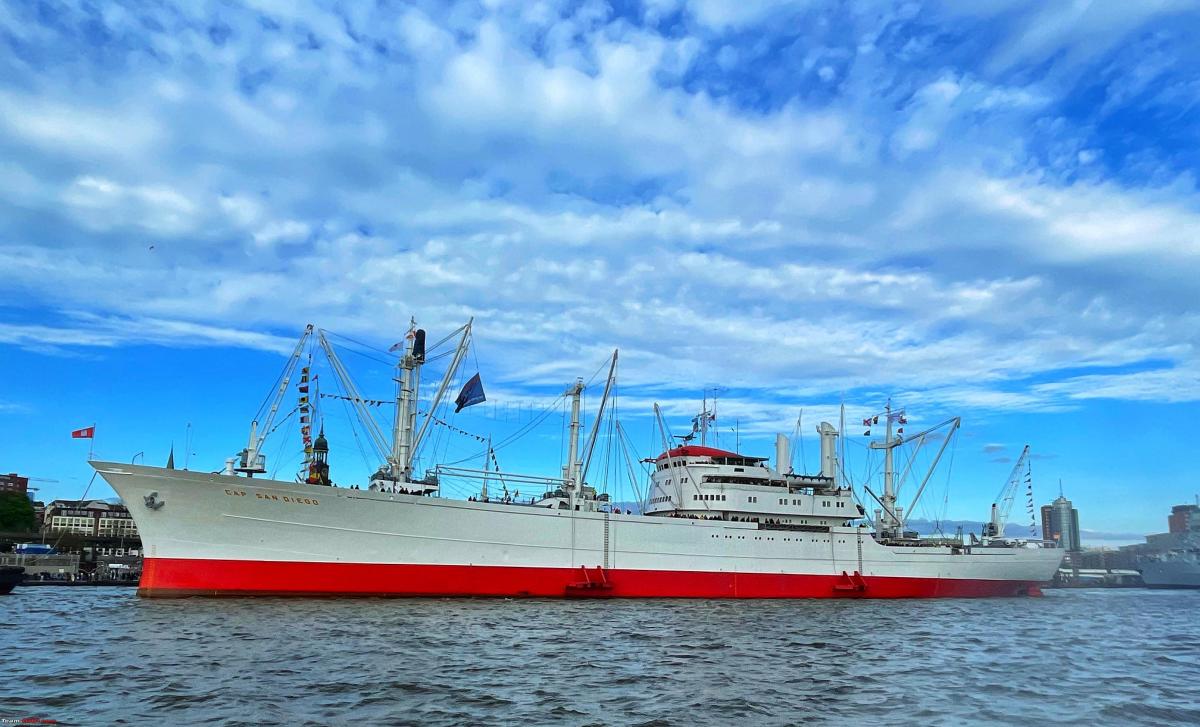
Before we start the tour a little more information on this magnificent general cargo ship. From various internet sources and the (German) brochure from the museum.
MS Cap San Diego is a general cargo ship, situated as a museum ship in Hamburg, Germany. Notable for her elegant silhouette, she was the last of a series of six ships known as the White Swans of the South Atlantic and marked the apex of German-built general cargo ships before the advent of the container ship and the decline of Germany's heavy industry. Next to (general) cargo she also carried a small number of passengers.
The Cap San Diego was built and launched by Deutsche Werft in 1961 for Hamburg Süd as the last of a series of six ships. The 159 m, 10000 dwt ship ran a regular schedule between Germany and South America, completing 120 round trips until 1981. After being sold and running under different names and under Spanish flags and also flags of convenience as a tramp trader, the run-down ship was scheduled for scrapping in 1986 when she was bought by the city of Hamburg.
The ship was restored mainly by the labour of enthusiasts and laid-off dock workers and is kept operational to date. Most of the time, the Cap San Diego is moored at the port of Hamburg where visitors can access virtually all areas of the ship from the bridge to the engine. One of the cargo holds hosts temporary exhibitions. Passenger cabins can be booked for overnight stays. Several times a year, the ship leaves the harbour on her own power for trips mostly on the river Elbe or to Cuxhaven. In 2001, the ship was awarded the Maritime Heritage Award by the World Ship Trust, and in 2003 she was declared a protected item of cultural heritage under Hamburg law.
She is powered by a MAN K9Z 140 D two stroke crosshead engine, has nine cylinders and three turbochargers. The engine produces 11650 horsepower at 118 revolutions per minute. Giving her a top speed of well over 20 knots (about 38 kilometers an hour).
She is very similar to the first ship I ever sailed on, as an apprentice engineer as part of my training; The Nedlloyd Florida. Same size, same engine power, same cargo hold configuration, age etc. So this really brings back many memories.
Just a photograph of the brochure will show you some of the details. Unfortunately, all in German. Ze Germans are still a little behind in providing their brochures, or website for that matter, in English.
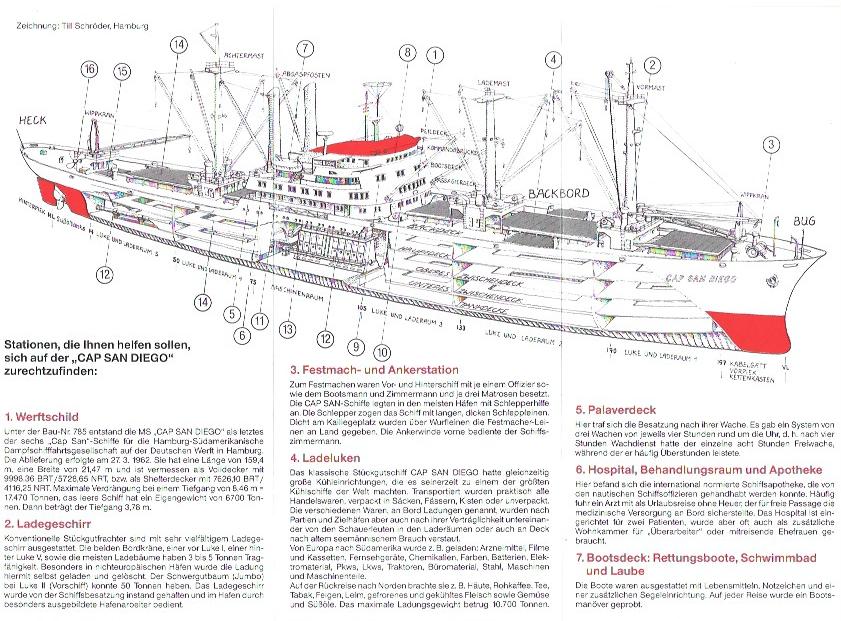
I had booked this trip many months ago and had been really looking forward to it. I spend three days in Hamburg, but the highlight of my stay was definitely sailing and touring on the Cap San Diego.
As you would expect from a former Merchant Navy Chief Engineer and nerdy techy, I will focus heavily on various technical parts of the ship. We were allowed on the ship around 12.00am with sailing scheduled for 13.00pm. First thing I did was head for the engine room, obviously!!
On most of these sorts of ships, you enter the engine room from above. There is a little platform above the main engine. It gives you a good view of the top of the engine.
You are looking at the forward four cylinder heads and two of the turbochargers. Those huge pipes going into the center of the cylinder head are the fuel lines going to the injectors.

Here we are facing aft, on the cylinder head deck. Notice the size of this engine and its component in relation to the engineer!

Just to get your perspective on the size of this main engine. Here is a little drawing that will visualise it, I hope.

This engine has a height of almost 10 meters, a length of almost 16 meters and is 4 meters wide. It weighs more than 500 tonnes!
So this is a BIG engine even by today's standards. Not as big as a modern ship's two-stroke diesels, but nevertheless, still very impressive. Let's look at some details.
Here is a close up of one of the turbochargers
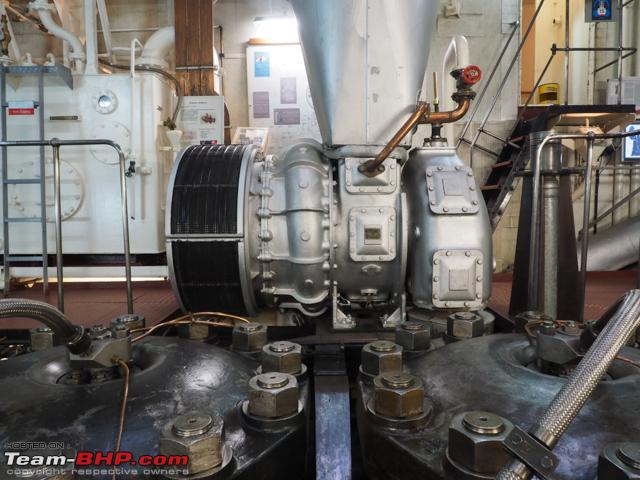
Here you see, what sits inside the turbocharger. It is one shaft with on the left a Jet turbine wheel on which the exhaust gasses are directed. On the other (right hand) end of the shaft a compressor wheel to compress inlet air for the engine.

Ships carry spares of everything. And they are bolted down all over the engine room. Here is one of the cylinder liners. You can see the scavenging airports on the side of the liner. This is a two-stroke diesel with only scavenging ports. The engine on the NedLloyd Florida has inlet ports and outlet valves. Having outlet valves instead of outlet ports allows for better airflow (scavenging) of the cylinder.
A cylinder liner like this easily weighs several tonnes. During my career, I have pulled several of these for maintenance and for repair. We had to do this once, in the middle of the ocean, with pretty heavy seas. Not an easy job, with such a huge lump of heavy metal swinging from the crane!

Each cylinder has its own cylinder head. Here you see it, with its lifting frame attached.
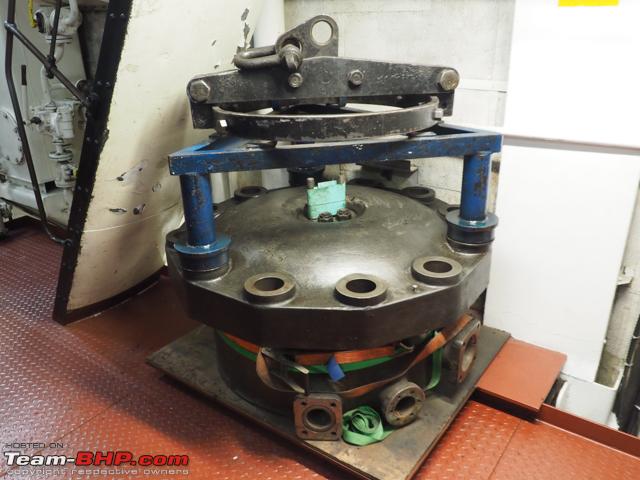
Here you see some other spare parts. Well, these would not be used as spares, the are cut-away parts to show the guests how they work.
The bit in the front is a fuel injector and behind it are some, I believe, air starter valves. They would carry a large number of fuel injectors and parts to overhaul each injector too. We would carry several sets. Overhauling an individual injector could easily take several hours. So you would pull the old injector, put a new one in and overhaul the old one later.

Let’s explore this huge engine some more. Just underneath the cylinder head deck, you will find on the port side the high fuel pressure pumps.
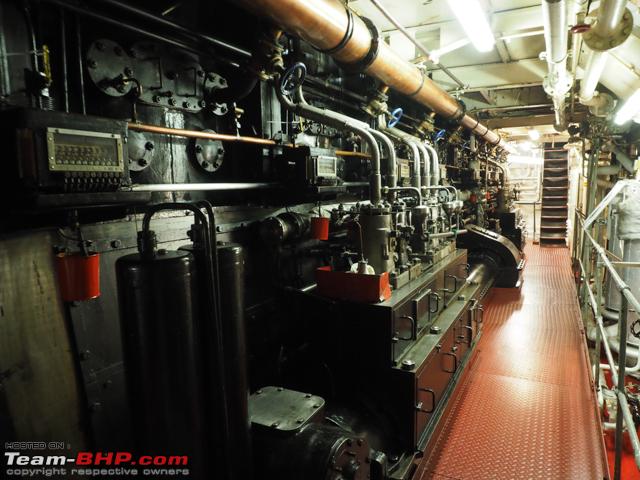
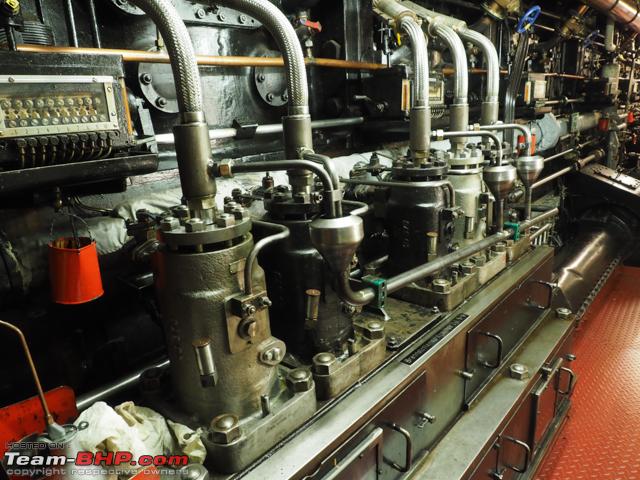
Also, the cylinder lubricators are positioned along the engine here. Each cylinder liner has a dedicated lubrication device. It was the responsibility of the duty engineer to check they were working correctly. If not, you would very quickly have some major problems. I know, I once had to fly out from home on quick notice to go a fix an engine that had run without cylinder lubrication. We had to replace all pistons and all liners!
It is driven by a crank mechanism on the right. On the left is a manual crank. Prior to the first start of the engine, the engineer and or oilers would give it a number of terms. This would ensure the cylinder liner would have some lubrication oil on its first start too.
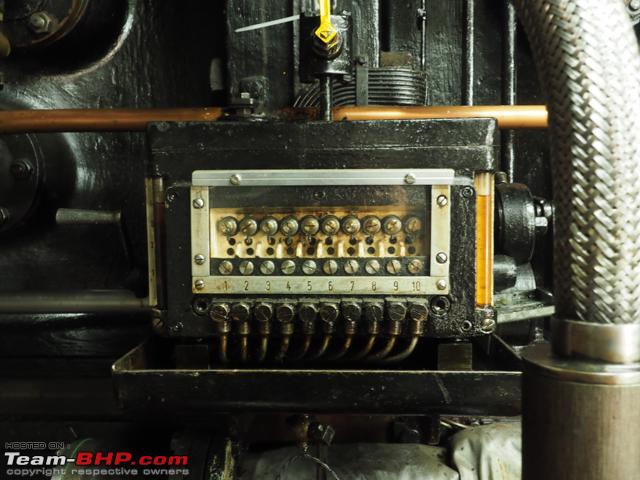
This is the manoeuvring position. These ships had manned engine rooms. The bridge would give signals to the engine room staff by means of a so-called telegraph. The engineer on duty would acknowledge the signal and start/run the engine accordingly. These large two-stroke engines are coupled directly to the propellor. They can turn two ways. So to go from ahead to astern or vice verse, the engine had to be stopped and started in the other direction. All done with these handwheels you see here.
Usually, the telegraph and the engine controls had some sort of interlocking mechanism. Just to prevent starting in the incorrect direction.
During manoeuvring there would be a number of staff in the engine room. The chief engineer and at least one duty engineer. There would be several oilers walking around too. Usually, one of them would be dedicated to keep the air pressure vessels full. These engines start by means of compressed air. So there are a couple of massive compressors to fill two huge pressure vessels up to 30 bars. No automation, you have to keep an eye on the pressure gauge and switch the compressors on/off by hand. Drain condensate etc.

Main engine control and alarm panel
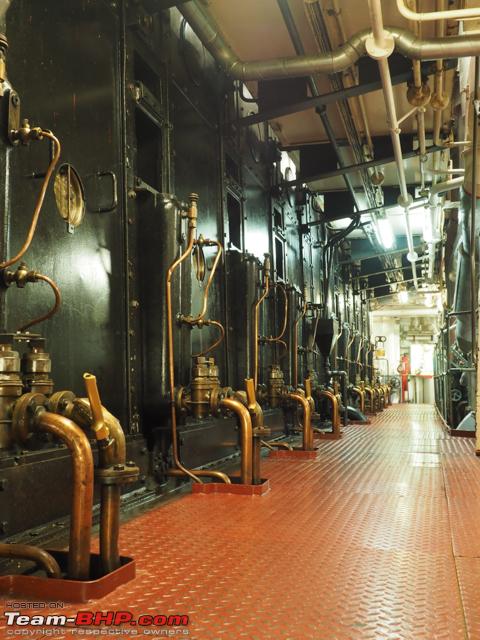
Most engine rooms are kept clean. I mean meticulously clean. But the Cap San Diego engine room gave new meaning to a clean engine room. I spend several hours in the engine room and I did not have a spot of oil on me. Not even on my hands, which keep touching the various hand rails as I go up and down endless stairs. Look at this!!! Somebody has put a lot of elbow grease into getting it to look like this!
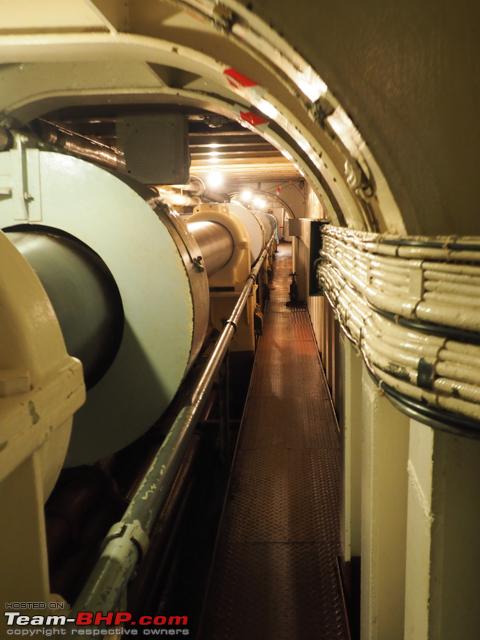
The business end of the engine. This is the propellor shaft and the, what else, so called propellor tunnel. The shaft is connected directly to the engine and the propellor. It runs, very smoothly in a number of bearings.

Apart from the main engine, an engine room is always full of all kinds of machinery and endless pipes, valves, filters and all kinds of technical stuff.
Valves and often pipe flanges are painted in different colour, so they can be easily identified. E.g. green means seawater, blue means fresh water, yellow means lubrication etc etc.



Next to the Main Engine, she also has four auxiliary engines. These are Deutz V8M 536, 500 Horsepower, 514RPM. They each drive a 310 KW generator that provides 440V/60Hz.

They had an interesting piston from one of its aux engines on display. It says (In German) this piston has run too long!!
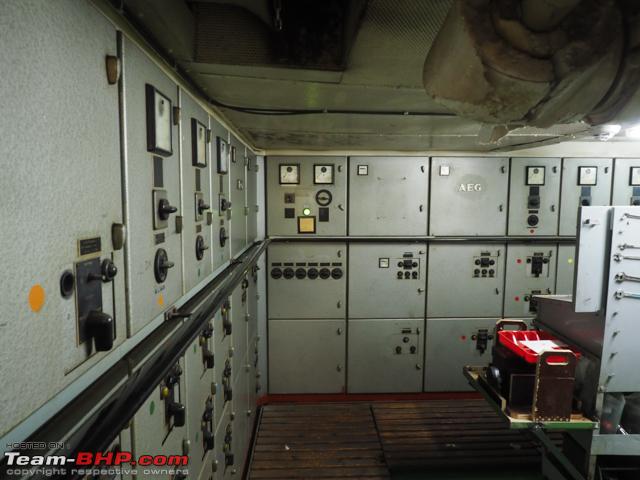
And of course various electrical panels. Most vessels have a three-phase, 440V, 60Hz system. Other power requirements (such as 220V/50 Hz) are derived from this. The reason is partly historical. When you start with 440Hz/60Hz, it is also easy to use 380V. At 60Hz electrical motors can run at higher RPM, (relatively).

Most of these sort of vessels will have a boiler for various purposes. That could be a basic as to provide heating to the cabins, or to heat (heavy) fuel, or cargo (more later). The Cap San Diego had a pretty decent boiler in the engine room.

Continue reading about Jeroen's tour for BHPian comments, insights and more information.
- Tags:
- Indian
- Cargo Ships
- Boats and Ships
News
Sailing fans on Team-BHP share their experiences
Last spring I took more lessons and passed the USA sailing exam for small boats. Some 80 questions, and some practicals too.
BHPian GutsyGibbon recently shared this with other enthusiasts.
I have always been in awe with the ocean, its power and the horizon. I took an introduction to sailing lesson as I failed at surfing. At 49 I am happy to stand up after taking a dump, popping up from a surfboard, and the balance seemed impossible. As an engineer, I instantly liked everything about sailing. Reading the elements, the wind direction, picking the right angle to tack, the language of the sailors, using physics to go faster - just about everything.
So, last spring I took more lessons and passed the USA sailing exam for small boats. Some 80 questions, and some practicals too. I then got a membership at a local Yacht club. I have now started taking friends and family with me, and I intend to share some of my sailing pictures here. These pics were from this past weekend.
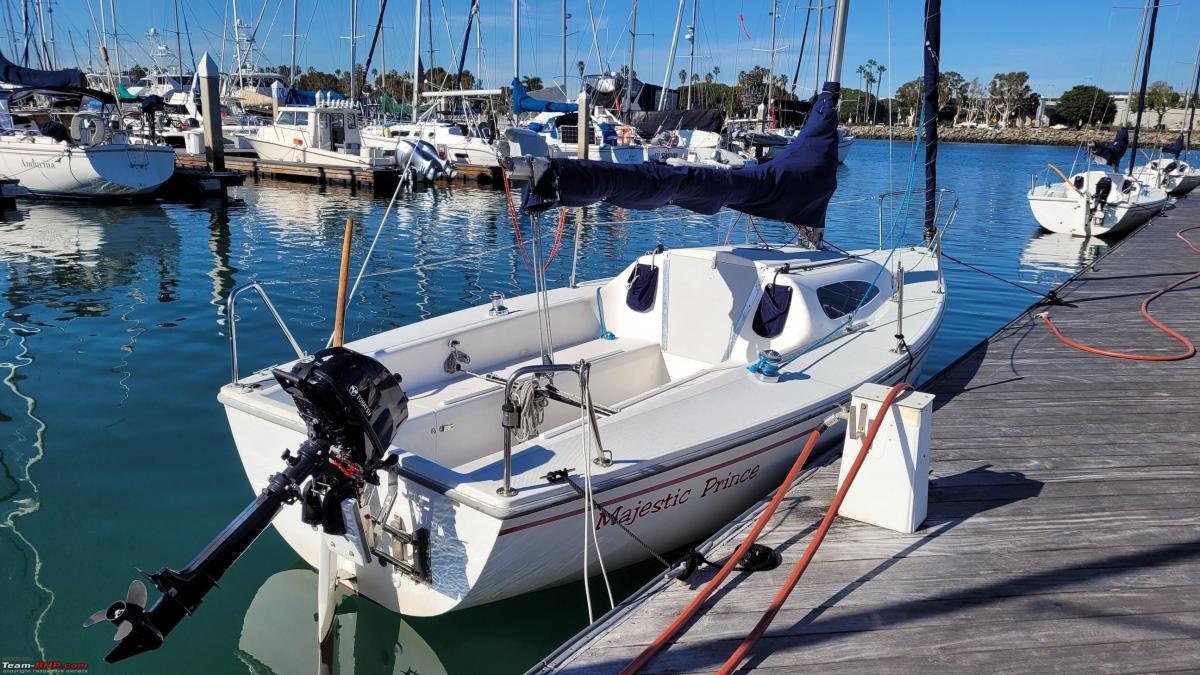
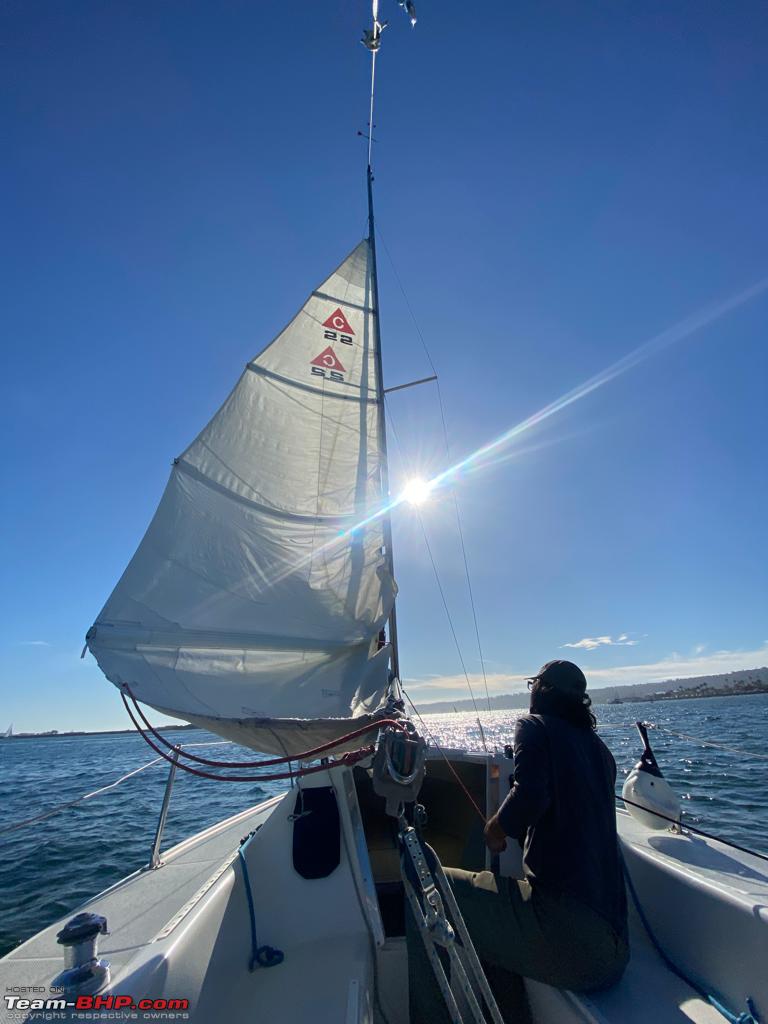
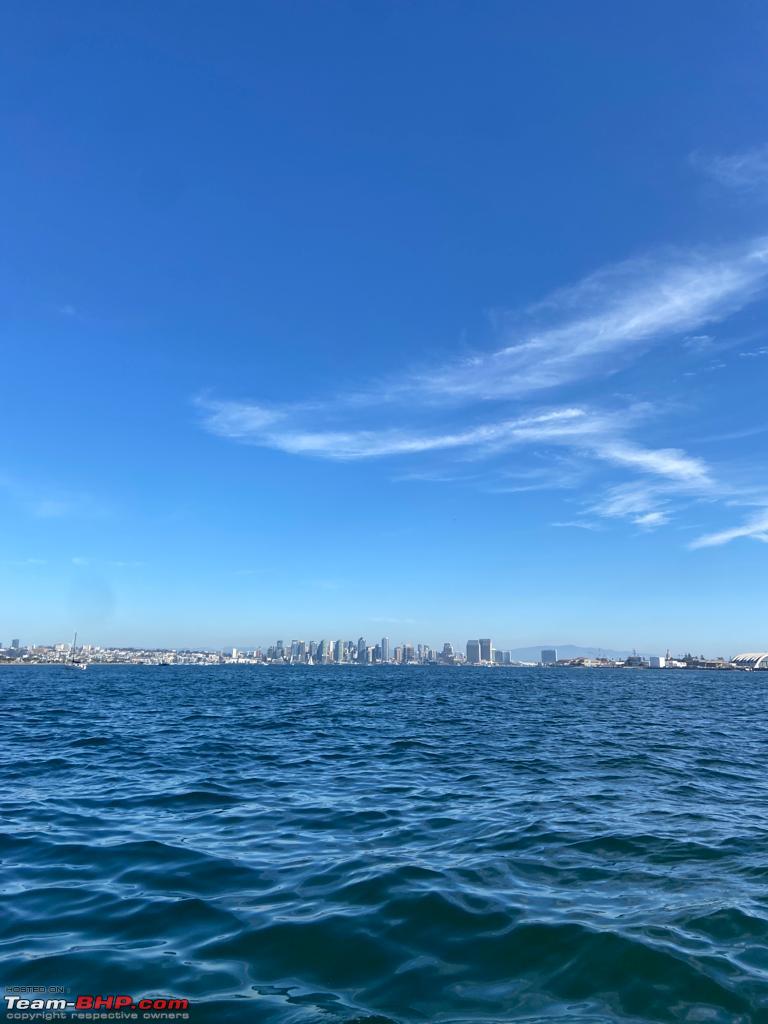
San Diego bay with the downtown skyline
If there are people who have considered sailing, and are sitting on the fence, jump right in. You may really like it.
Here's what BHPian shankar.balan had to say on the matter:
Oh lovely! What a fantastic hobby. Lovely pictures too. Somehow everything in that kind of light looks just so good! Happy that at least some of us are able to enjoy such things.
Sailing and related stuff used to be quite a ‘thing’ in old Cochin, Kottayam, Calcutta, Madras, Bombay and Vishakapatnam in India. But here in the protectionist years just like other things it became considered as ‘elitist’ and it is definitely expensive in terms of equipment and marina docking fees etc. The ‘waterfront culture’ is lacking in India unlike most other places in the world.Do you swim?
And do you own or rent your boat(s)?
Here's what BHPian Jeroen had to say on the matter:
Nice!
I have sailed my whole live. Living in the Netherlands with so much water around is everywhere that might not come as a surprise.
I started sailing and racing dinghies when I was about ten. These were mostly Dutch types, such as Vrijheid, Stern, Schakel. During my naval college years I sailed a OK dinghy. An international class that still exists. Quite the handful.
I have sailed on many yachts, here on the Northsea and channel, but also in the Caribbean. My wife is from Barbados and her dad used to quite a famous racing skipper in his time.
My brother in law is currently enroute from Texas (where he lives) to Barbados, singlehanded. He has done it a couple of times before. He has a lovely yacht.
Due to all my travels I haven’t owned a boat for quite some time. Luckily, we have lots of friends who do and I get invited often to crew. I am still looking at buying my own boat, but it will be a motorboat. Not sure if it will ever happen though. Lots of other things to do as well.
Take and enjoy your boat!
Jeroen
Here's what BHPian Theyota had to say on the matter:
Thanks to OP, I guess this was one of the few topics that was missing in this forum.
I lived 7 years near Beaufort, North Carolina which is a small town very well known among the sailing community in the east coast of the US. A colleague of mine, who owned a 36 feet Beneteau, used to live on it every weekend. He was very passionate and an adventurous sailor. He took me for a weekend sail once. While I enjoyed it very much, I thought it was a super boring thing to do every weekend just sailing around aimlessly or going on long passage just watching endless amount of water in the horizon at 5 knots if winds are good. You have to be a very good handy man in order to sail extended overnight trips. One needs to be a very good in his/her carpentry, plumbing, electrical and diesel engine fixing skills. The boats are a sinkhole for money, because there is always something to upgrade if you are passionate sailor. I think it is more fun to go on a day sail in smaller boat like yours. There are a lot of folks who sell off their homes after retirement and live permanently on a 40+ feet sail boat sailing around along the east coast and the Caribbean.
Another time I went on an 18 feet single outboard engine boat 35 miles into the see on a fishing trip with 3 other friends. The first hour speeding into the ocean through the choppy seas of an inlet at 5 am in the morning was scary as hell. This was my first and only time fishing. Once you reach where you want to want fish, you just cruise around aimlessly looking for fish. In about 7 hours, we caught maybe 5 fish, 4 of them not edible or illegal to be fished, so had to be thrown back into water. So after spending 7 hours in the sea and burning a gazillion gallon of gas, we had one fish, about 30 cm long, to take home. For people who like to fish for recreation, it is not the amount of fish they catch, it is the whole process of fishing process that is therapeutic.
Here's what BHPian hazchem had to say on the matter:
I don't know about other cities, but in Mumbai sailing is quiet accessible and also not expensive. I pay around 10k a year in Membership fees and boat rental charges range from free to 150 rupees.
Yes, given the size of the city we should have a lot more boats. A marina would be nice. But my experience is that people in general are afraid of venturing out in the sea. Hence the lack of waterfront
Here's what BHPian Mad_Monkey had to say on the matter:
There are three Sailing clubs using the Gateway facilities:
- Royal Bombay Yacht Club (RBYC)
- Colaba Sailing Club (CSC)
- Bombay Sailing Association (BSA) based in Alibaug (Mandwa)
Joining the BSA and the CSC is pretty simple and straightforward and they both own a few Seabirds (type/class of sailboat) and have access to the numerous boats owned by the RBYC.
I have been into sailing for quite a few years and I own a J24.
Read BHPian comments for more insights and information.
- Tags:
- Indian
- Boats and Ships
- sailing
Pages



